Planning a 10-day Ireland itinerary using only public transport can be a pain in the backside… So, we’ve done all of the hard work for you!
We’ve spent 25+ years travelling around Ireland and the itinerary below leans on that experience and the many mistakes we made along the way!
In a nutshell, this 10-day itinerary:
- Has been meticulously planned for those only using public transport
- Has an hour-by-hour itinerary for each day to save you time/hassle
- Follows logical routes that take you to hidden gems, tourist favourites and great pubs and restaurants
Who this itinerary will suit
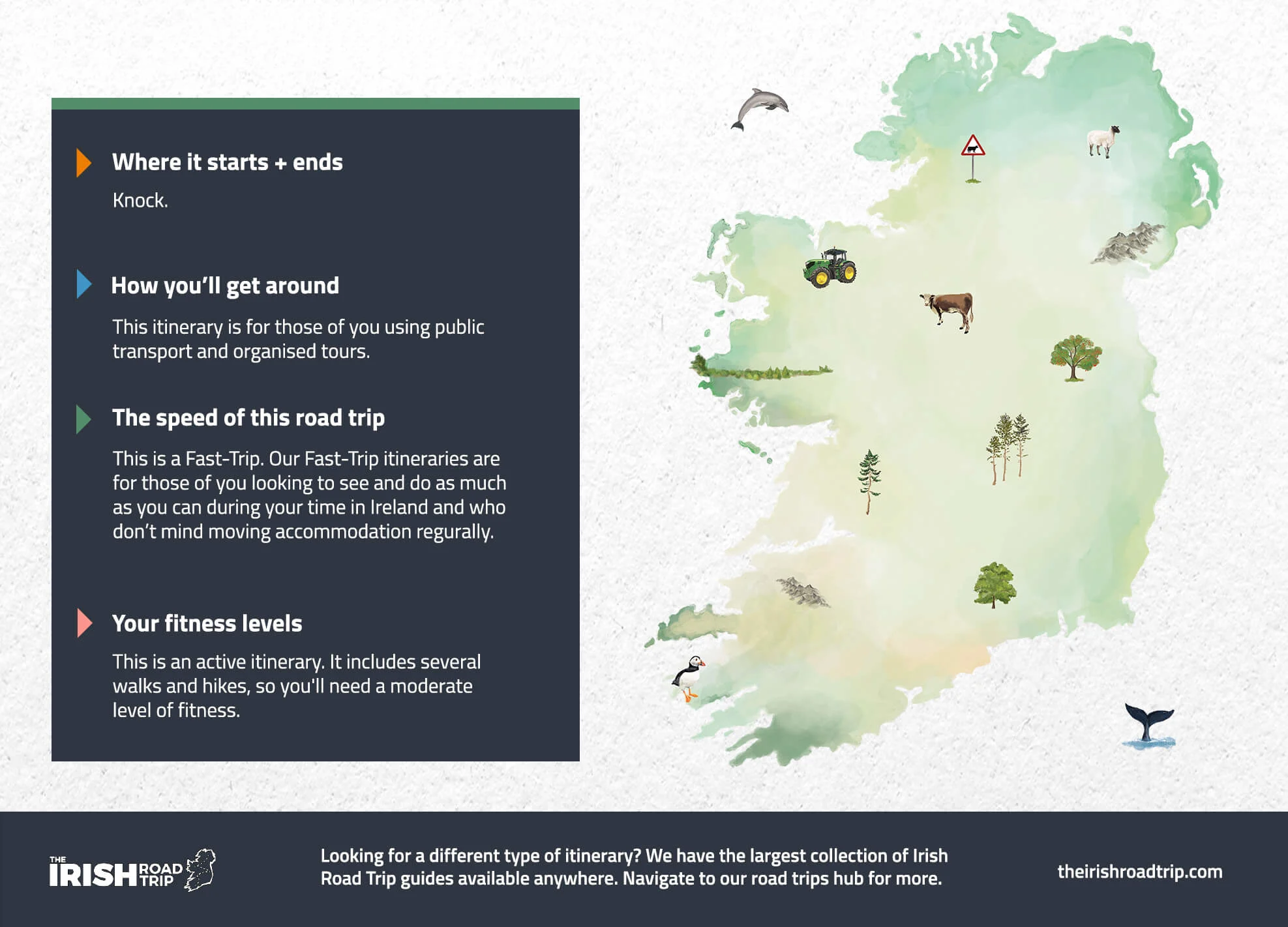
It’s important that you take a look at the graphic above as each of our road trip itineraries have been tailored to specific needs.
This road trip is specifically for those of you:
- Starting in/near Knock
- Using public transport and organised tours
- Looking to explore at a fast pace
- With a good level of fitness (i.e. it includes long walks and hikes)
- Remember, we have hundreds of different itineraries here if this one doesn’t suit you.
An overview of this itinerary
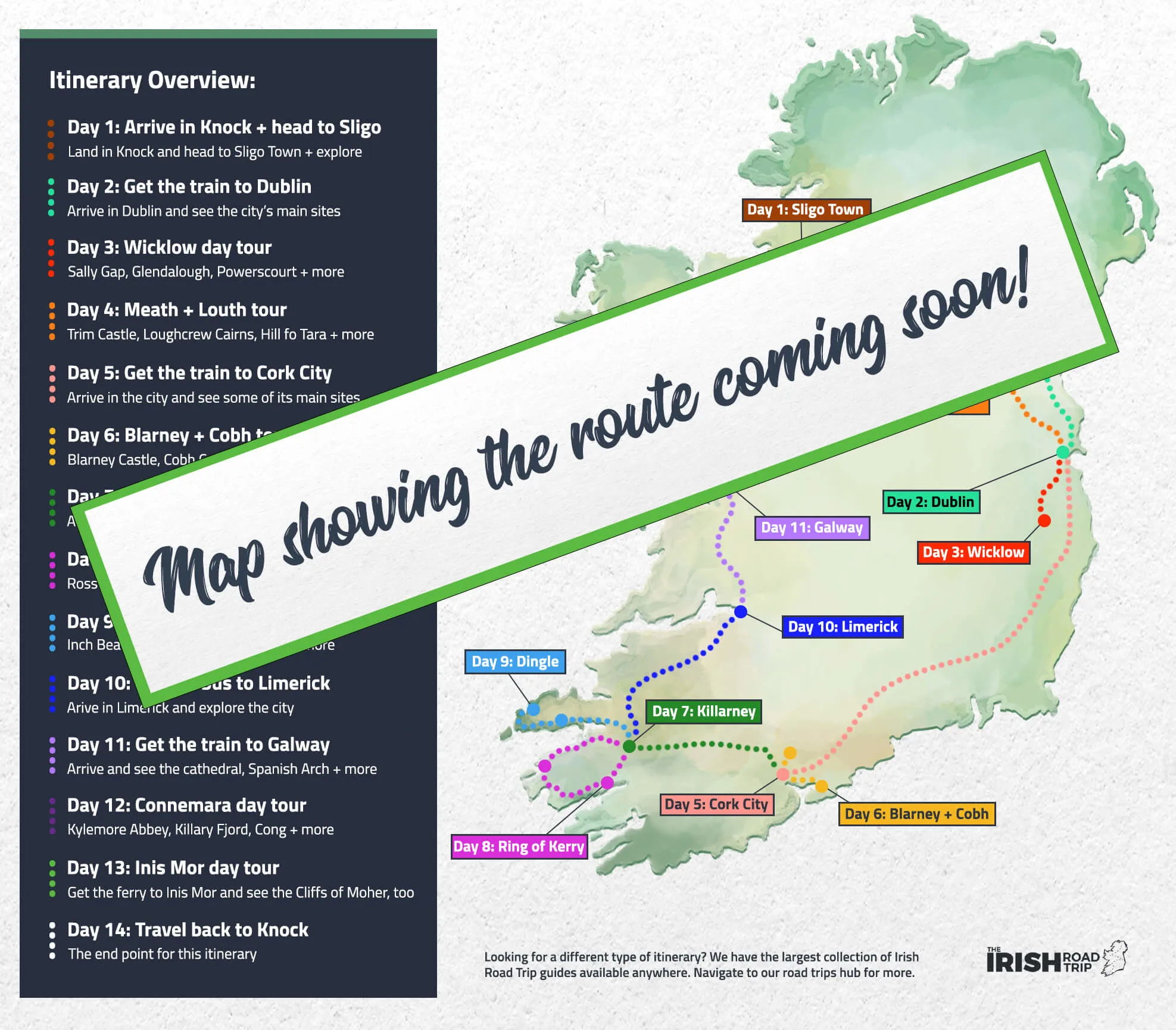
The map above gives you a very high-level overview of where this route will take you.
It uses several bases (e.g. Dublin for 4 nights) and provides you with day-long road trips you can head off on, so you avoid having to change accommodation constantly.
Now, I’ll stop rambling on – here’s a day-by-day insight into each of the days below!
Day 1: Sligo Town
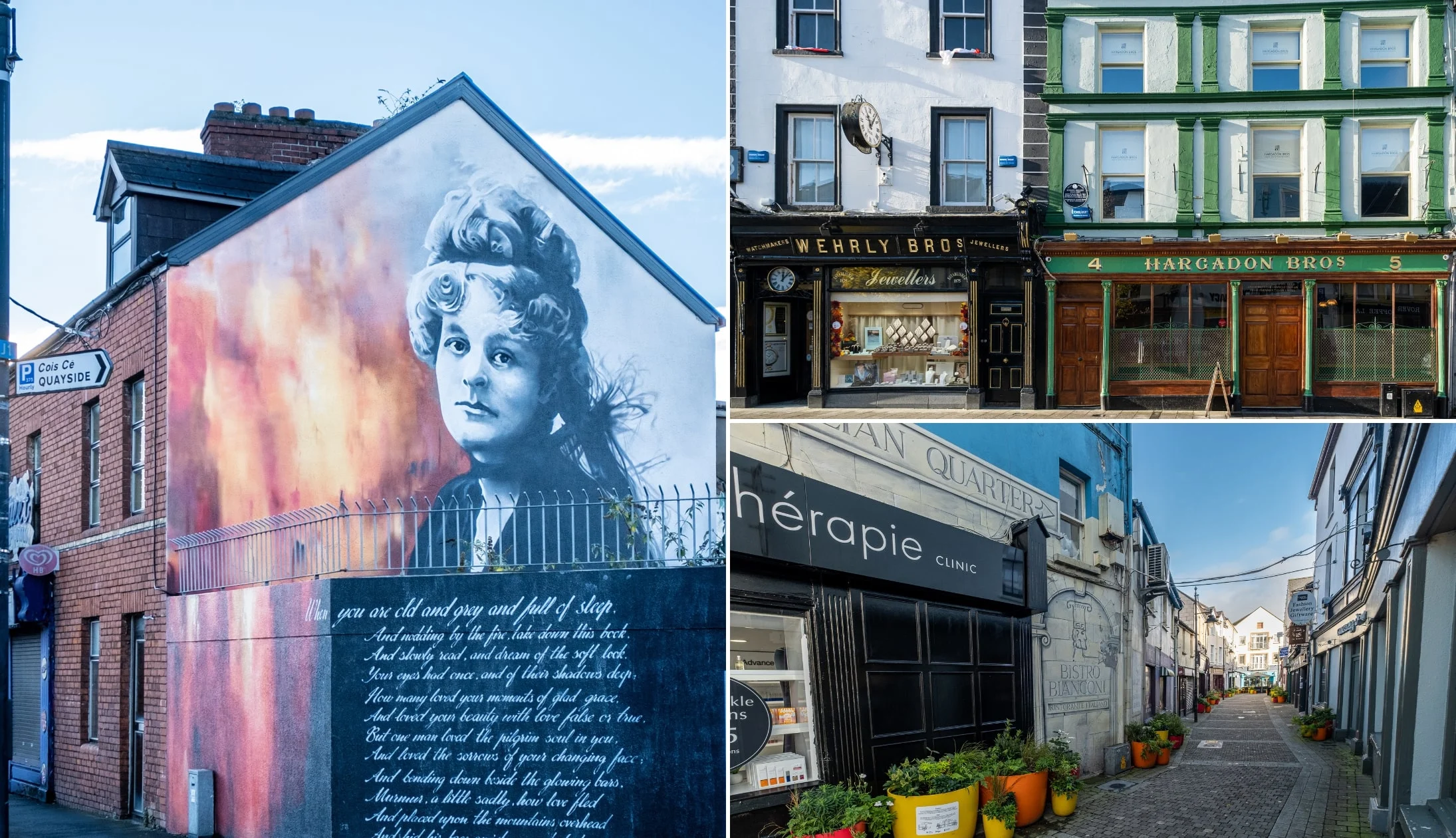
Photos courtesy Eddie Lee/Ed Lee Photography via Failte Ireland
It’s day one, and welcome to Ireland! Today, you’re heading up to Sligo Town from Knock Airport, where you’ll be doing some exploring of Ireland’s gorgeous northwest coast. You’ll spend one night in Sligo before making your way to Dublin.
If you haven’t already got somewhere in mind to stay, we’ve made a list of our favourite hotels and B&Bs in Sligo town below!
Our Sligo accommodation recommendations
- Budget: Old Fort B&B (great reviews and a 7-minute spin from town) and Tranquility B&B (solid reviews and a 5-minute drive from town)
- Mid-range: Riverside Hotel (central with great reviews) and Sligo Southern Hotel (10-minute stroll into town and nice and comfy)
- Upper-range: The Glasshouse (right by the river in the town – close to everything) and the Clayton Hotel (5-minute drive to town with swimming pool)
Stop 1: The bus to Sligo
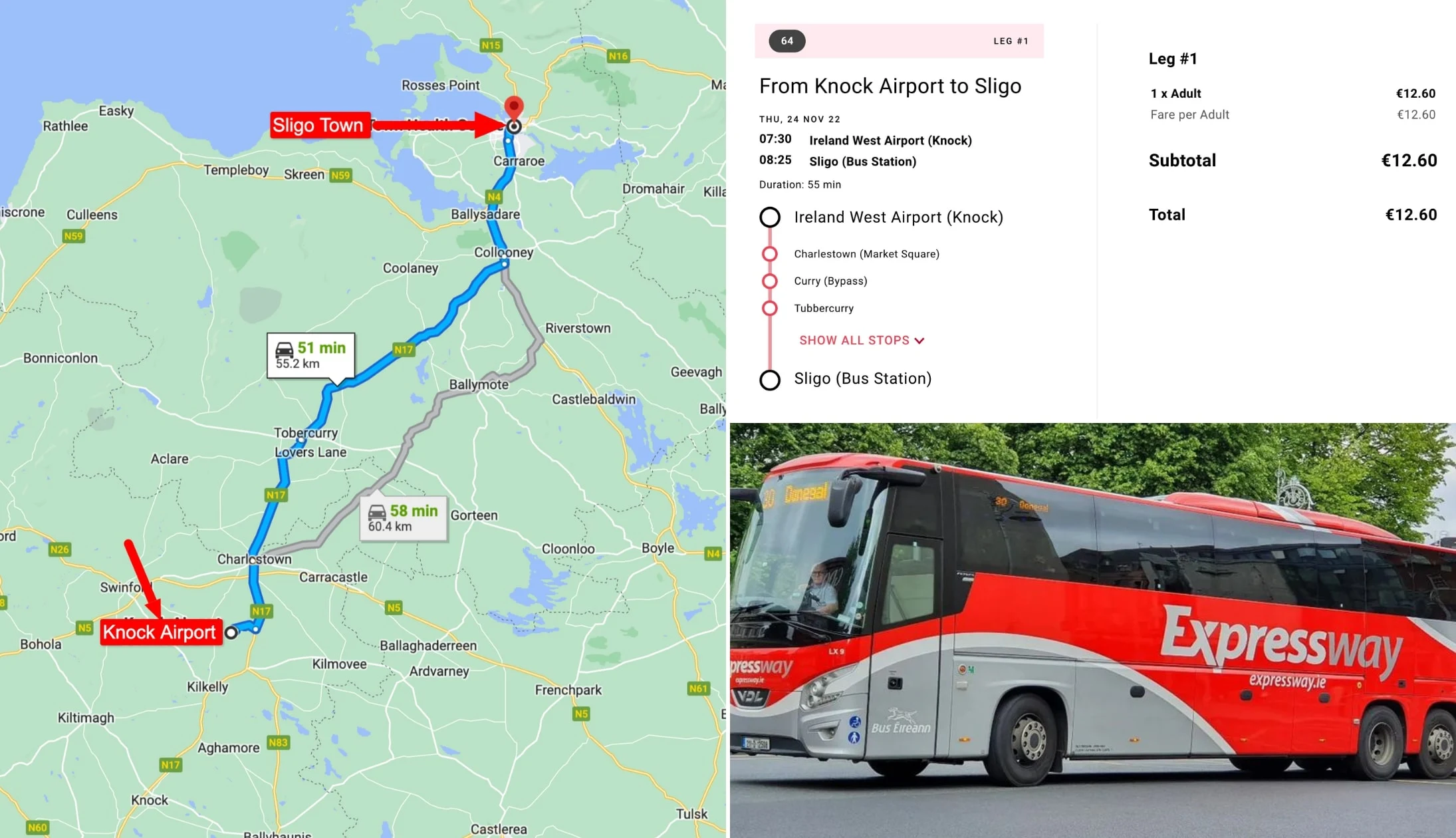
Photo left: Google Maps. Others via Expressway
You only have one option at Knock and that is to take the bus. Expressway operates an hourly service between the airport and Sligo Town as does Bus Eireann and Bus Feda. The journey takes around 1.5 hours.
Stop 2: Sligo Abbey
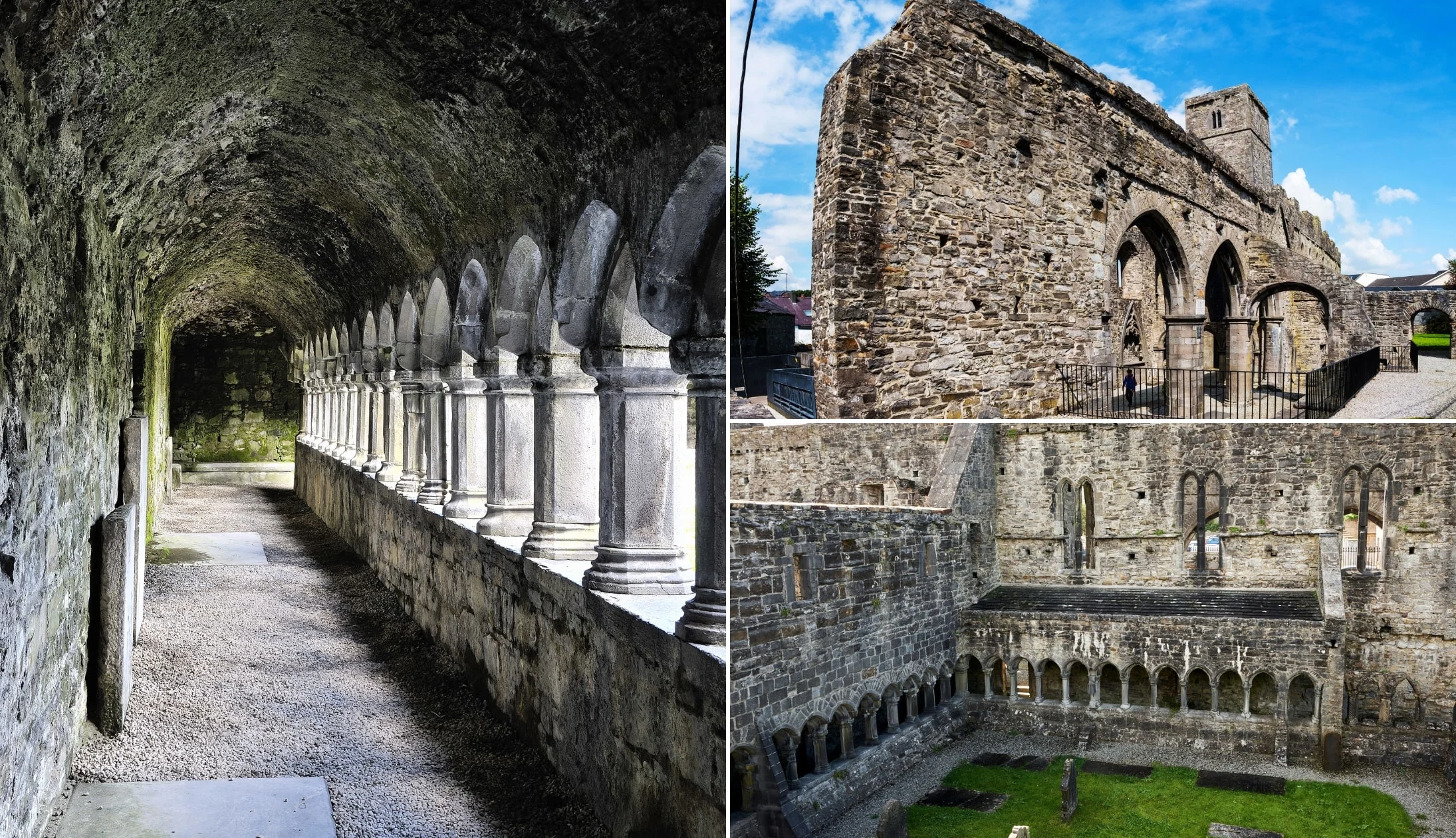
Photos via Shutterstock
Once you’ve arrived in Sligo, walk the 13 minutes over to Sligo Abbey. The Dominican friary dates back to the mid-13th century and was founded by Maurice FitzGerald, the founder of Sligo Town.
The abbey ruins are in great condition, considering they survived a fire in 1414, an attack during the ‘Nine Year War’ in 1595, and pillaging during the Rebellion of 1641. Legend has it that during the rebellion, the abbey’s silver bell was salvaged and thrown into nearby Lough Gill. Today, only those “pure of heart” can still hear the peal of the bell through the town…
Despite sustaining heavy damage, the abbey, which is a blend of Norman and Gothic architecture, still has beautiful carvings and monuments. For those interested in literature, the abbey was featured in two of W.B. Yeat’s poems – ‘The Curse of the Fires and of the Shadows’ and ‘The Crucifixion of the Outcast’.
Stop 3: Lunch
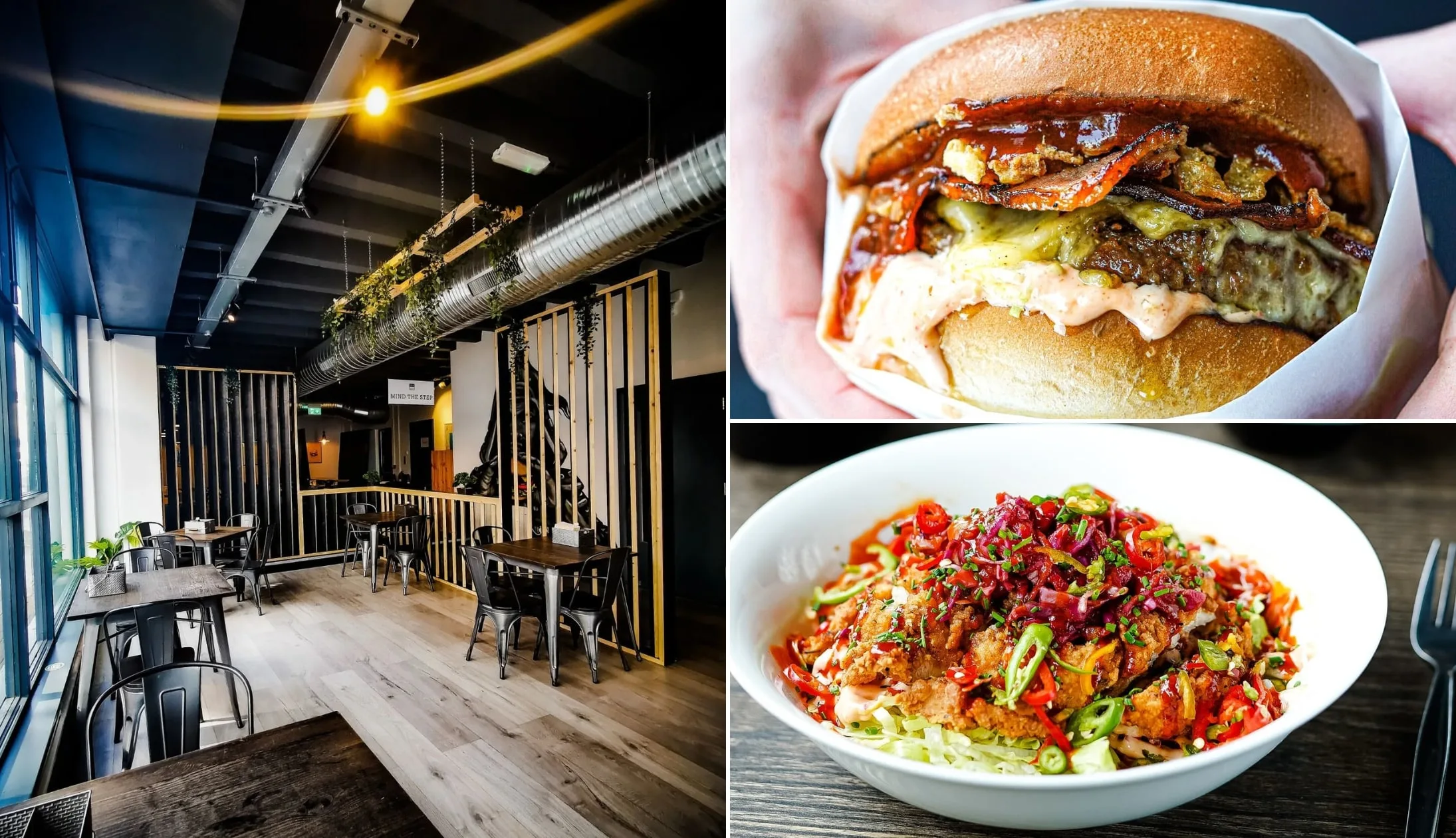
Photos via Flipside Sligo on FB
Our personal favourite lunch spot in Sligo is Hooked. Their brunch menu has Irish classics like beer-battered fish and chips and international dishes like the 12-Hour Slow Cooked Pork Belly Vietnamese Bahn Mi.
If Hooked doesn’t take your fancy, then we also recommend Lyons Cafe and Bakeshop (delicious home-cooked meals, light bites, and cakes) or Bridgefoot House (incredible open-faced sandwiches made with Irish soda bread).
Stop 4: Historic Walking Tour of Sligo Town

Photos courtesy Eddie Lee/Ed Lee Photography via Failte Ireland
If you’re up for a gentle walk, there’s a great signposted walking tour around Sligo that takes you to all the historical spots in this medieval town.
You can follow the gold arrows underfoot or pick up a map from the tourist office here. It’s a mostly flat 4.5km walk that takes most people around 1.5 hours.
Some town highlights the walk passes by are the Sligo town City Hall, a bronze W.B. Yeats statue, and the town’s sole surviving Medieval building.
Stop 5: The Model
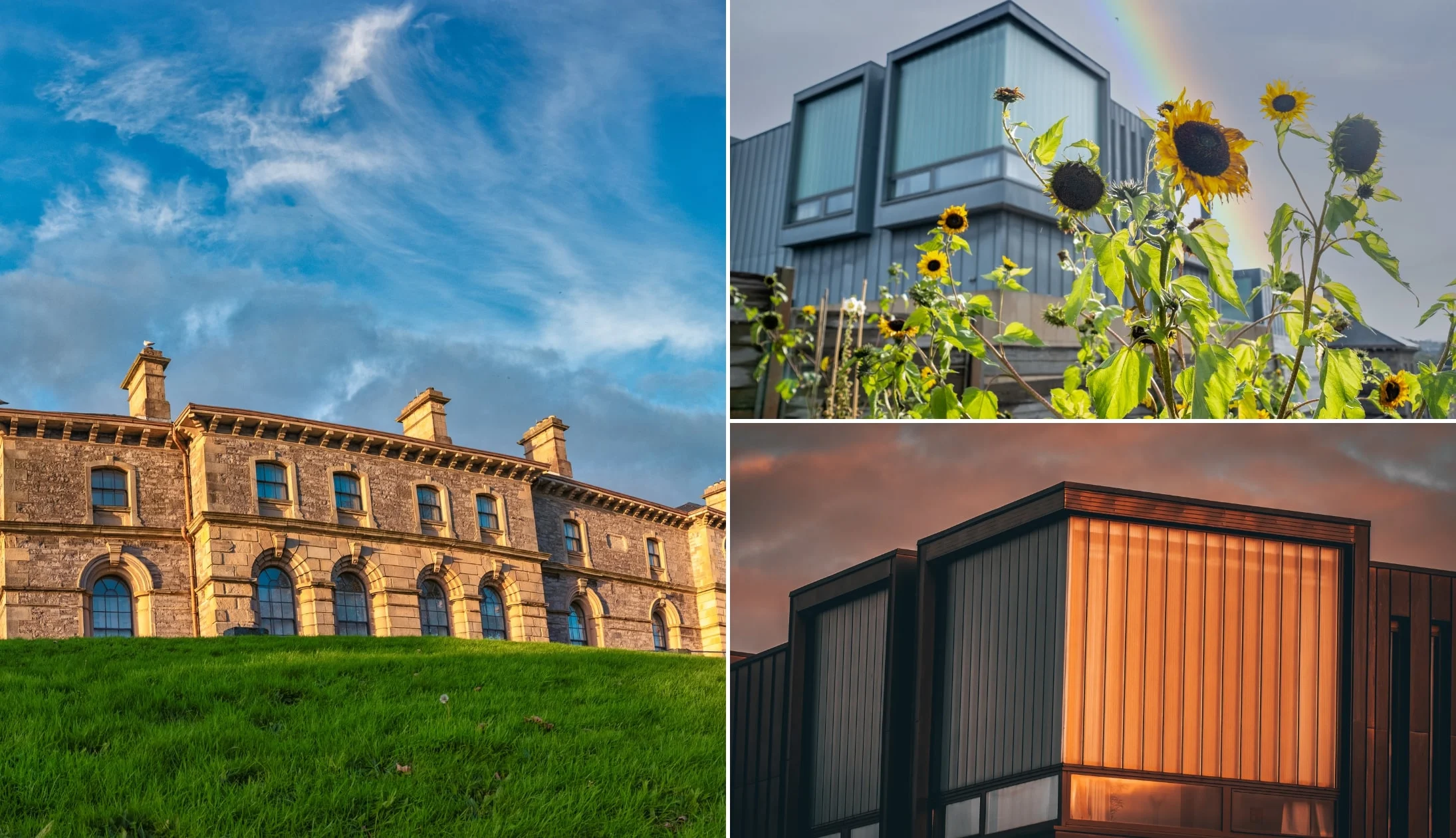
Photos courtesy Eddie Lee/Ed Lee Photography via Failte Ireland
Sligo is officially Yeats country, so it’s a great opportunity to learn about and see works by both brothers. The Model is a wonderful contemporary art gallery and centre in the heart of Sligo town.
It’s home to the Niland Collection (named after the librarian who founded the collection in the 1950s, Nora Niland), with over 300 works, including a significant collection of Yeats pieces.
‘A Political Meeting (In the West of Ireland’, ‘A Sunday Morning in Sligo’, and ‘An Island Man’ are just a few of the J.B. Yeats works in the collection. Each year, the gallery curates six exhibitions from the Niland Collection, with a heavy focus on the works of J.B. Yeats.
Stop 6: Yeats Society Sligo
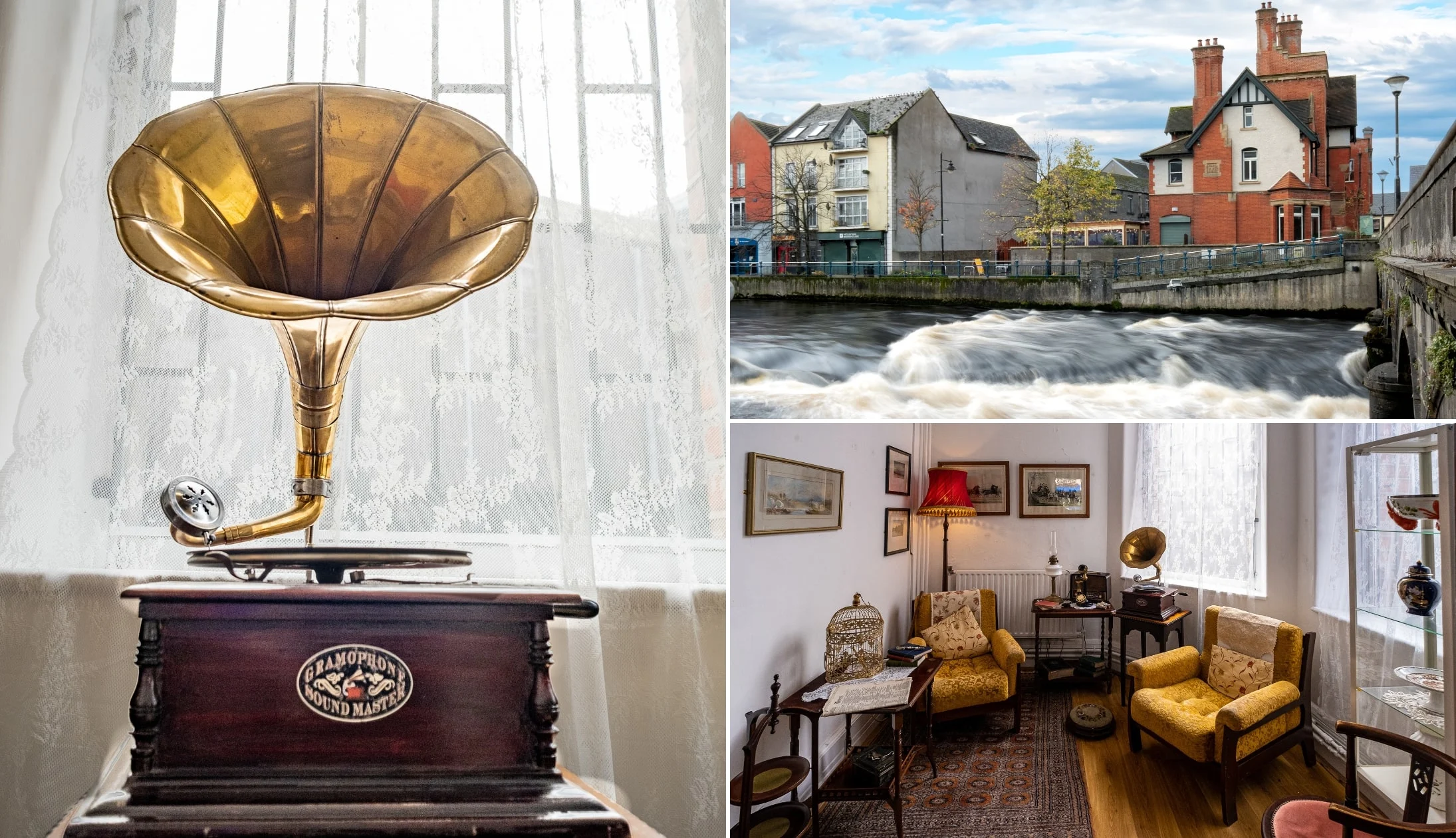
Photos courtesy Eddie Lee/Ed Lee Photography via Failte Ireland
To continue on with the Yeats theme, walk the five minutes to the Yeats Society Sligo. Inside the 120-year-old building, you’ll find a permanent Yeats exhibition as well as the Hyde Bridge Gallery, which is home to various contemporary exhibitions.
The Yeats exhibition is an ode to W.B. Yeat’s life, works, and family, with loads of interesting information and stories in the exhibition.
The society itself dates back to 1957 when a small group of dedicated Yeats fans decided to hold a Yeats Country Festival. The festival happened in May of the following year and was a great success. Following the festival, the group organised to meet every year in May, and thus the society was born!
Stop 7: Dinner, drinks and live music
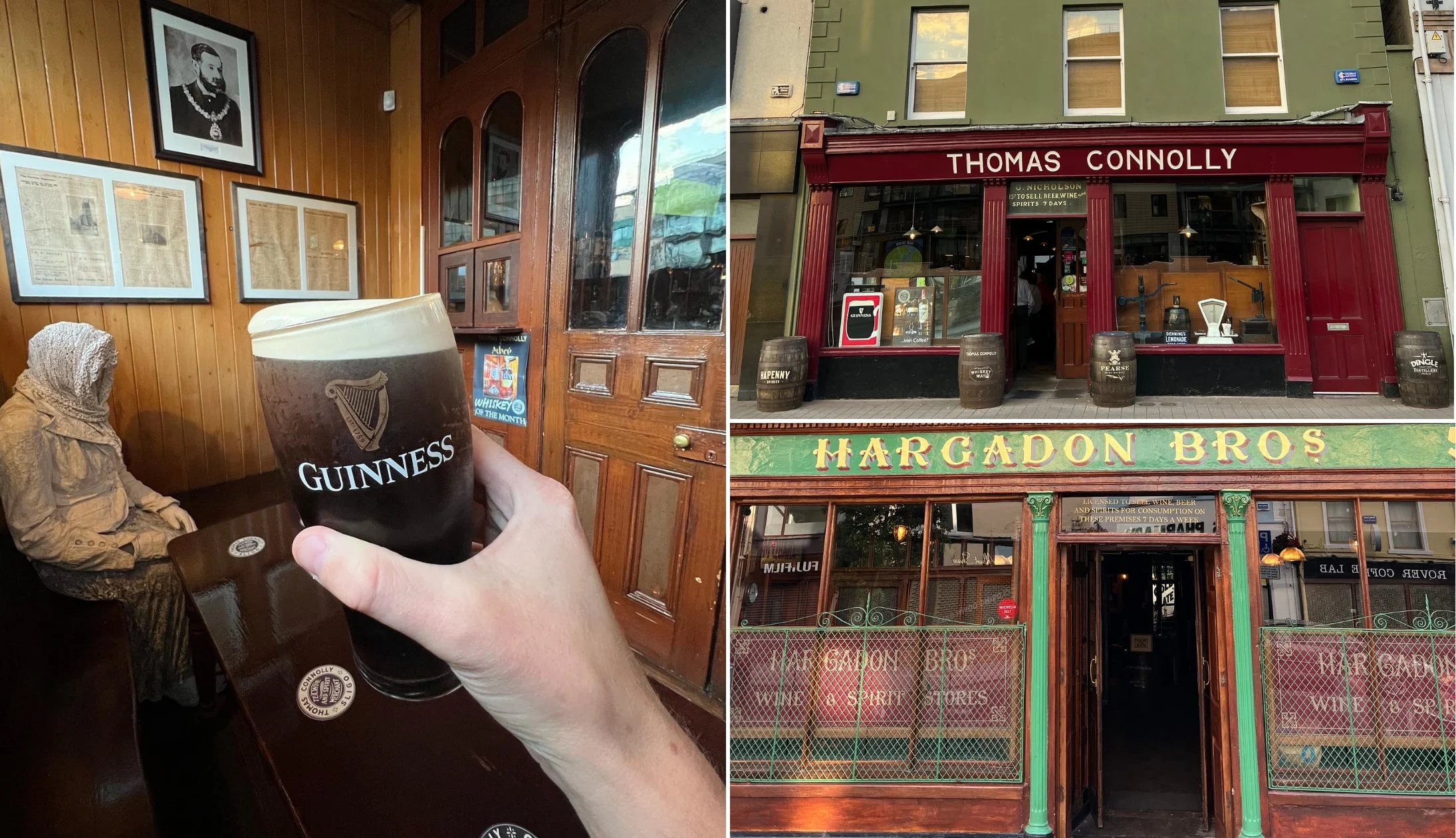
Photos by The Irish Road Trip
It’s time to wrap up your first day, and what a day it was! Head back to your hotel to freshen up, or go directly from the museum to grab some dinner. We’ve got some suggestions below.
Our Sligo food recommendations
Hopefully, you’re hungry as there’s some excellent restaurants in Sligo.
Head to Hooked for delicious Irish and international food made from local ingredients sourced from Sligo County. Some of our favourite dishes are the Sherlock of Tubbercurry’s prime beef steak sandwich and the buffalo chicken mac’n’cheese, but they also have some delicious vegan and vegetarian dishes.
For seafood and steaks, we love Coachlane. It’s a little on the pricey side, but their certified Irish Angus beef is worth the extra money. If steak isn’t your thing, their seafood platter is incredible, with salmon, scallops, crab claws, cod, monkfish, and shrimp.
Our Sligo pub recommendations
If you’re feeling like after dinner drinks, we suggest hitting up Hargadon Bros (a traditional Irish pub dating back to 1868), Thomas Connolly (a heritage Irish pub and the oldest in Sligo Town), and Shoot the Crows (a cosy and quirky traditional pub with a great pint of Guinness).
For a night of lively trad music, pass by McLynns Bar or Fureys Pub (or both!).
McLynns is in the heart of Sligo town on Old Market Street. The fourth-generation pub has been running since 1889, with live music (Irish folk, acoustic, and bluegrass) every weekend and on mid-week nights. The traditional interior will transport you back in time, with wooden furniture and historical decor.
Fureys Pub on Bridge Street is a cosy old-style pub with a great atmosphere, an open fire (great for those cold winter evenings), and live trad music on weekends and certain weekday nights.
Day 2: The train to Dublin
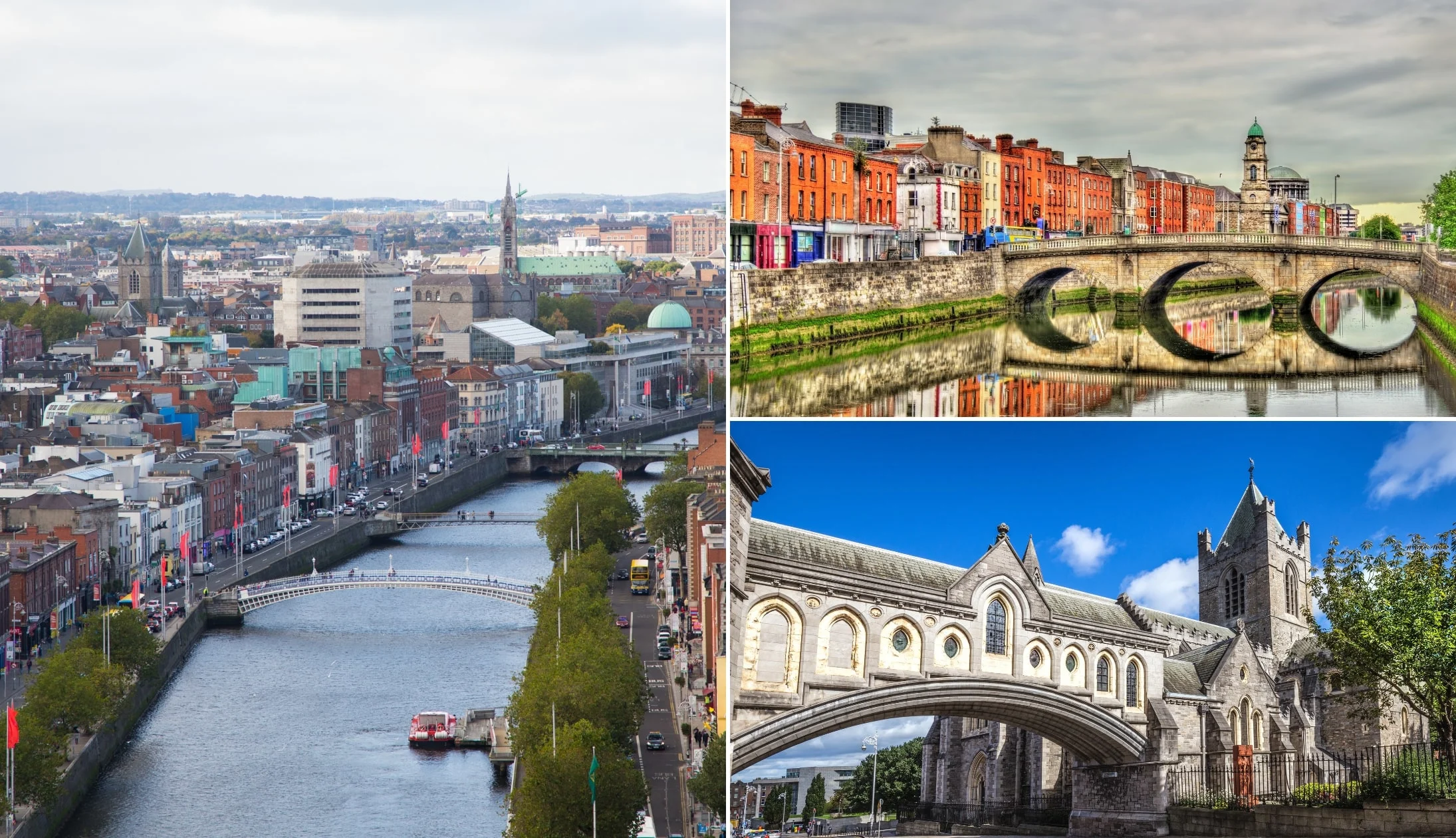
Photos via Shutterstock
On your second day in Ireland, you’ll be saying goodbye to Sligo and hopping on a train to Ireland’s lively capital, Dublin! You’ll be spending two nights here as you explore the city and nearby attractions.
Start the day with a hearty breakfast at your accommodation. Or if you want to have breakfast out, we recommend Margarets Cafe (a cosy spot with traditional Irish breakfast, french toast, and pancakes) or Lyons Cafe and Bakeshop (hearty cooked breakfasts and artisanal pastries).
We’ve got some recommendations on where to stay in Dublin below, so check them out if you don’t have anywhere in mind already:
Recommended accommodation in Dublin
- Budget: Abigail’s Hostel (Temple Bar), Jacobs Inn (central hostel) and the Generator Hostel (short walk from the city)
- Mid-range: Dublin Skylon Hotel (just outside the city), Wren Urban Nest (Temple Bar) and the Harding Hotel (very central)
- Luxury: The Merrion (St. Stephen’s Green – very central) and The Westin (just off Grafton Street)
Getting around Dublin + money savers
- Time savers: If you want to avoid walking where possible, it’s worth getting a ticket for the Hop On Hop Off Bus around Dublin. It goes to or near all of the main sites on this itinerary plus plenty more.
- Money saver: If you’re visiting the ‘main’ Dublin attractions, the Dublin Pass can save you €€€ (here’s how)
Stop 1: The train from Sligo to Dublin
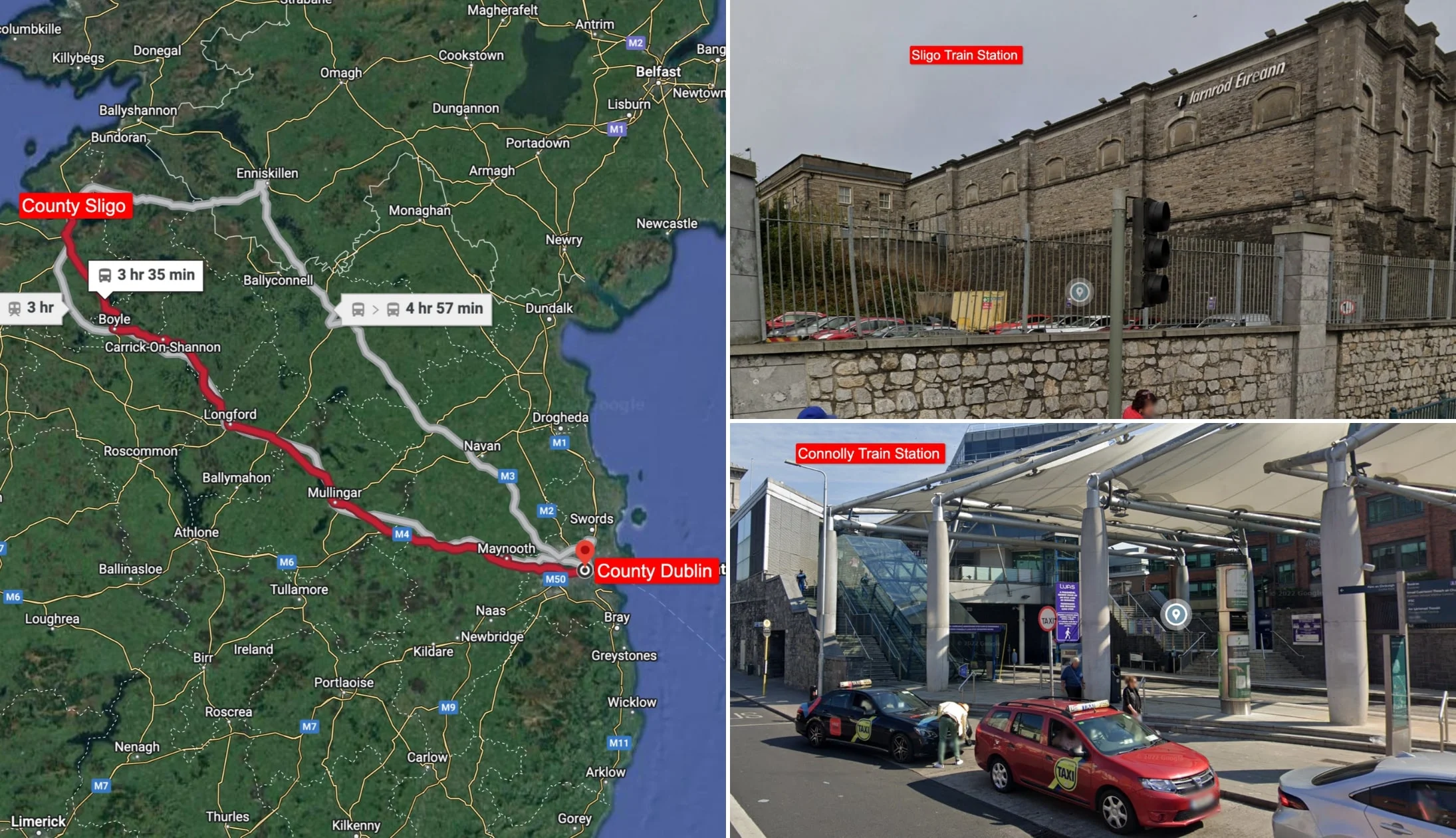
Photos via Shutterstock
The best way to get from Sligo to Dublin is by train. There are direct trains from Sligo to Dublin Connolly operating all day long and the trip takes around three hours.
Today, we have you heading to Trinity first, but depending on when you get in, you can head to lunch first and then Trinity as the lunch spots we have suggested are very close by.
Stop 2: Trinity
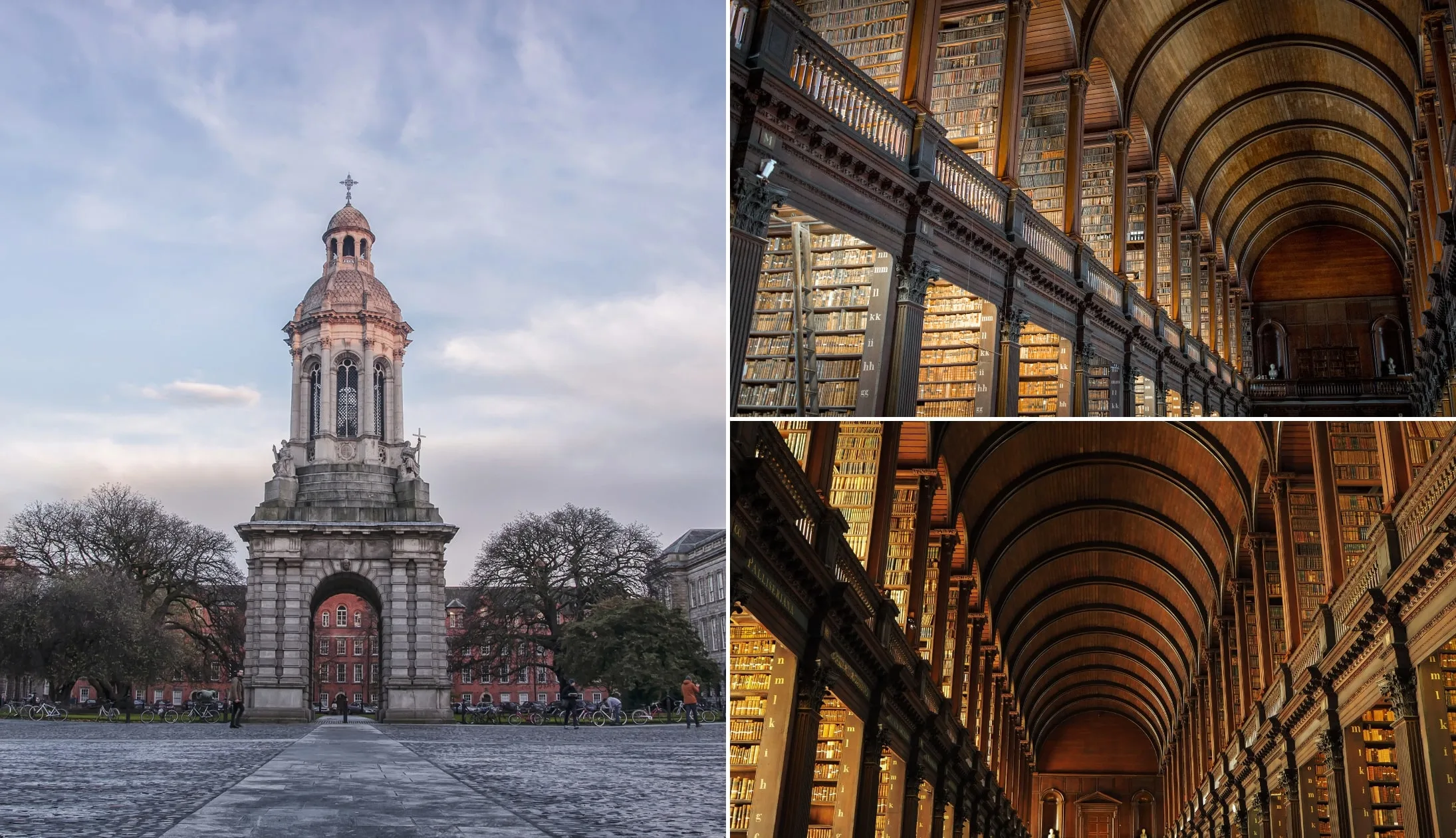
Photos via Shutterstock
Head straight to wherever you’re staying. Check-in and leave the car behind you. The city is very walkable.
When you get to the city, head straight for Trinity College to see the Book of Kells, arguably the most famous cultural attraction in Dublin.
If you can, we highly recommend pre-booking your tickets online, as the queues can get really long (bordering on ridiculous!). This fast-track ticket allows you to dodge the queue and gets you into Dublin Castle, too!
Spend around one hour seeing the Book of Kells, walking around the exhibit, and taking in the beauty of the Old Library. After that, give yourself another 20 minutes or so to walk around the university campus.
Stop 3: Lunch
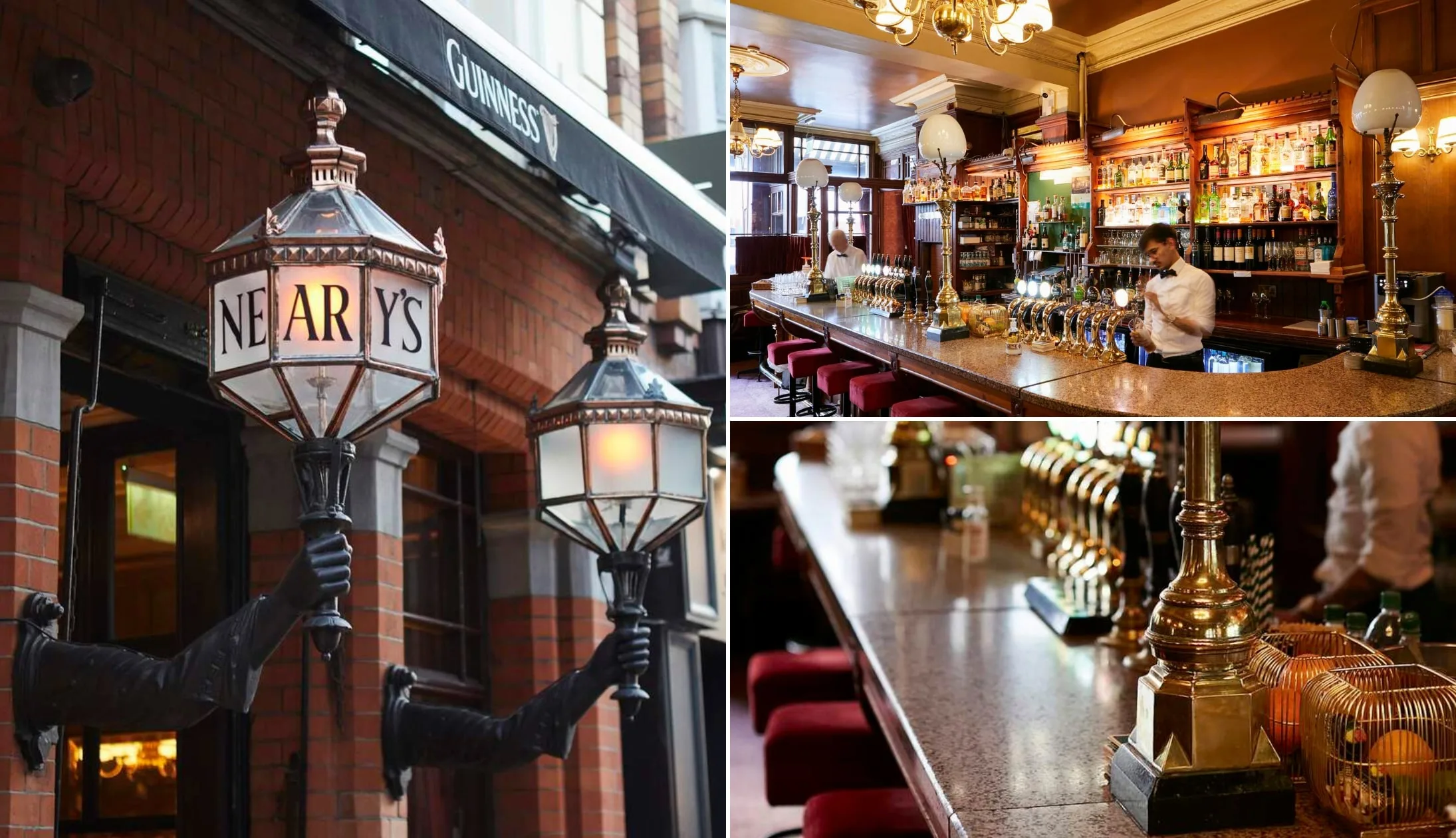
Photos © Tourism Ireland
There’s plenty of great restaurants in Dublin, but for lunch we suggest you head to Neary’s. It’s just up the road from Trinity College, along the bustling Grafton Street.
This old-school pub is a classic and it serves up a range of simple lunch options, like sandwiches, soup, toasties, and Carlingford Oysters, all washed down with a tasty pint of Guinness.
Affordable and delicious, we can’t recommend it highly enough. Sprout and Co on Dawson Street is another good shout for a quick, light lunch that tastes great and is close to Trinity College.
Stop 4: The Ha’penny Bridge (via Temple Bar)
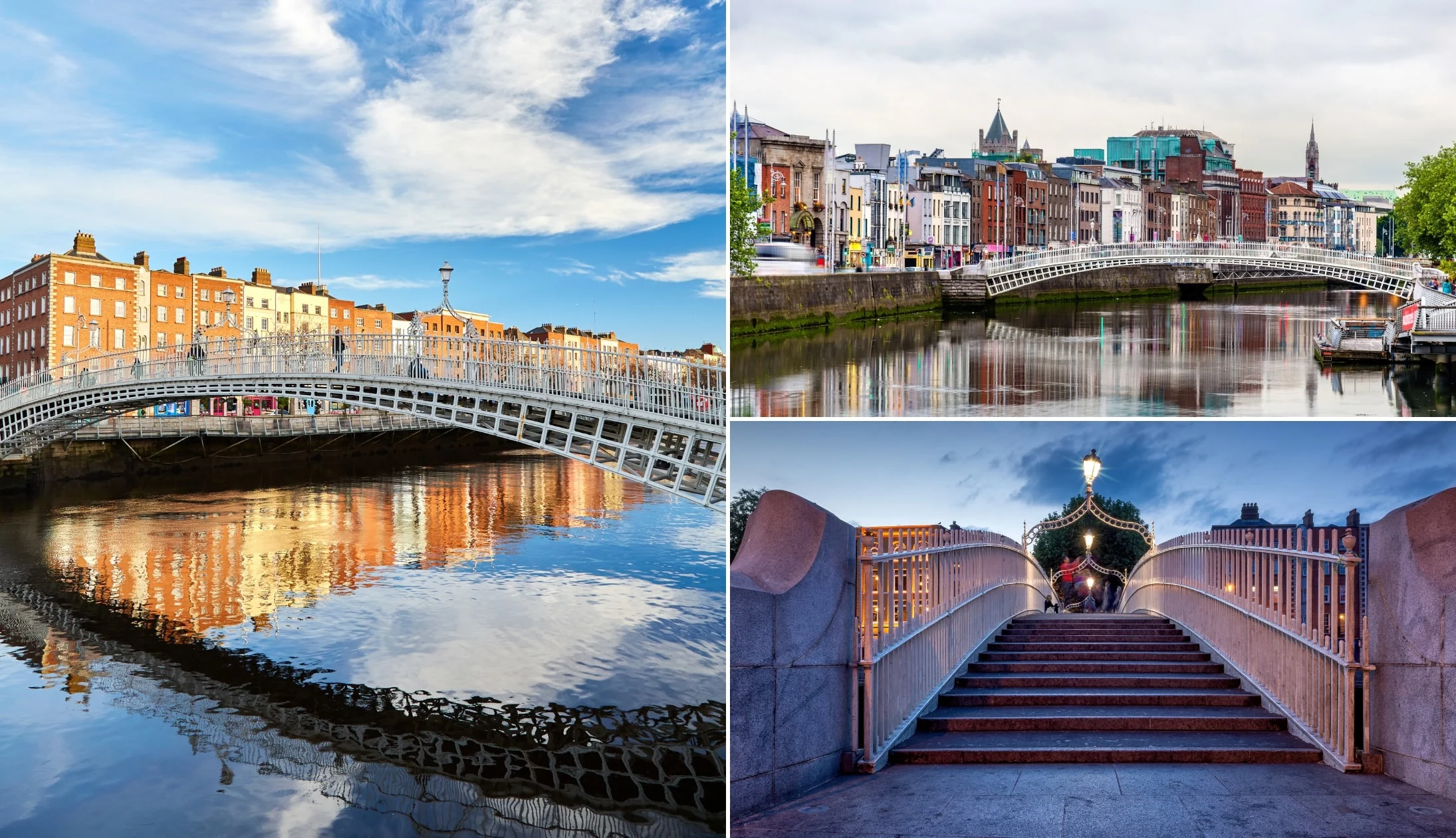
Photos via Shutterstock
The Ha’penny Bridge is an iconic sight in Dublin and crossing it is a must. From Neary’s, it’s about a ten-minute walk that passes through the vibrant Temple Bar area.
As you pass through Temple Bar, you’ll see why this is the nightlife capital of Dublin, with endless pubs and clubs lining the streets.
The bridge itself is a quaint little footbridge over the River Liffey. In the old days, you’d have to pay a toll of half a penny to cross, hence the name.
If you fancy a coffee after your walk, head to Vice Coffee Inc, just over the bridge for a superb brew. You’ll also find tons of shops and pubs to enjoy on either side of the bridge.
Stop 5: Dublin Castle
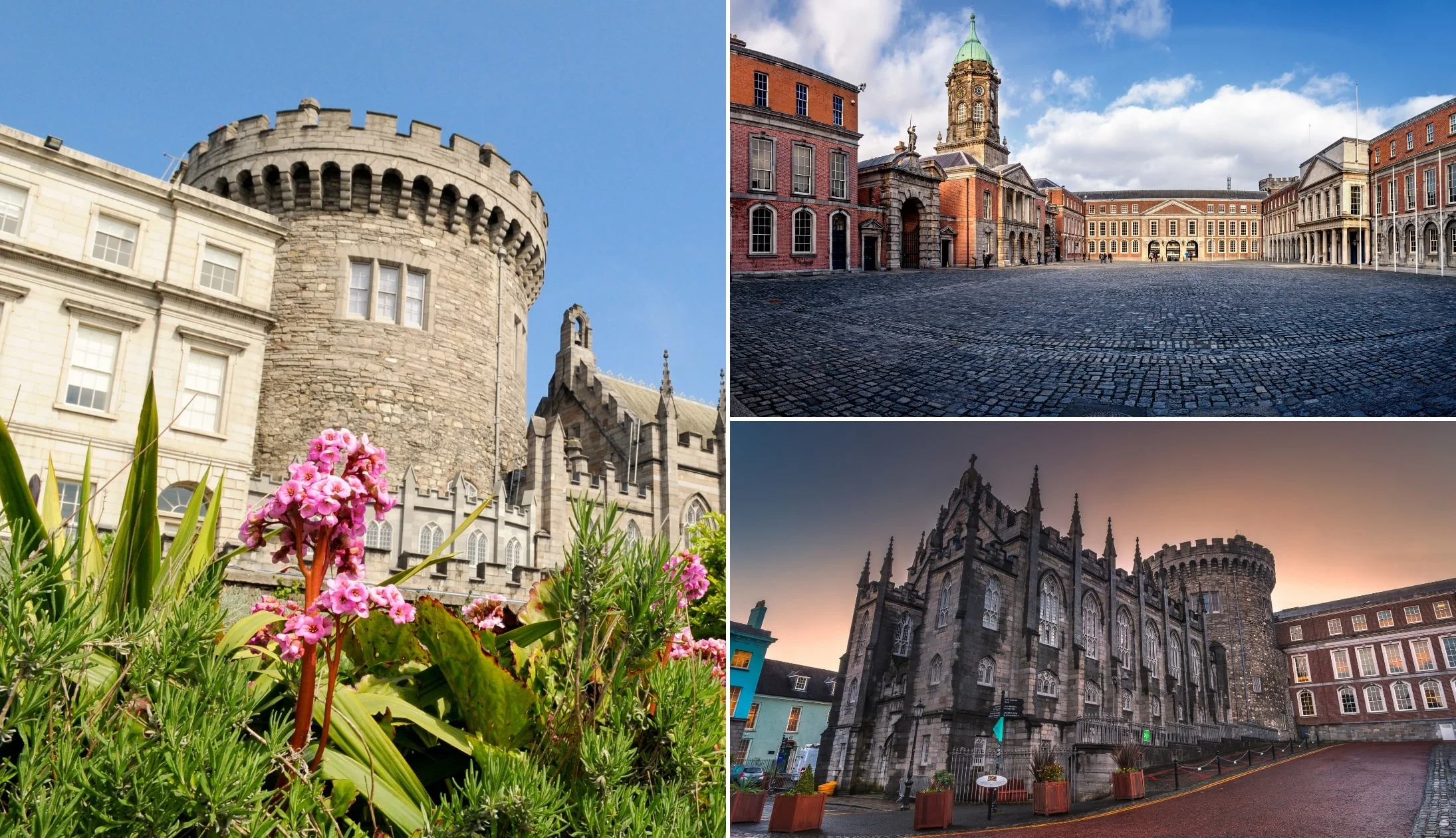
Photos via Shutterstock
Next on the itinerary is Dublin Castle. Nestled in the city centre, the castle dates back to the 13th century and was the seat of the English for over 700 years. Today, it’s an important government complex and the site of Presidential Inaugurations and key State events.
The castle is around 10 minutes from the Ha’penny Bridge on foot. There’s no admission fee to explore the grounds, but if you want to have a look inside, you’ll need to purchase tickets for either a self-guided tour or a guided tour.
Guided tours include access to the State Apartments, Exhibitions, Chapel Royal, and the Mediaeval Undercroft. Self-guided tours include access to the State Apartments and Exhibitions only.
Stop 6: Christ Church Cathedral
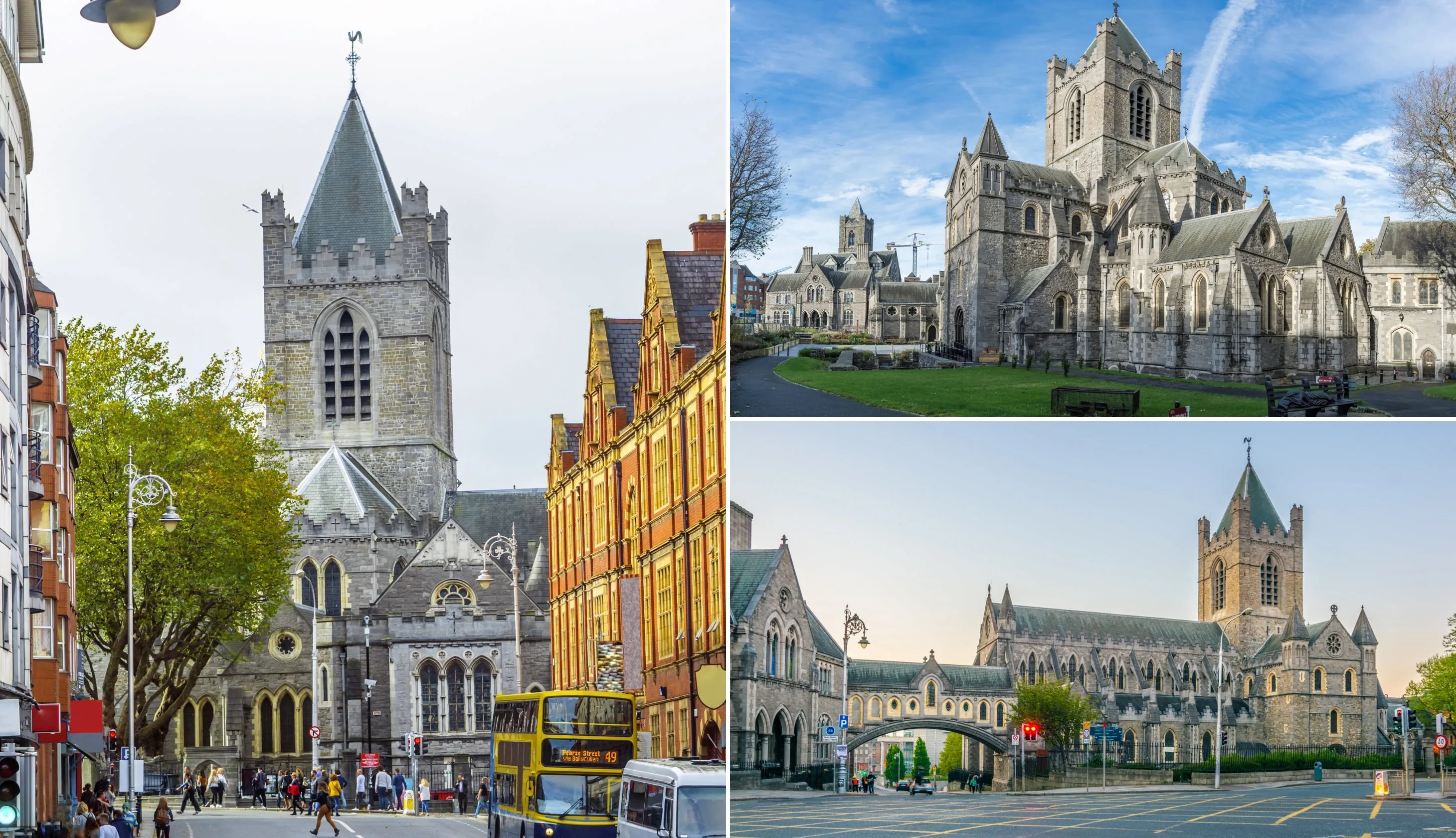
Photos via Shutterstock
Christ Church Cathedral (a 6-minute stroll from the castle) is another of Dublin’s top attractions and dating back more than 1,000 years, it’s pretty much as old as the city itself!
Steeped in history, it was originally founded by Viking king Sitruic Silkenbeard, but it’s come a long way since those early days (you can grab a ticket online here).
After admiring the stunning architecture from the outside, you can take a self-guided audio tour inside the cathedral.
Along the way, you’ll discover Strongbow’s grave and explore the crypts, which are home to a wealth of artefacts and exhibits, with such treasures as the mummified cat chasing a mummified rat inside an organ pipe.
Listen out for the record-breaking bells of Christ Church, and if you’re really lucky, you might catch the choir in action.
Stop 7: St. Audoen’s
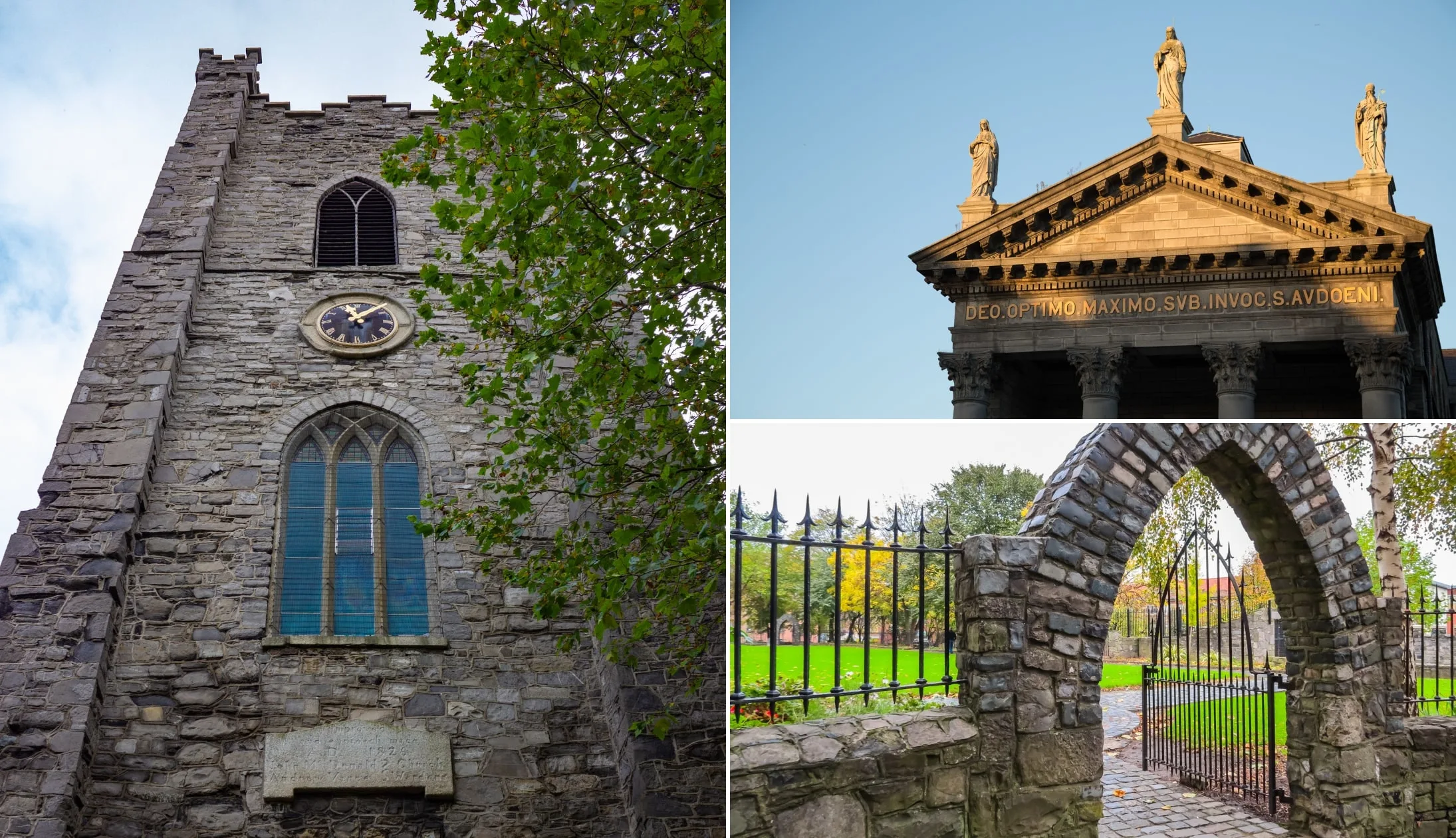
Photos via Shutterstock
St. Audoen’s is a short five-minute stroll from Christ Church Cathedral. The church dates back to 1190, making it the oldest Parish church in the city. However, parts of the church were added/restored at a later date, including the tower, which was damaged in 1596 following a huge gunpowder explosion nearby.
When you stop by, make sure to head to the main porch to have a look at the “Lucky Stone”, a late 9th-century gravestone that traders and merchants used to rub for good luck!
Stop 8: Guinness Storehouse
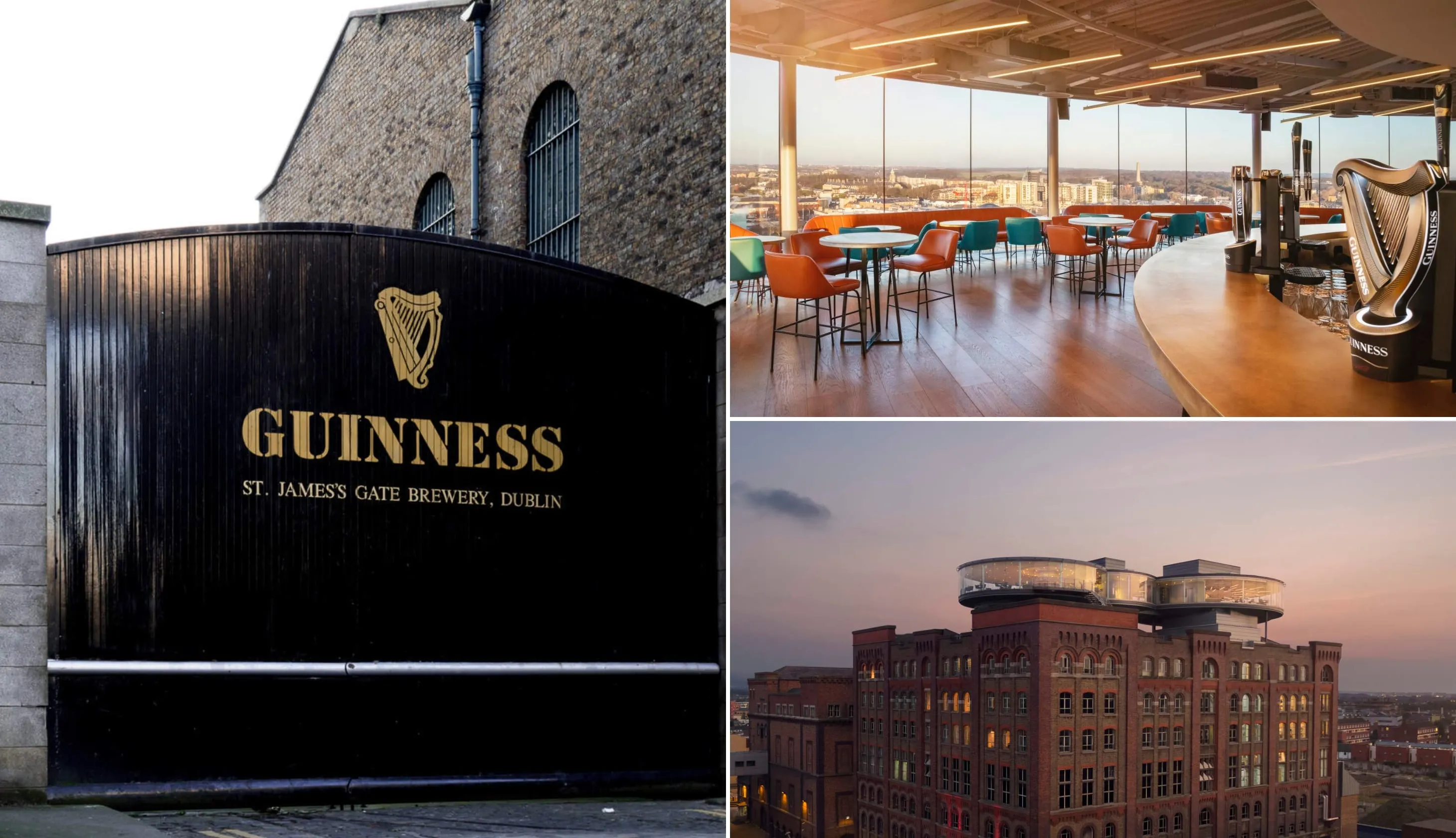
Photos © Diageo via Ireland’s Content Pool
Next up is another iconic Dublin attraction, the Guinness Storehouse, a 15-minute walk from the church. Dublin is the home of Guinness, and this tour of the brewery is a must for anyone with a love for the black stuff.
In fact, even if you’re not a fan of beer, this is a fantastic attraction to visit. Book your tickets in advance to avoid the queues. You can do a self-guided tour, but the guided-tour is, in our minds, the better option.
Along the way, you’ll hear a number of humorous tales, enjoy some of the brand’s most iconic adverts, and sample the brew at various stages of the process.
To finish, you’ll get a free pint in the fantastic Gravity Bar. Situated on the seventh floor, you’ll enjoy great views over the city as you sink a pint or two.
Stop 9: Dinner, drinks and live music
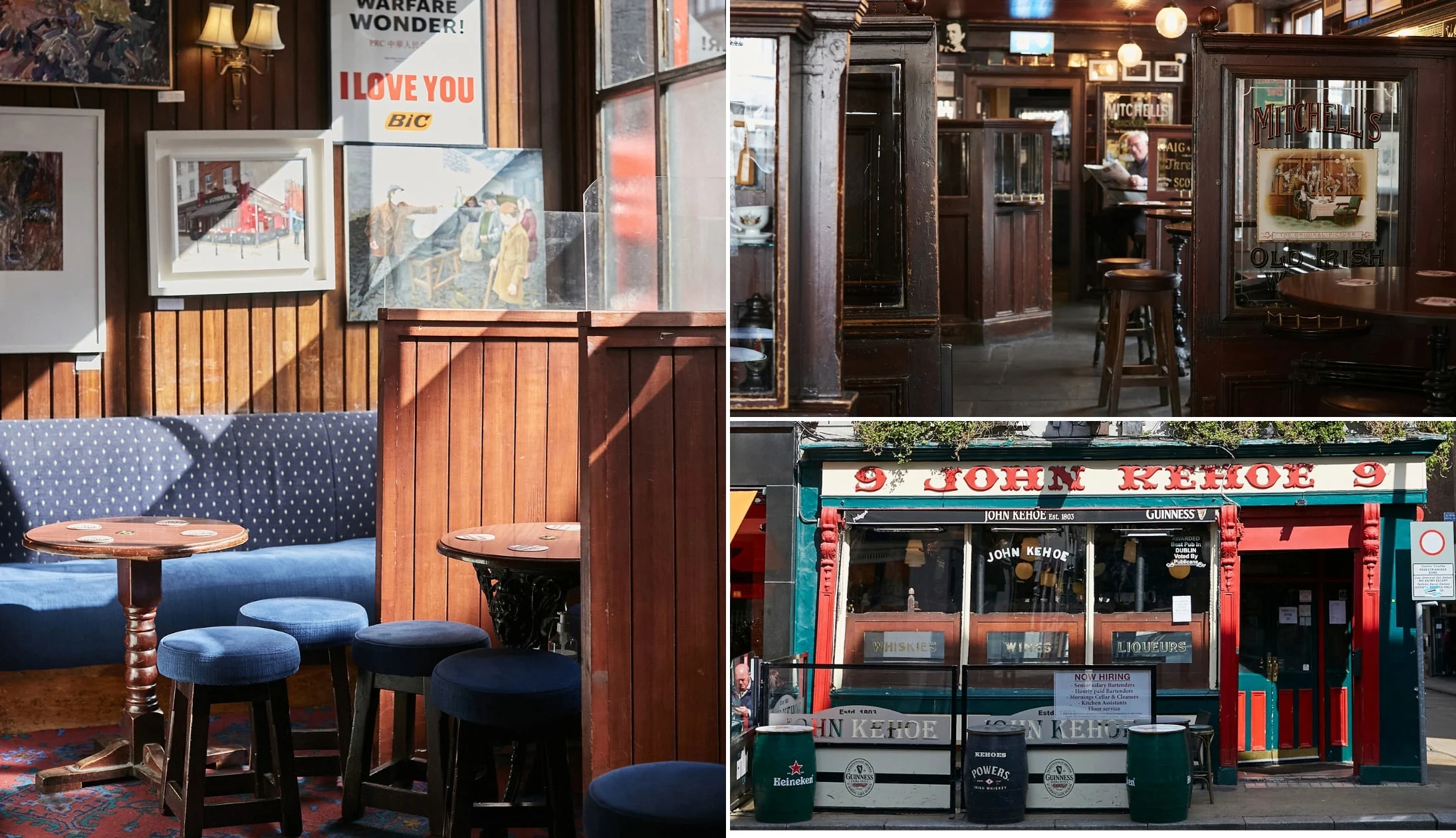
Different trad bars in Dublin. © Tourism Ireland
Stop by your hotel to freshen up before dinner or continue straight on to the restaurant. If you’re not sure of where to eat dinner in Dublin, we’ve got a couple of suggestions below for the evening.
Our Dublin food recommendations
There’s endless excellent restaurants in Dublin. However, if we had to pick one or two…
The first would be The Bull and Castle – it’s always a good choice and it’s right across the street from the Christ Church Cathedral.
An FX Buckley steakhouse (a Dublin institution), they offer a great range of steaks cooked to perfection, paired with their incredible beef dripping chips.
The Vintage Kitchen is an alternative, but it’s best to book in advance as it’s incredibly popular. A BYOB (bring your own bottle) place, the food is phenomenal, with a small but diverse menu that features classic Irish dishes with a contemporary twist.
Our Dublin pub recommendations
There’s certainly no shortage of great pubs in Dublin. If you’re a fan of old-school pubs, follow our Dublin pub crawl guide – it contains a short route with some of the city’s finest trad bars.
McNeils on Capel Street is an authentic Dublin pub, complete with wood panelling, impromptu folk sessions, and plenty of beers on tap.
The Long Hall is another must-see. Part Victorian time capsule, part vibrant boozer, it enjoys a fantastic atmosphere and is one of the most visually stunning pubs in the city.
You’ll find trad sessions at Pipers Corner every night of the week. O’Donoghues Bar on Merrion Row is another must-visit, with vintage decor and frequent trad sessions. It’s best-known as the home of the Dubliners, who used to play here regularly.
The Celt on Talbot Street is another great choice for live music, and while it’s not always trad, the bands are normally really good.
Day 3: Wicklow’s Wonders
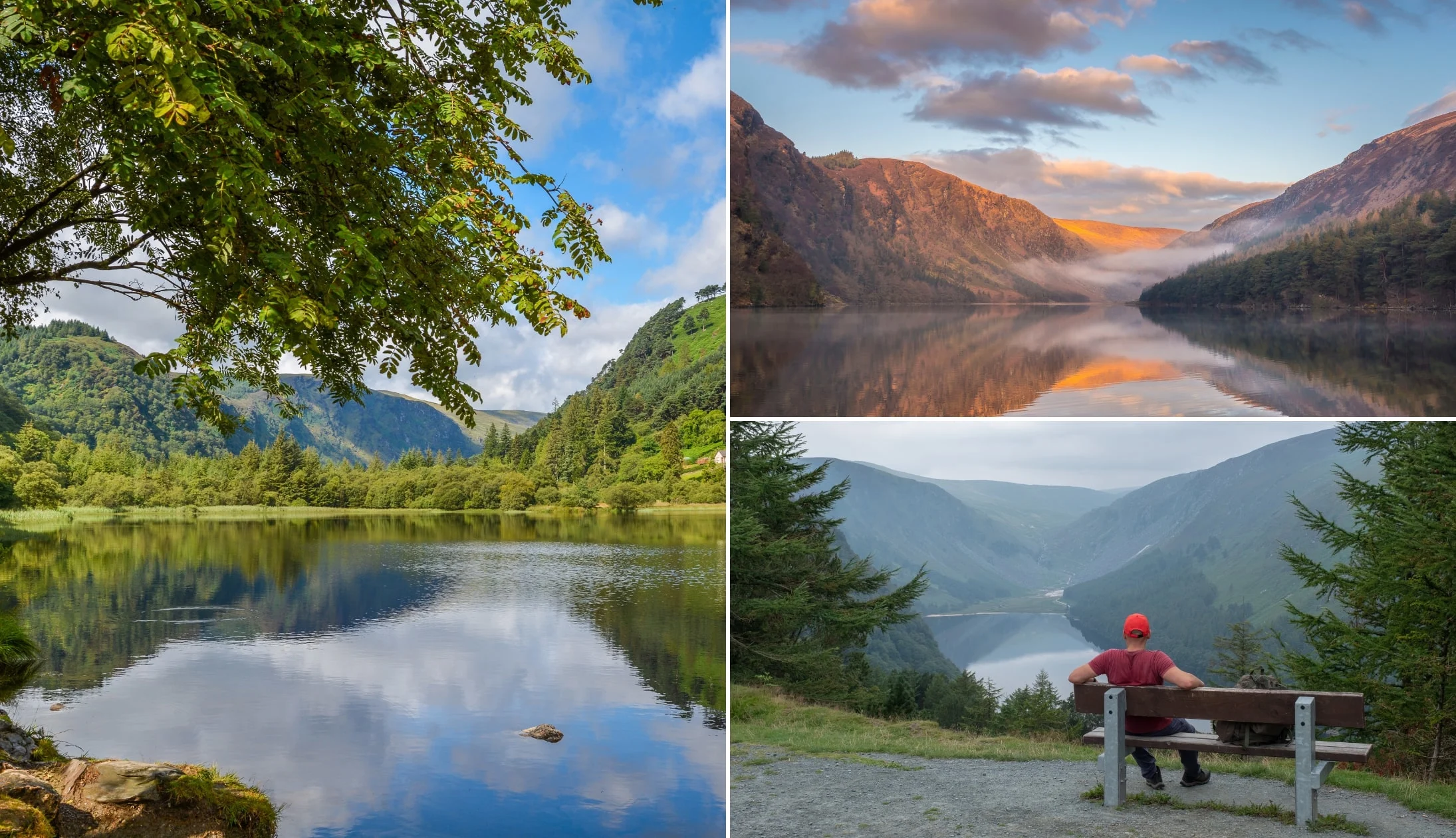
Photos via Shutterstock
Today, you’ll be exploring Wicklow, the country just south of Dublin, also known as the Garden of Ireland.
Depending on what time of the year you’re visiting, you’ll have different options for visiting Glendalough and the Wicklow Mountains National Park.
During the off-season, you’ll need to take St. Kevin Bus, and during the peak season, there’s a lovely guided tour that we’ve outlined below.
Getting to Wicklow option 1: A guided day trip
This 8-hour day trip includes a fully-guided day tour of Wicklow’s best sights, and includes a visit to Powerscourt Gardens (you’ll need to pay into the gardens separately)!
You’ll be driven along the Sally Gap, see iconic film locations used in P.S. I Love You, Brave Heart, and Vikings, and explore an ancient 6th-century settlement.
There are two options for this tour, so make sure to choose the option with the Powerscourt Garden visit as this is the more easy-going choice.
We’ll take you through the stops below, but note that 1, you may not always physically stop at all of these sights and 2, these tours are subject to change, so always check with the provider in advance.
Getting to Wicklow option 2: St. Kevin’s Bus
We definitely think a guided tour is the best way to explore Wicklow without a car, but if you can’t book onto the tour above, we suggest using St. Kevin’s Bus to get to Glendalough.
Take a look here for an in-depth guide. This should really be your Plan B as the guided tour includes the Sally Gap Drive, which is fantastic!
Stop 1: The Sally Gap Drive
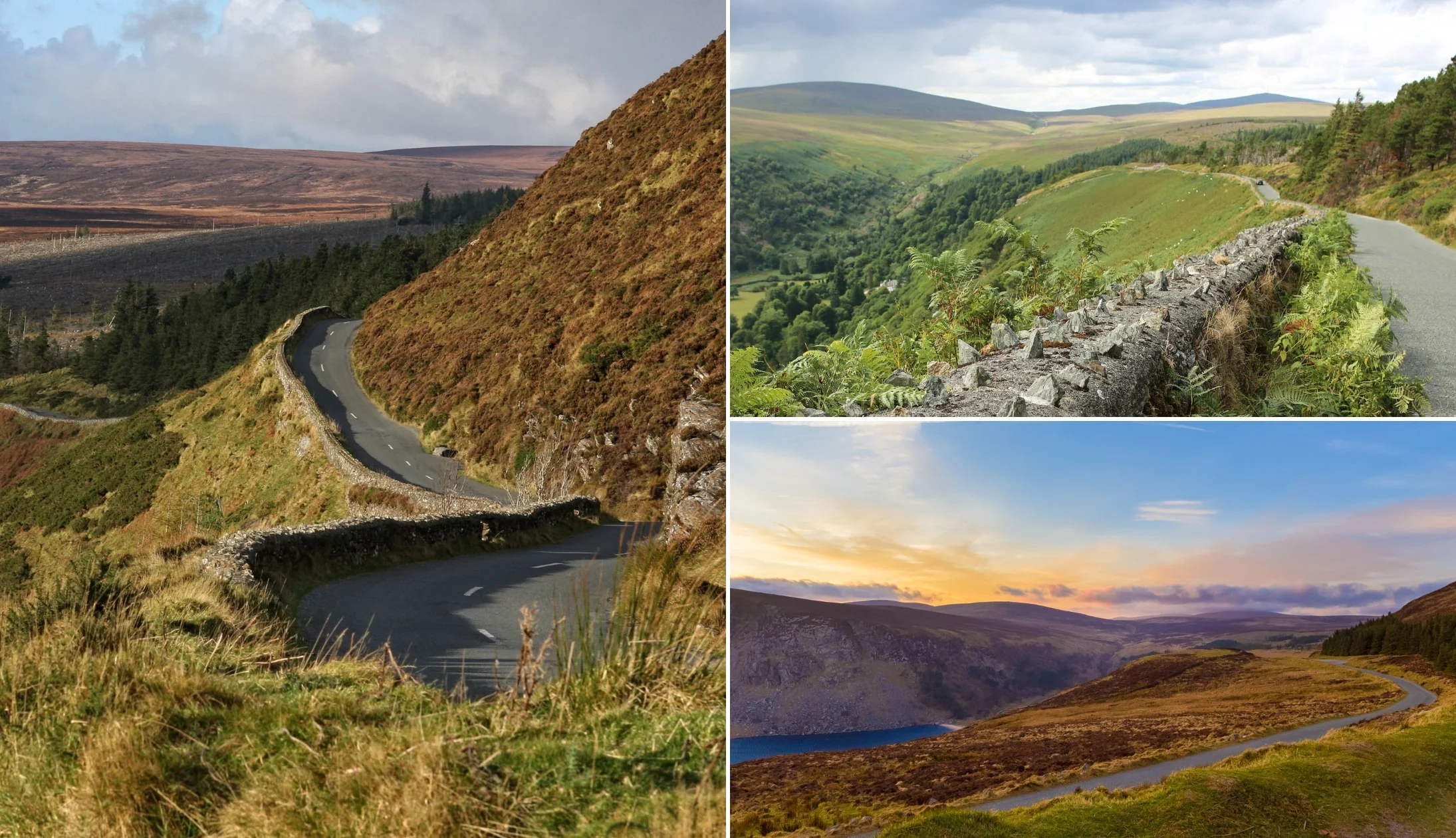
Photos via Shutterstock
OK, this isn’t really a stop. The Sally Gap is a famous crossroad on the Old Military Road through the Wicklow Mountains. The road was built in the early 1800s following the Irish Rebellion of 1798.
It’s a beautiful drive, with spectacular views of the mountains and blanket bog. One of the most notable attractions in this area is Lough Tay (AKA Guinness Lake).
Another is Glenmacnass Waterfall. However, the mountain views and the narrow roads that you drive along are what’ll really make this a corner of Ireland that you won’t forget.
Stop 2: Glendalough Monastic City
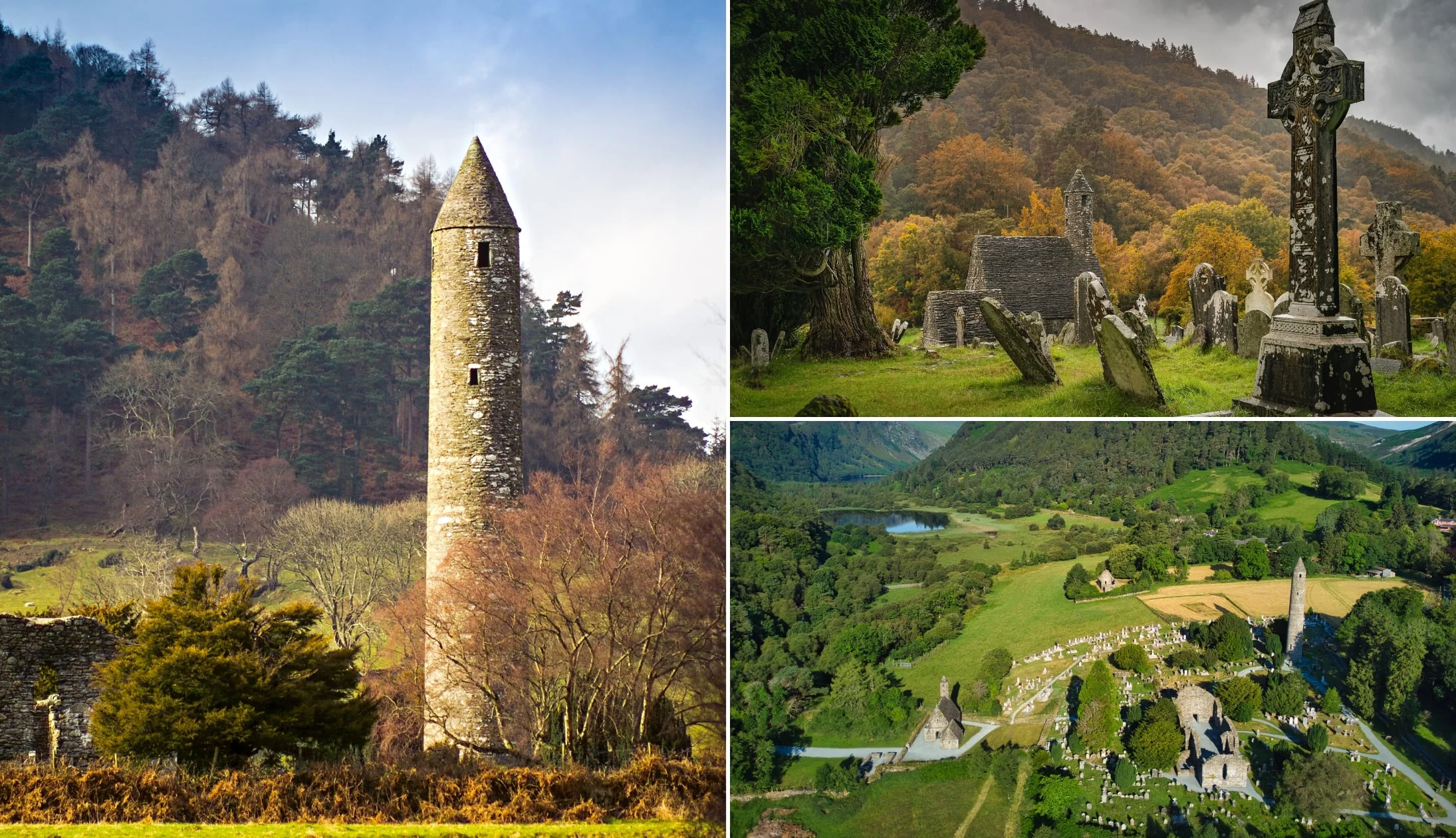
Photos via Shutterstock
The Monastic City was one of the most important monastic sites in this part of the country. The city was founded by St. Kevin in the 6th century and went on to become one of Europe’s most famous religious sites!
Right next to the settlement, there’s a visitor centre where you can enjoy the exhibits and learn more about the site and what made it so important.
After you’re all clued up, walk the 2 minutes to the monastic site and admire the Glendalough Round Tower, Cathedral, and St. Kevin’s Church.
Stop 3: The Lakes at Glendalough

Photos via Shutterstock
Along the way you’ll be passing by Glendalough Upper Lake and Lower Lake. Carved out by a melting glacier long ago, the upper lake is spectacular, nestled between trees and mountains.
It’s home to St. Kevin’s Bed, a small cave where St. Kevin lived as a hermit for several years before he founded the monastic city.
The lower lake is the smaller of the two, but equal in beauty, with gorgeous views of the mountains and forest.
Stop 4: Powerscourt Gardens
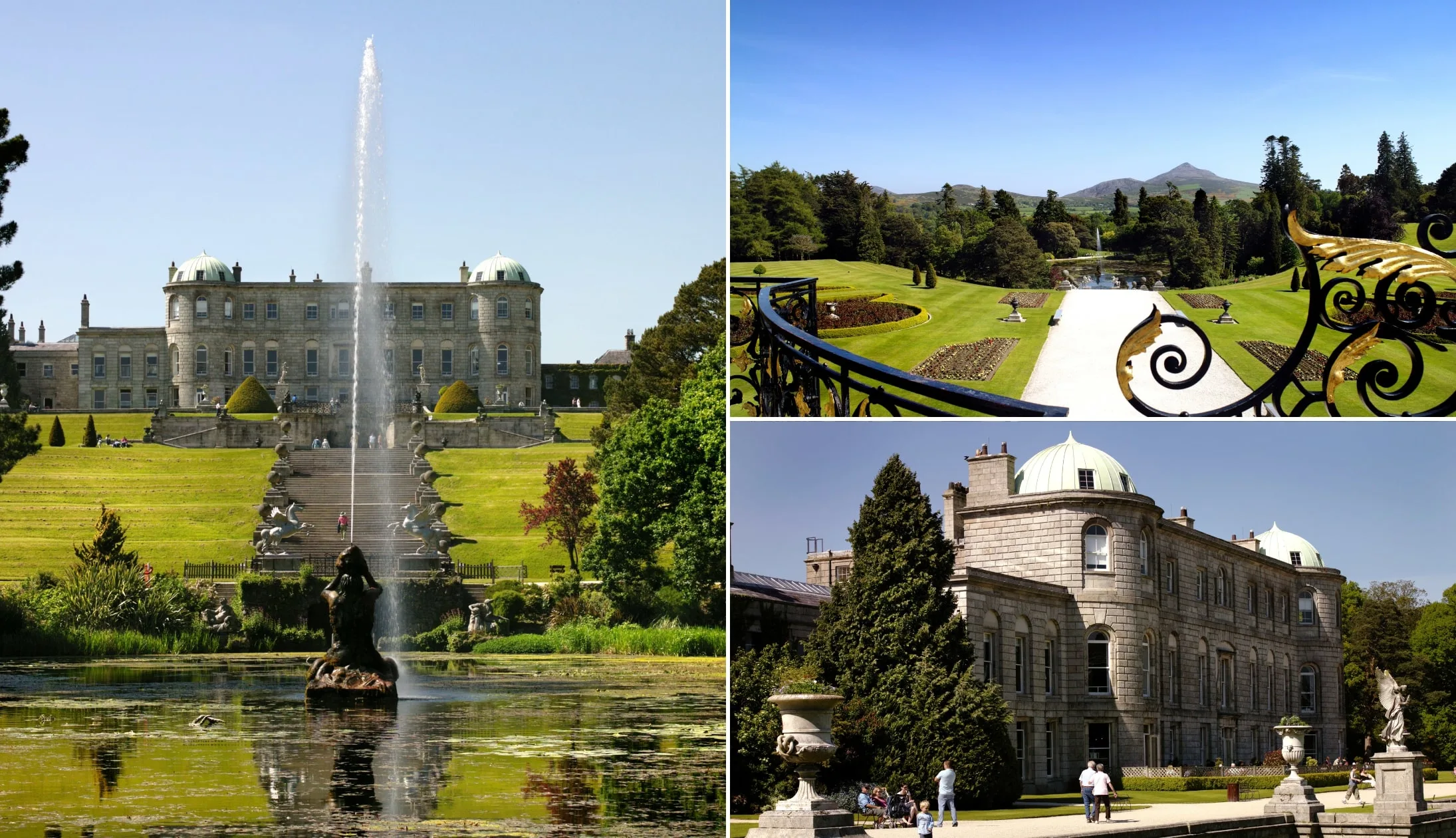
Photos by Chris Hill via Failte Ireland
The Powerscourt Gardens are filled with grandeur and were voted by National Geographic as one of the world’s Top Ten Gardens!
The 47-acre Powerscourt Gardens are managed by a team of five gardeners, who tend to the Walled Garden, the Japanese Garden, the Italian Garden, and more.
The grounds are filled with ornamental lakes, formal gardens, and statues, making them perfect for a leisurely stroll!
Stop 5: Back to Dublin for the night

Different trad bars in Dublin. © Tourism Ireland
After a long day of sightseeing, you’ll be heading back to the city. Nip into your hotel to freshen up before dinner, or if you’re not fussed, head out for something to eat as soon as you get back.
Our Dublin food recommendations
There’s endless excellent restaurants in Dublin. However, if we had to pick one or two…
The first would be The Bull and Castle – it’s always a good choice and it’s right across the street from the Christ Church Cathedral.
An FX Buckley steakhouse (a Dublin institution), they offer a great range of steaks cooked to perfection, paired with their incredible beef dripping chips.
The Vintage Kitchen is an alternative, but it’s best to book in advance as it’s incredibly popular. A BYOB (bring your own bottle) place, the food is phenomenal, with a small but diverse menu that features classic Irish dishes with a contemporary twist.
Our Dublin pub recommendations
There’s certainly no shortage of great pubs in Dublin. If you’re a fan of old-school pubs, follow our Dublin pub crawl guide – it contains a short route with some of the city’s finest trad bars.
McNeils on Capel Street is an authentic Dublin pub, complete with wood panelling, impromptu folk sessions, and plenty of beers on tap.
The Long Hall is another must-see. Part Victorian time capsule, part vibrant boozer, it enjoys a fantastic atmosphere and is one of the most visually stunning pubs in the city.
You’ll find trad sessions at Pipers Corner every night of the week. O’Donoghues Bar on Merrion Row is another must-visit, with vintage decor and frequent trad sessions. It’s best-known as the home of the Dubliners, who used to play here regularly.
The Celt on Talbot Street is another great choice for live music, and while it’s not always trad, the bands are normally really good.
Day 4: Killarney
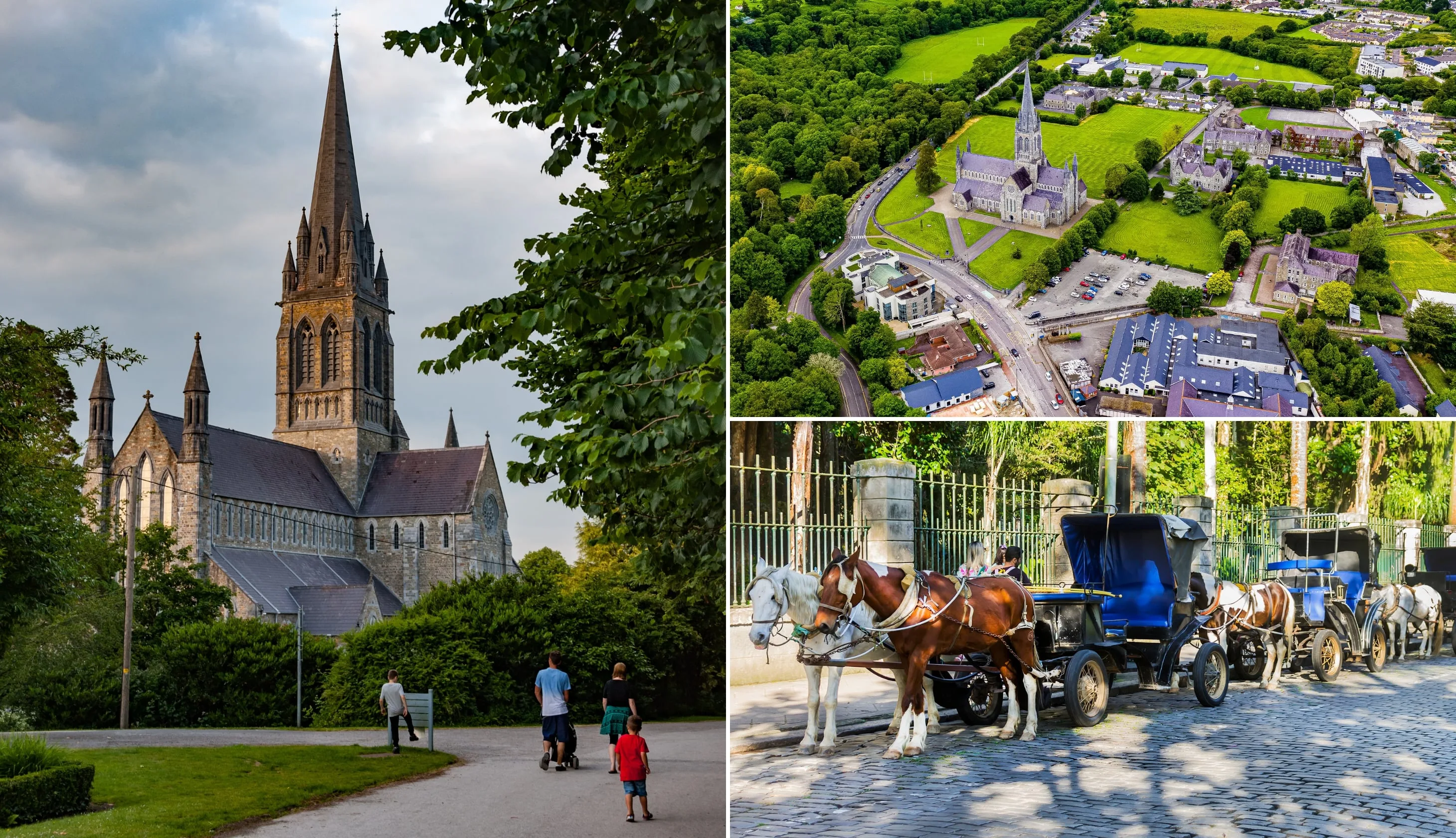
Photos via Shutterstock
It’s day 4 of your 10 days in Ireland itinerary, and today, you’ll be heading to Killarney Town. You’ll be spending three nights in this peaceful town which sits on the outskirts of a beautiful national park.
Grab some breakfast from your accommodation or nearby.
Recommended accommodation in Killarney
Here are a handful of places that we’d recommend staying in Killarney:
- Budget: New Street Lodge (basic accommodation a stone’s throw from the National Park) and Castle Lodge (cosy B&B a 5-minute walk from Killarney House)
- Mid-range: Killaran House (exceptional accommodation in a great location) and Killarney Avenue (right by the park with excellent rooms)
- Luxury: Muckross Park Hotel & Spa (an elegant hotel a 10-minute walk from Muckross Abbey) and The Killarney Park (old-worlde style 5-star near the train station)
Getting from Dublin to Killarney
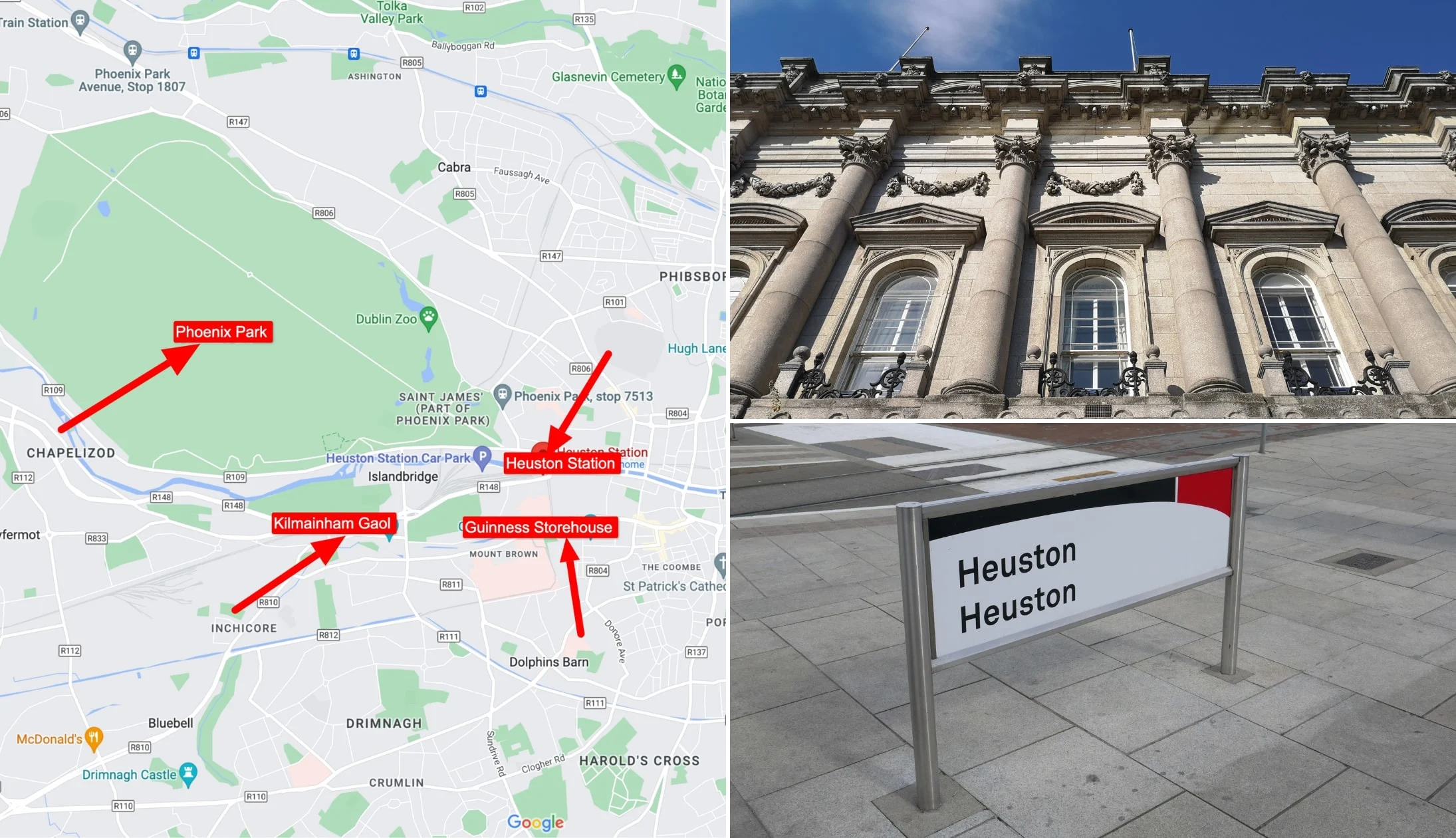
Photo left: Google Maps. Others: Shutterstock
The train to Killarney departs from Heuston, you can take a taxi here, walk or take the Luas Red line, which has a stop right out front. The trip to Killarney takes about 3 hours and you will need to change trains so pay attention to your booking.
There are shops inside the station where you can grab snacks for the train and breakfast. We recommend buying food for the train instead of waiting to buy something on the train.
Stop 1: Arrive in the town and try and check into your accommodation
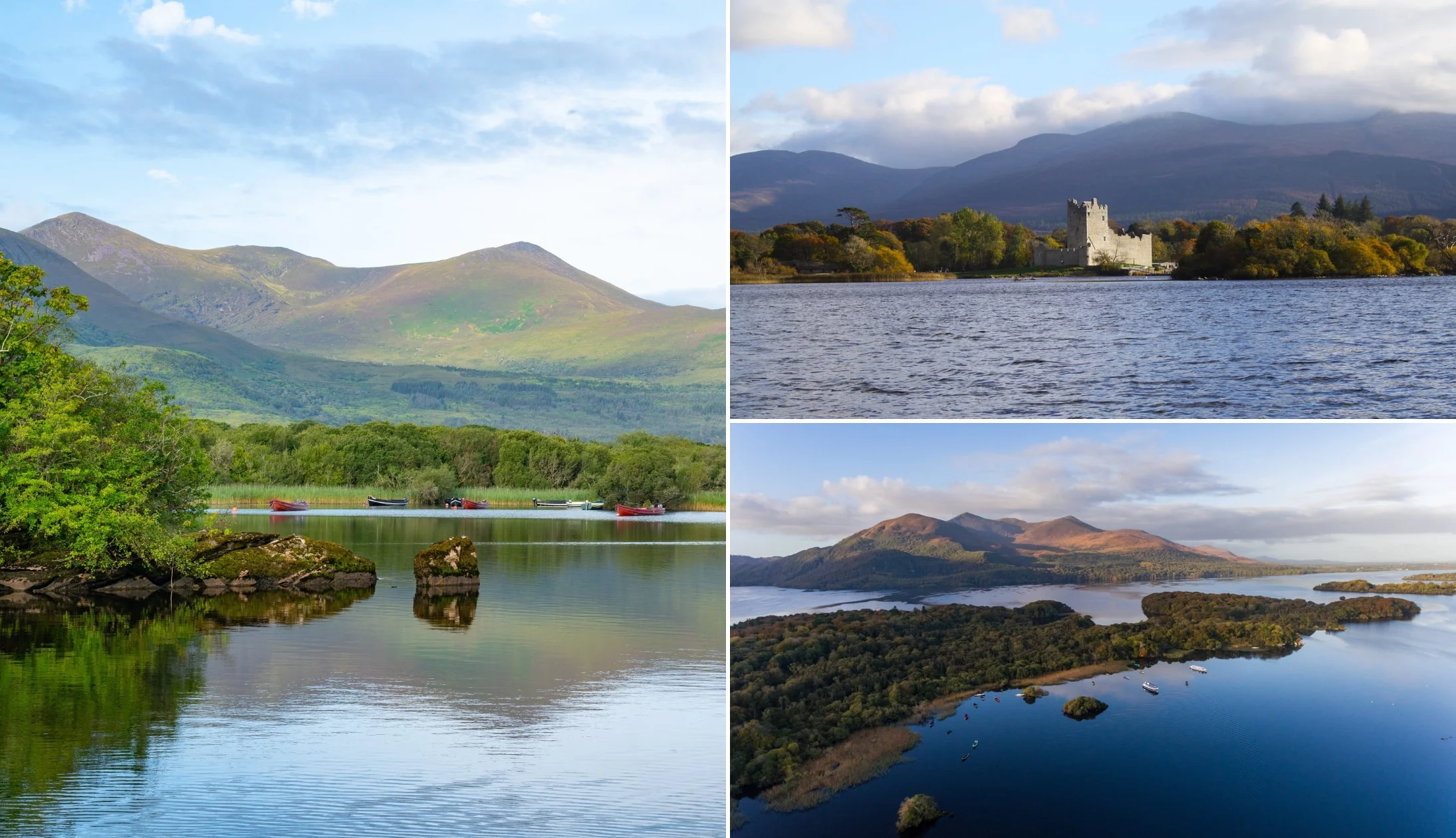
Photos via Shutterstock
Welcome to Killarney Town! If you can, try and check into your accommodation – this will likely depend on when you arrive, as some places won’t allow you to check-in until the afternoon.
Once you arrive, if you feel like stretching your legs a bit, consider grabbing a coffee to go from Bean in Killarney then going for a little wander.
When you’re ready, it’s time to explore the area and we’ve three different ways of exploring for you to choose from.
Personally, I think option 1 combined with option 3 is the way to go!
Option 1: The self-guided cycle
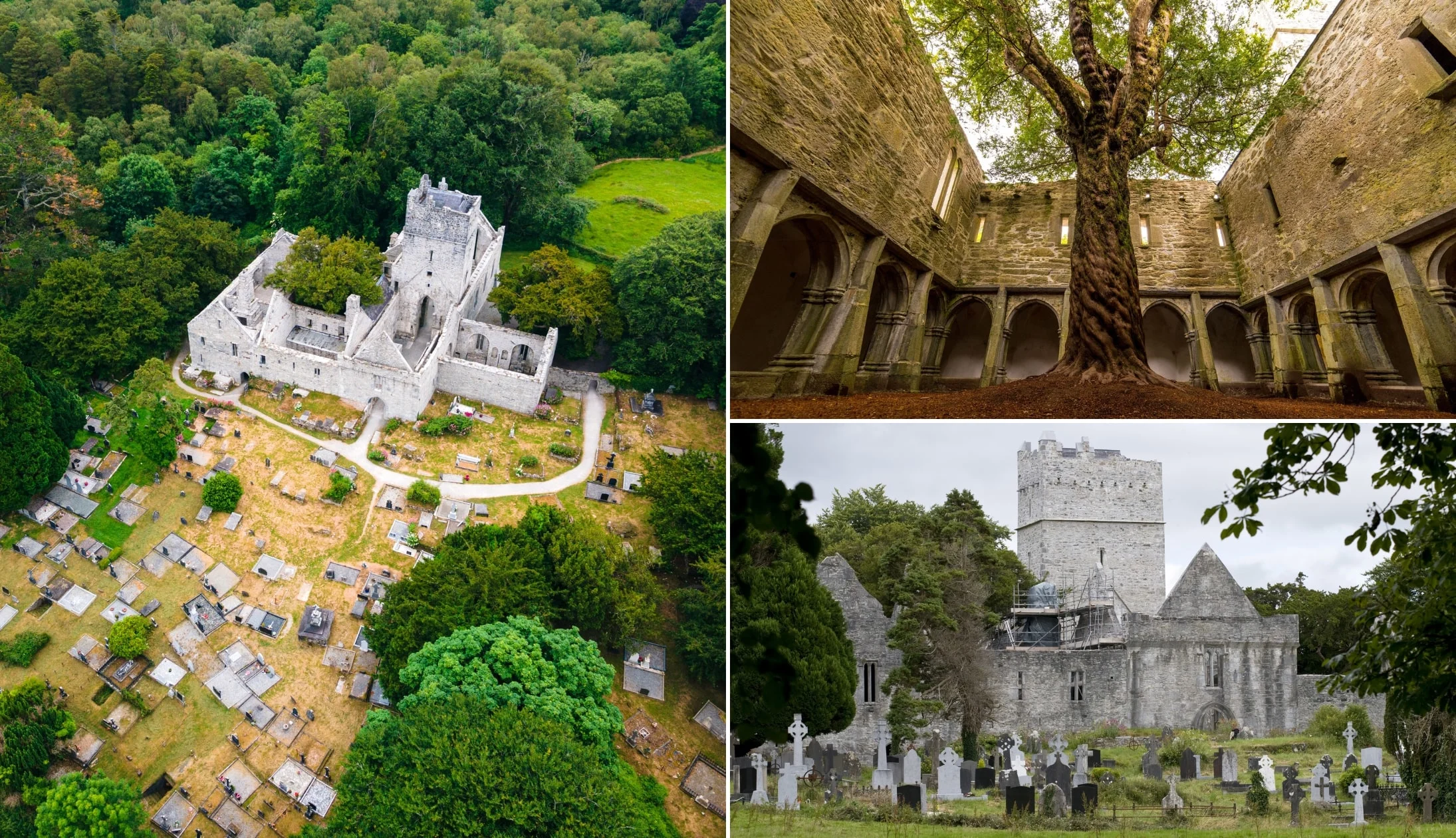
Photos via Shutterstock
Killarney National Park is big and, while it’s a joy to ramble around, it’s the perfect spot to explore by bike (we’re speaking base on personal experience here).
You can rent a bike online in advance and then pick it up from the collection point on the Muckross Road.
You then cross the road and head straight into the park. There’s very few inclines and it’s a wonderful way to get around to Torc Waterfall, Muckross House and the Lakes of Killarney.
Option 2: The jaunty

Photos via Shutterstock
Another great, and very unique way to explore Killarney, is via one of the traditional jaunting cars (i.e. the horse and cart).
On this 1-hour guided jaunty tour, you’ll:
- See Ireland’s highest Mountain Range – the MacGillycuddys
- Trot past the 15th-century Ross Castle
- See the impressive St Mary’s Cathedral
- Learn about Killarney from a traditional Jarvey guide
Option 3: The Lakes of Killarney boat Cruise

Photos via Shutterstock
Arguably one of the most popular tours in Killarney is this 1-hour (and very reasonable) boat tour that takes you around Killarney’s lakes.
The tour takes place on a glass-covered boat with heating and it gives you a completely different perspective of the national park.
You’ll drift by the 6th-century Innisfallen Monastery, see the highest mountain in Ireland and, at times, see Red Deer and White Tailed Eagles.
Stop 2: Dinner, drinks and live music in Killarney
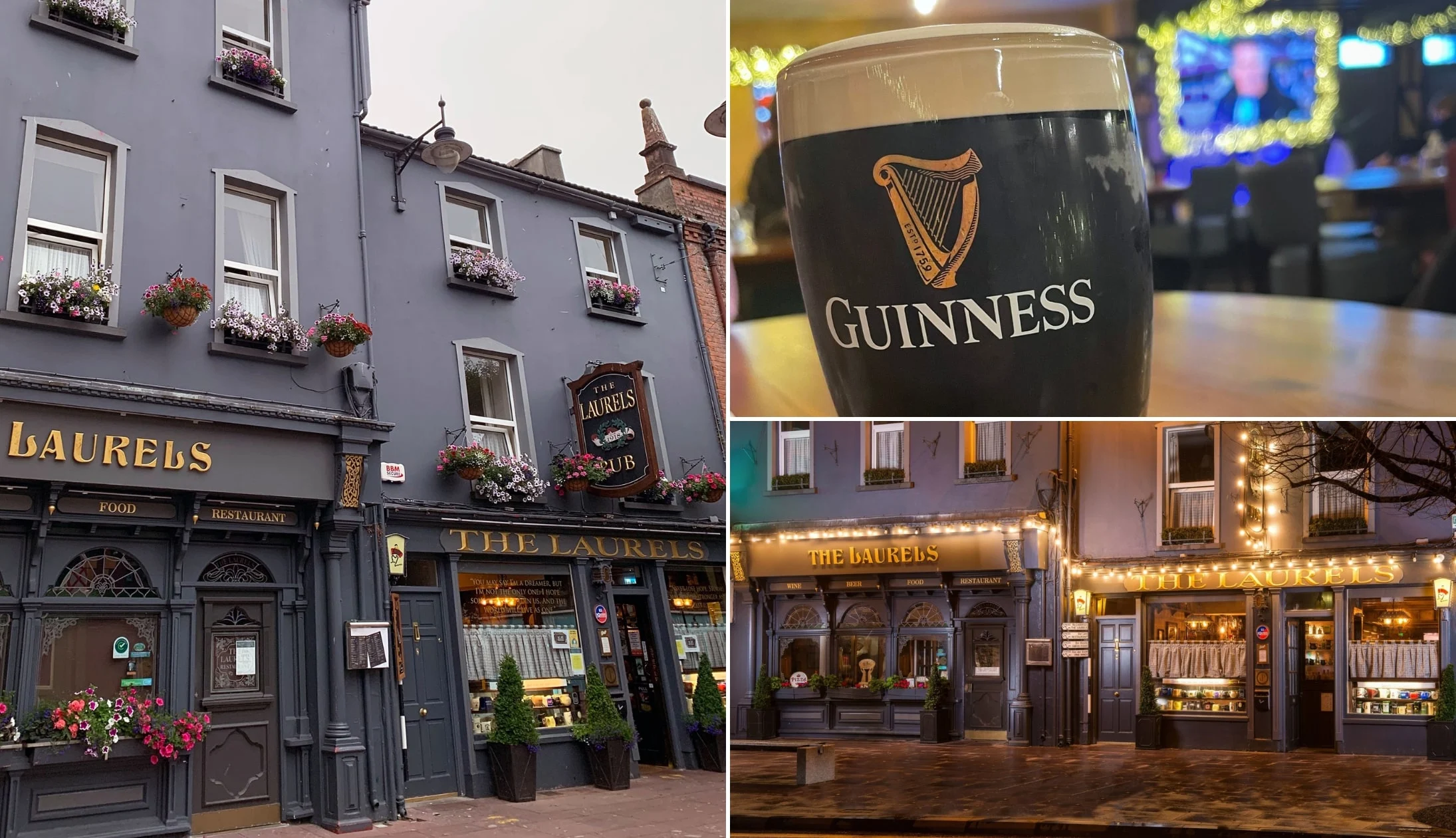
Photos via The Laurels on FB
Killarney is a place that’s rarely too quiet, even during the off-season.
Our dinner recommendations
There are some exceptional restaurants in Killarney. Our favourites are the Mad Monk (they serve amazing seafood like sizzling crab claws and deep water prawn tagliatelle), Kitty O’Se (splash out on the Seafood Tower to share), and Murphy Browns (hearty Irish dishes like roasted duck and fish and chips).
Our pub recommendations
There’s some mighty old-school pubs in Killarney, too. For post-dinner drinks, head to JM Reidy’s, the Laurels Pub, or O’Connors.
They all have a traditional pub feel and are a great choice for a pint. JM Reidy’s has a lovely courtyard which is great in the summer, and O’Connors is perfect if you feel like cocktails.
If you want to hear some live music, JM Reidy’s and O’Connors often have live music sessions.
Day 5: The Ring of Kerry
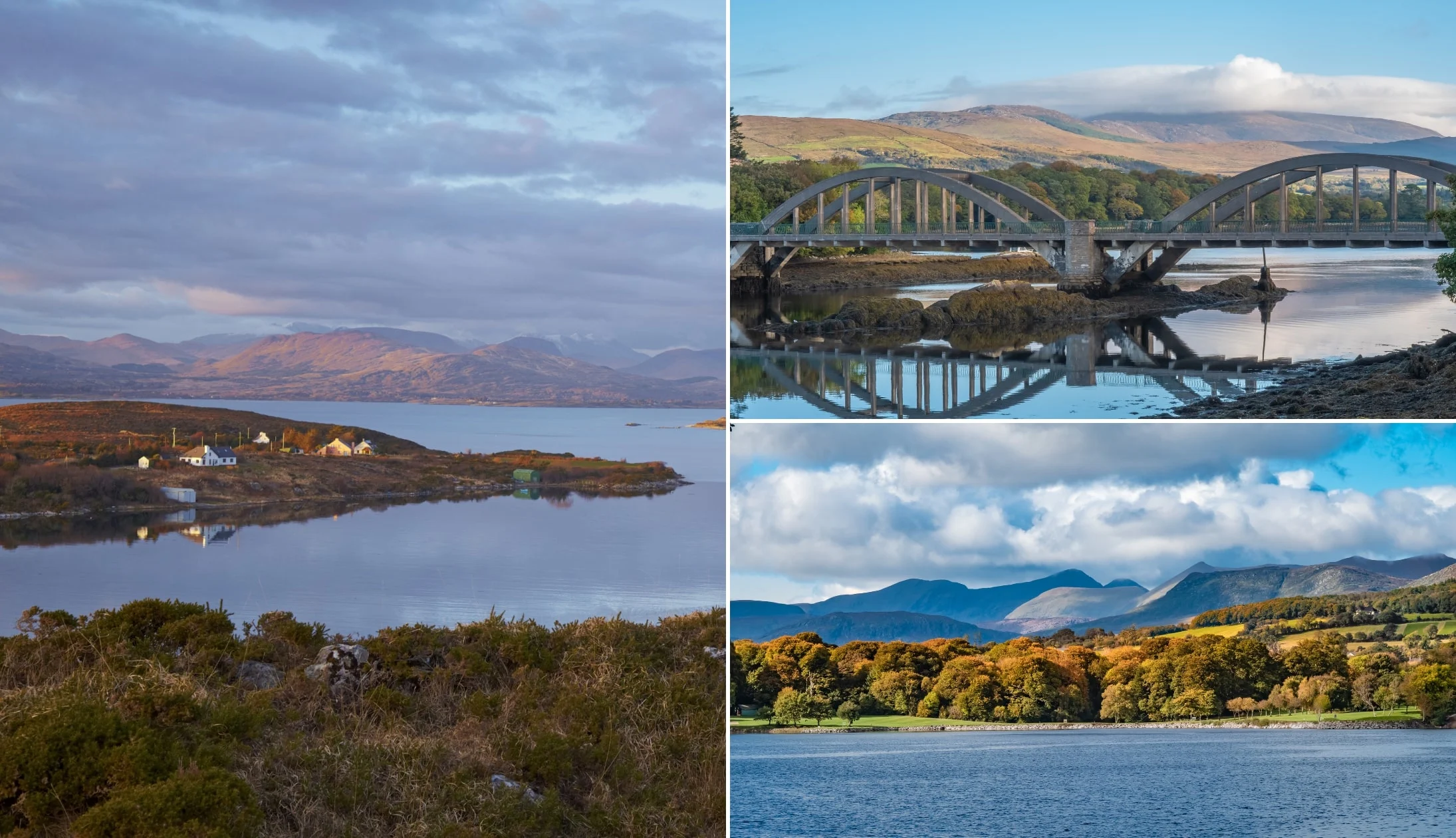
Photos via Shutterstock
Today you’re heading off for an adventure on the stunning Ring of Kerry! Be prepared for some amazing views and lovely beaches.
We’re going to recommend that you take this 7-hour Ring of Kerry day trip that’ll take you to all of the route’s highlights.
We’ll take you through the stops below, but note that 1, you may not always physically stop at all of these sights and 2, these tours are subject to change, so always check with the provider in advance.
Stop 1: Killorglin
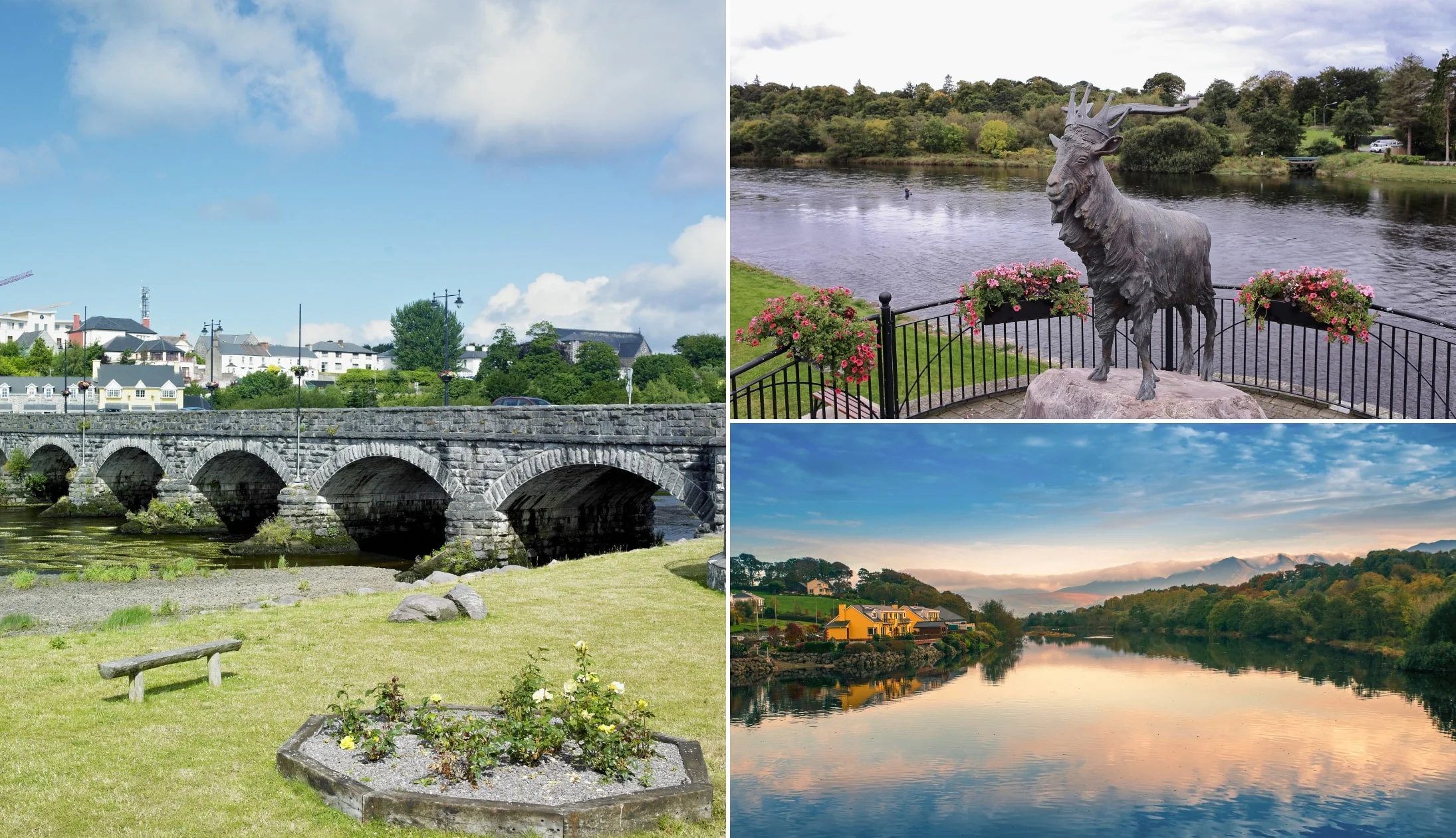
Photos via Shutterstock
Killorglin is a lovely little town on the Ring of Kerry. You’ll just be passing by, but keep an eye out of the window as it’s lovely.
The town is known for its annual Puck Fair, the country’s oldest street festival. It’s held every year in August, and following tradition, the fair starts with crowning the “king” goat
Stop 2: Dingle Bay and Inch Beach
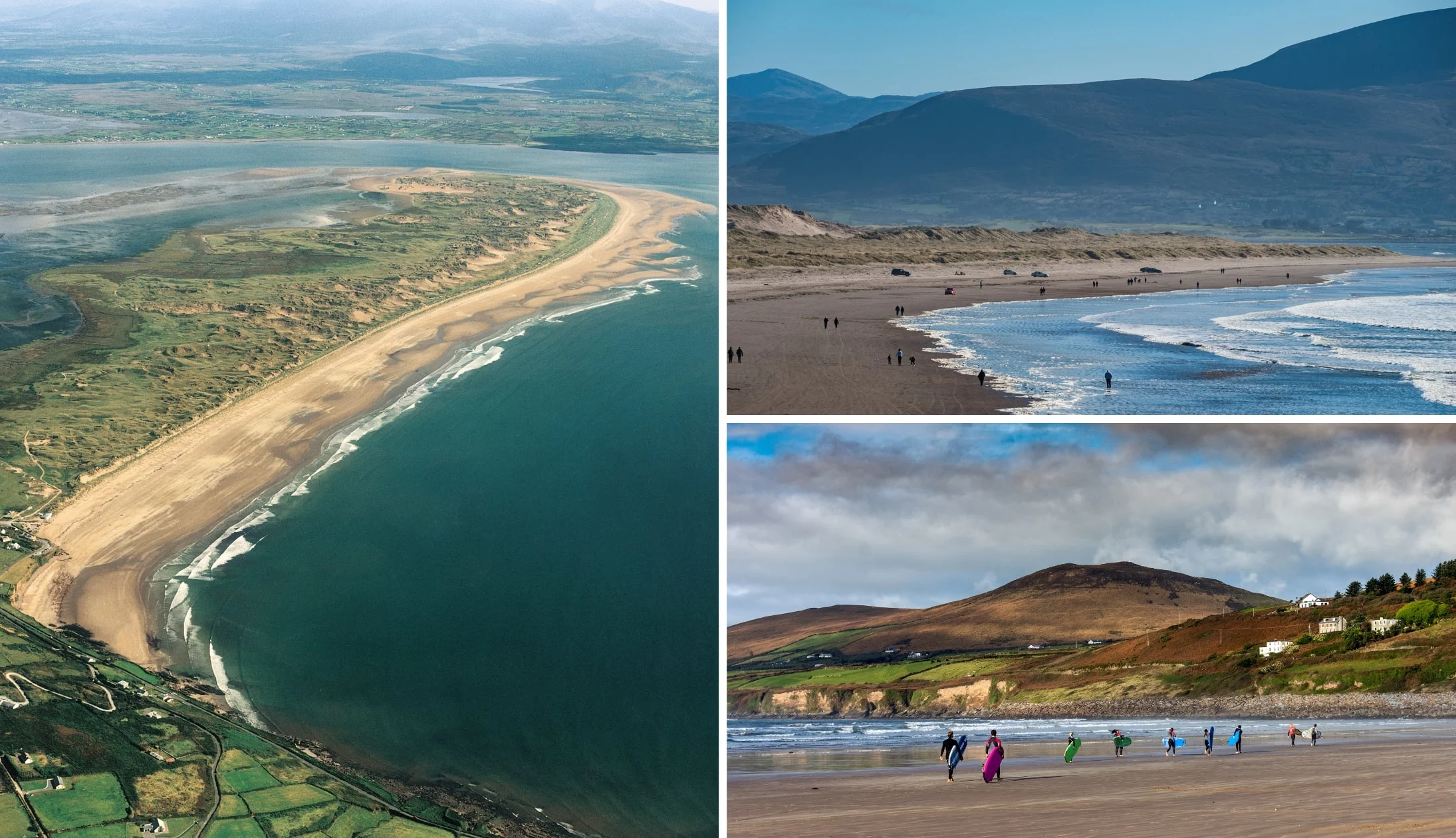
Photos via Shutterstock
As you pass through Killorglin, you’ll be driving alongside Dingle Bay and passing by Inch Beach, a long spit that juts out across the bay from the other side of the water.
Inch is one of Kerry’s most popular surf spots and you should be able to see surfers attempting to tame the waves here from afar.
Stop 3: Skellig views
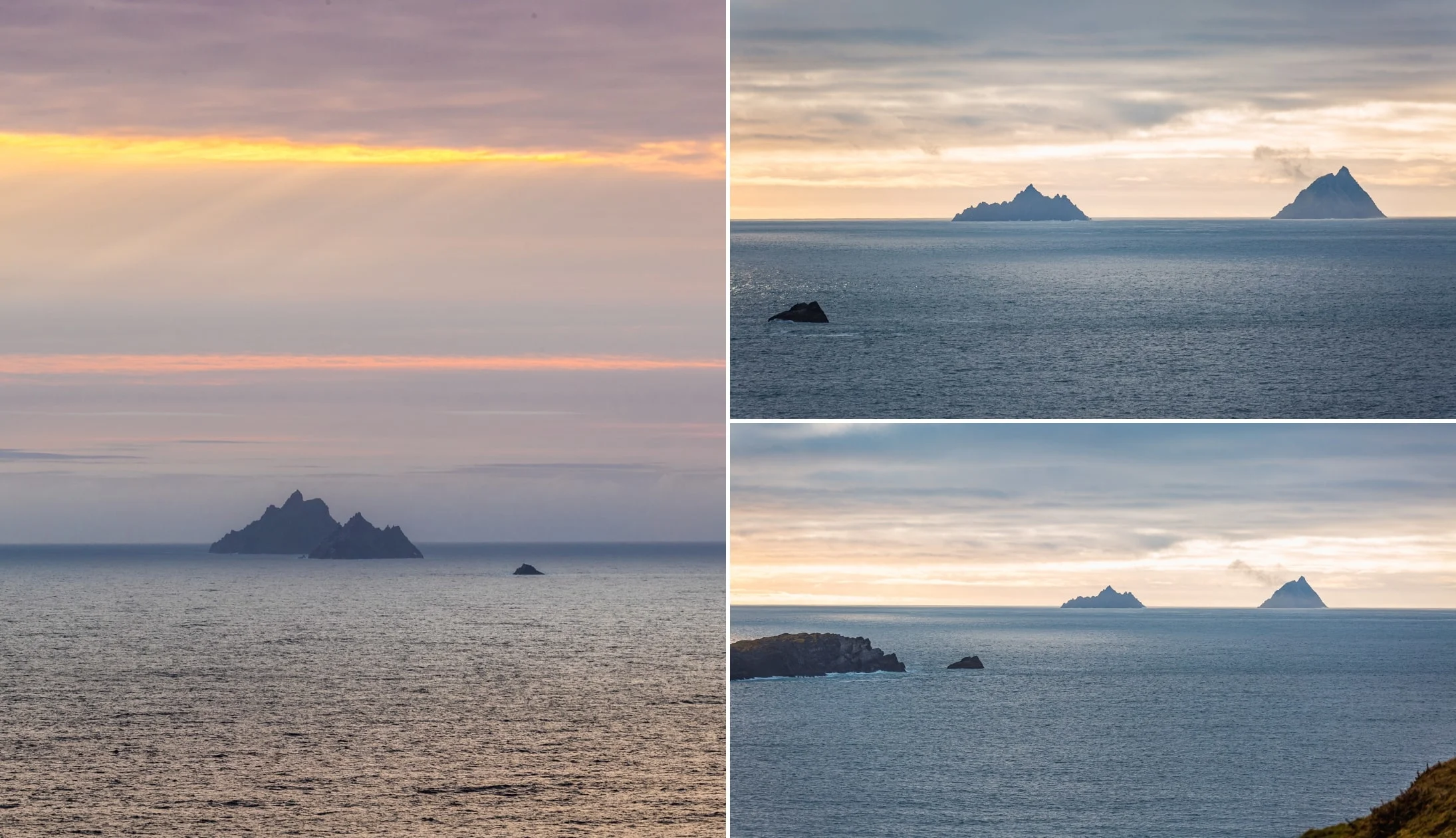
Photos via Shutterstock
As you make your way to Waterville, you’ll be passing by Ballinskelligs Bay, where on clear days, you’ll be able to spot the Skellig Islands off in the distance.
There are two islands – Skellig Michael and Little Skellig. The former shot to fame in recent years when scenes from a Star Wars movie were filmed on the island.
Stop 4: Waterville
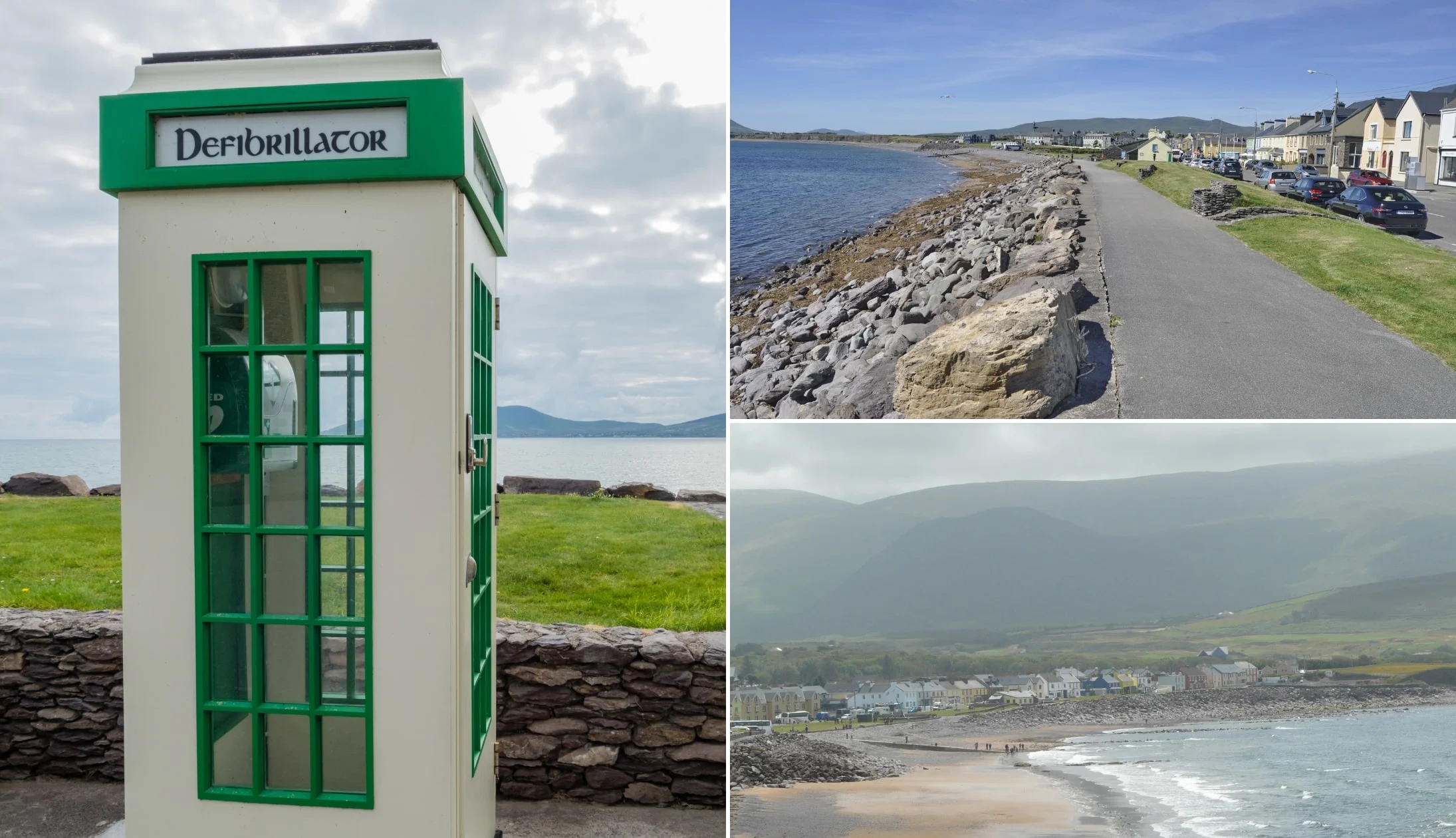
Photos via Shutterstock
Keep an eye out of the window as you pass through Waterville and discover why it was Charlie Chaplin’s favourite village in Ireland.
Chaplin first visited the village in 1959, after a recommendation from his friend Walt Disney!
Stop 5: Sneem
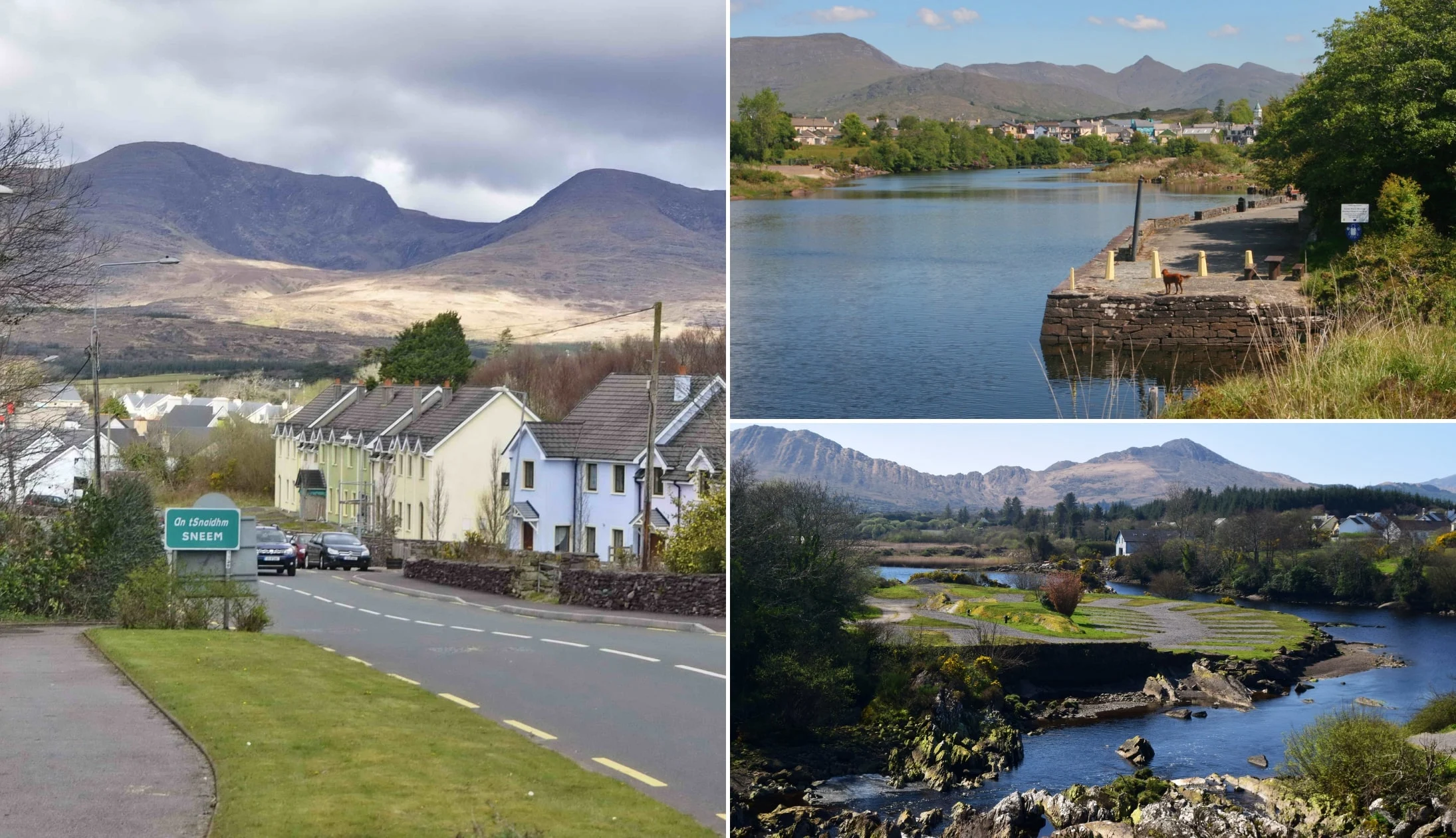
Photos via Shutterstock
You’ll be making a stop in Sneem, a colourful little village on the Sneem Estuary. The river flows right through the middle of the village and there’s a lovely stone bridge connecting both sides.
The bridge dates back to 1810, with five arches and a staircase down to the water.
Stop 6: Kenmare Bay

Photos via Shutterstock
As you drive out of Sneem on the Ring of Kerry road, you’ll be passing alongside Kenmare Bay, a long narrow bay that borders County Kerry and Cork.
This stretch of road hugs the coast and, while much of it is engulfed by tall trees, offers gorgeous views at times.
Stop 7: Moll’s Gap
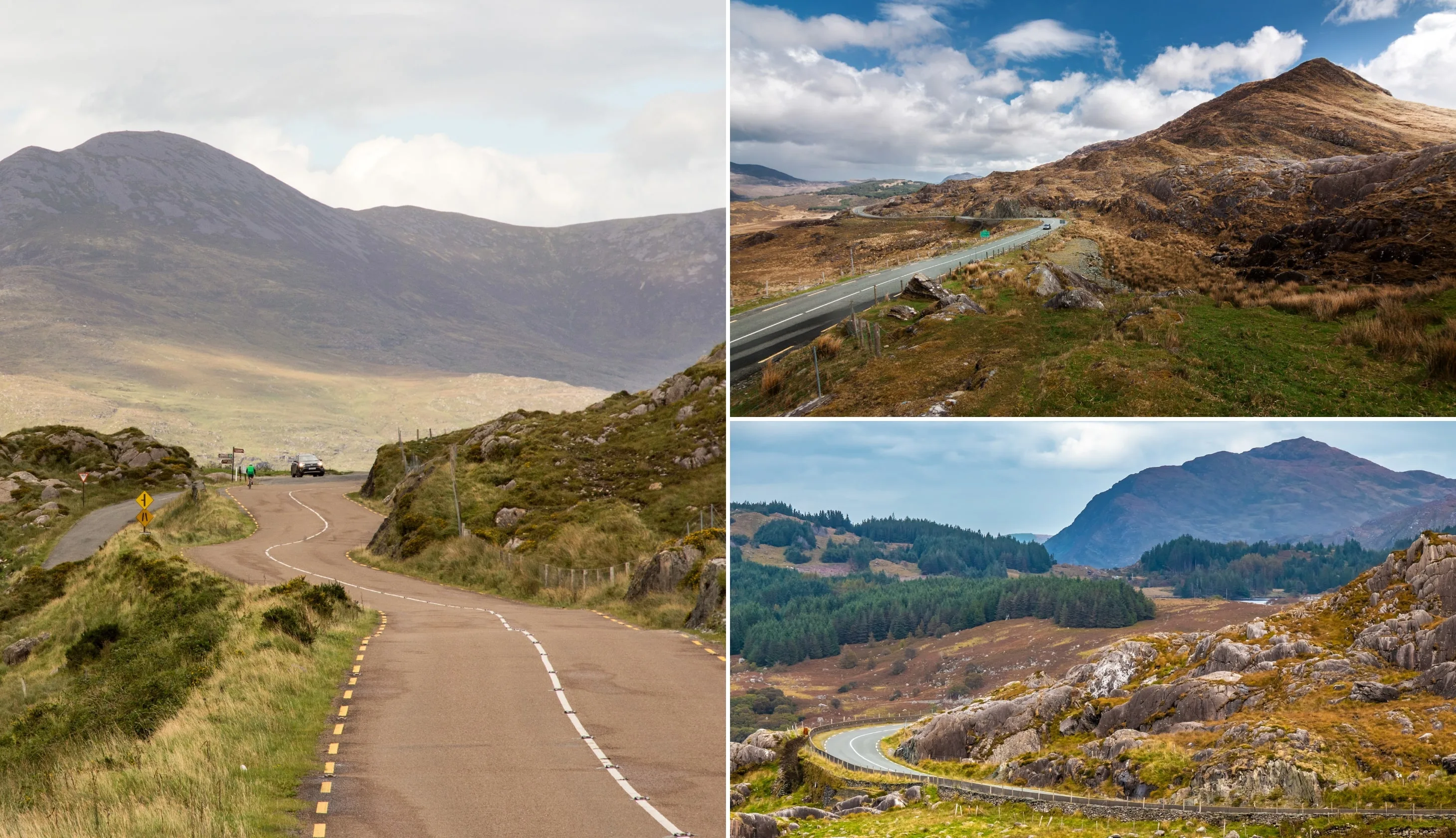
Photos via Shutterstock
Moll’s Gap is also known as Céim an Daimh in Irish or ‘Gap of the Ox’, but it gets its nickname after Moll Kissane, owner of a local shebeen (unlicensed pub).
The pub was established in the 1820s when the road was being built, and Moll’s homemade poitin (a strong liquor sometimes made from potatoes) was a favourite with the construction workers!
Stop 8: Ladies View
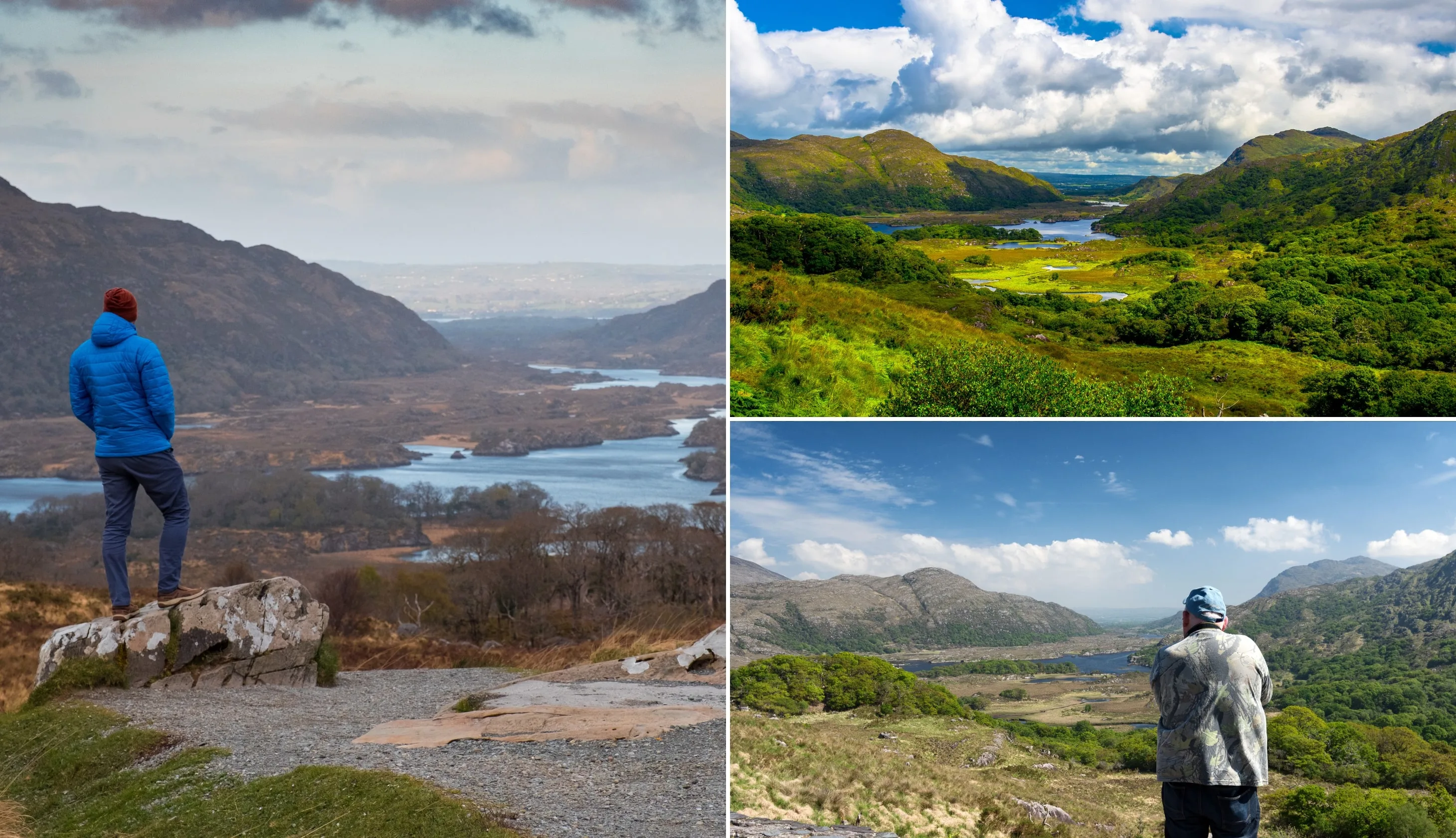
Photos via Shutterstock
Ladies View is one of the most popular stops on the Ring of Kerry, with roadside parking directly facing the view.
The viewpoint was named in honour of Queen Victoria’s ladies-in-waiting who were in awe when they visited in 1861 during a royal visit.
The view looks out over the Upper Lake with mountains rising up on either side. From Molls Gap and Ladies View, you’ll have views over the Black Valley, an isolated valley which was the last place in Ireland to get electricity!
From the previous viewpoint, try to spot the wonderful lakes of Killarney. There are three lakes in total: Lough Leane, Middle Lake (also called Muckross Lake), and Upper Lake.
Ladies View has fantastic vistas of the Upper Lake.
Stop 9: Torc Waterfall
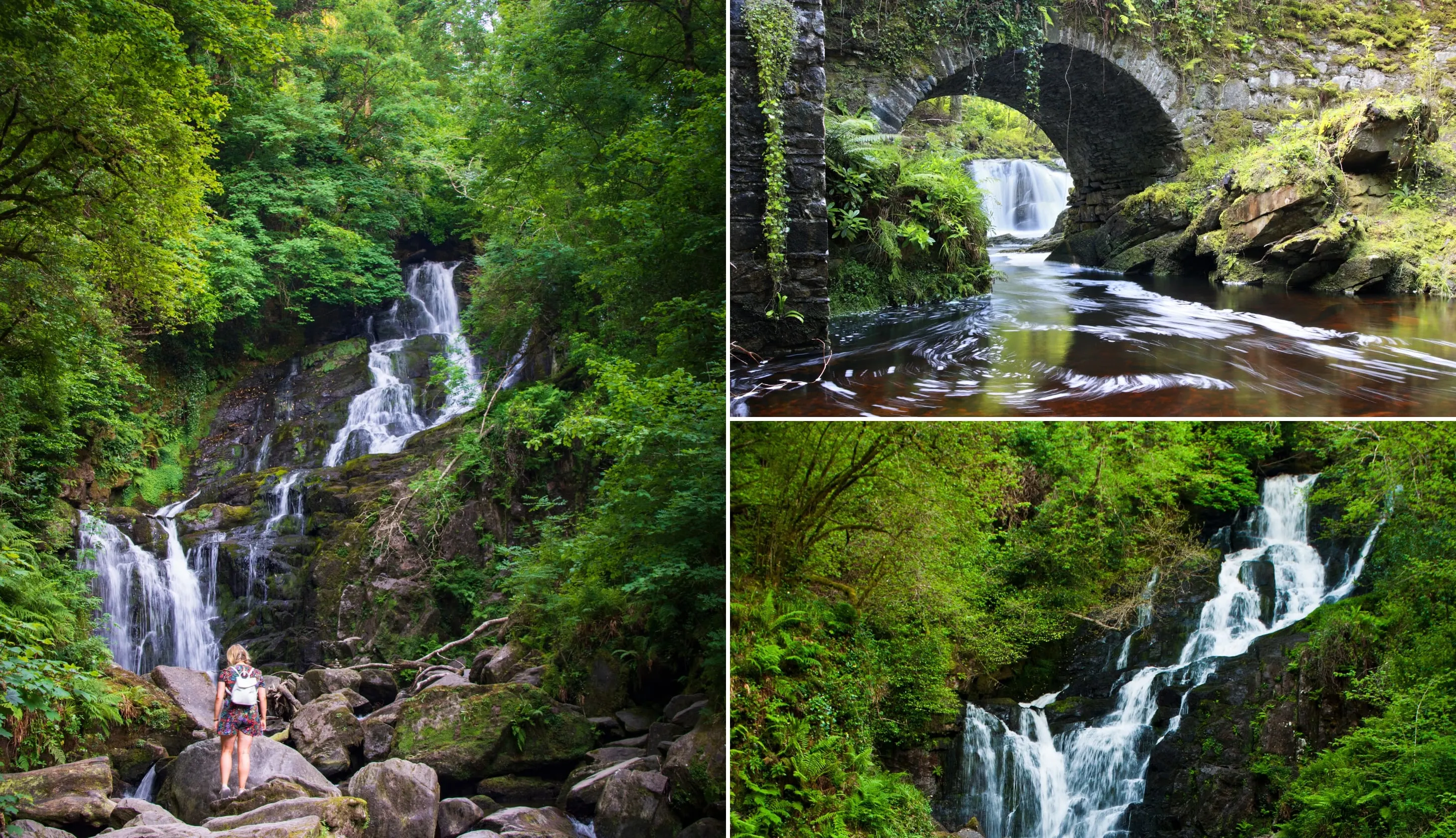
Photos via Shutterstock
According to local folklore, Torc Waterfall was home to a man who was cursed by the devil to turn into a boar each night.
When his secret was revealed by a farmer, the man burst into flames and retreated to the Devil’s Punchbowl.
The waterfall is breathtaking, tumbling for around 20 metres down rocks and boulders.
Stop 10: Back to Killarney for the night

Photos via The Laurels on FB
After the waterfall, the tour makes its way back to Killarney.
Our dinner recommendations
There are some exceptional restaurants in Killarney. Our favourites are the Mad Monk (they serve amazing seafood like sizzling crab claws and deep water prawn tagliatelle), Kitty O’Se (splash out on the Seafood Tower to share), and Murphy Browns (hearty Irish dishes like roasted duck and fish and chips).
Our pub recommendations
There’s some mighty old-school pubs in Killarney, too. For post-dinner drinks, head to JM Reidy’s, the Laurels Pub, or O’Connors.
They all have a traditional pub feel and are a great choice for a pint. JM Reidy’s has a lovely courtyard which is great in the summer, and O’Connors is perfect if you feel like cocktails.
If you want to hear some live music, JM Reidy’s and O’Connors often have live music sessions.
Day 6: The Dingle Peninsula
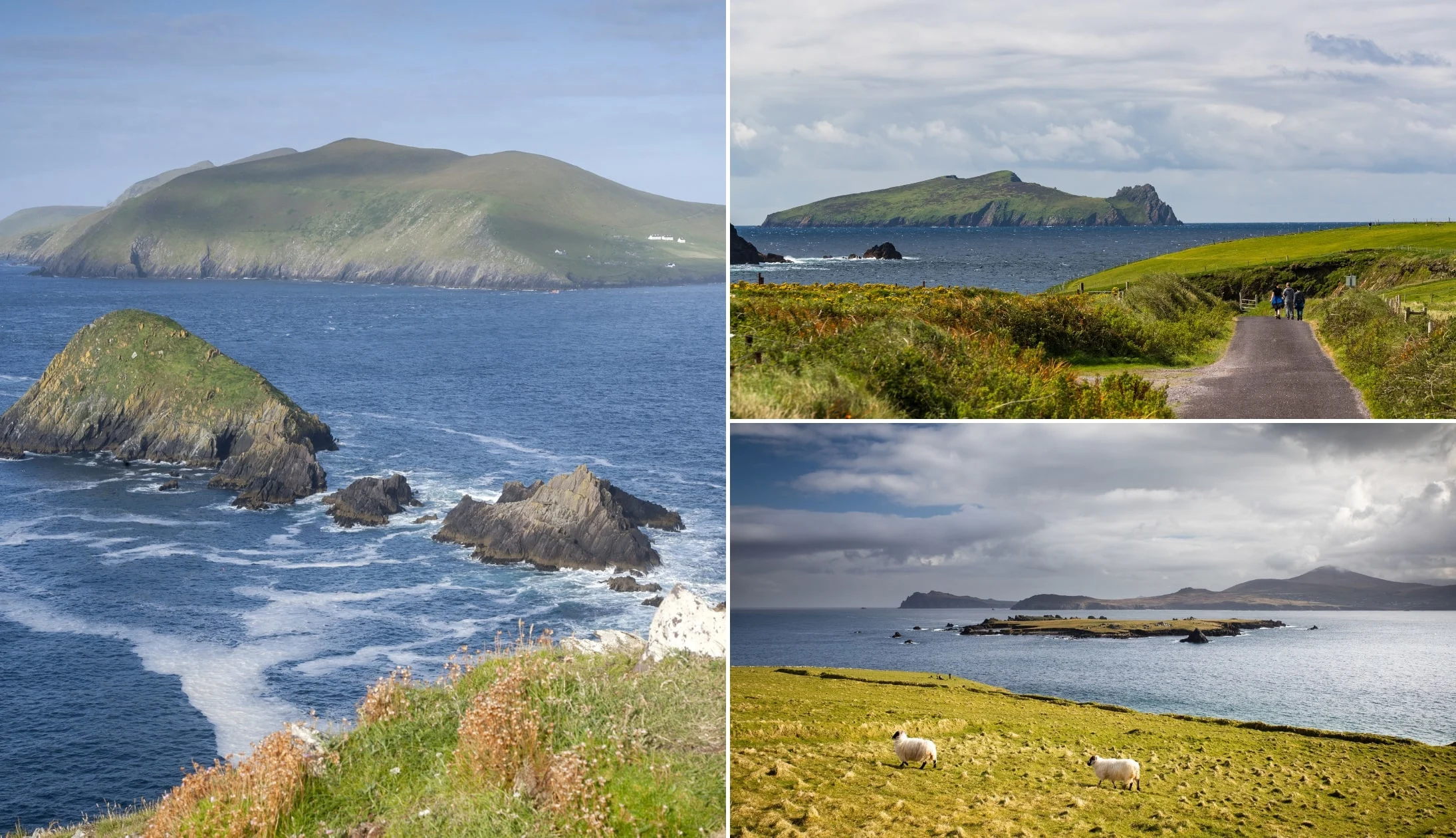
Photos via Shutterstock
Get ready for an action-packed day, as you’re going to be touring the marvellous Dingle Peninsula. There are several Dingle tours leaving from Killarney, but we’ve selected what we think is the best one (see the link below).
The peninsula is on the country’s southwest coast, with rugged coastline, lovely beaches, and rolling green hills.
If you book onto this 6.5-hour guided tour you’ll be taken to the peninsula’s main attractions, including Slea Head and Dingle Town.
Start with a nice breakfast in Killarney before heading on the tour. We’d recommend getting something to eat where you’re staying or heading to JM Reidy’s or the Shire Bar, which both do a great breakfast.
We’ll take you through the stops below, but note that 1, you may not always physically stop at all of these sights and 2, these tours are subject to change, so always check with the provider in advance.
Stop 1: Dingle Town
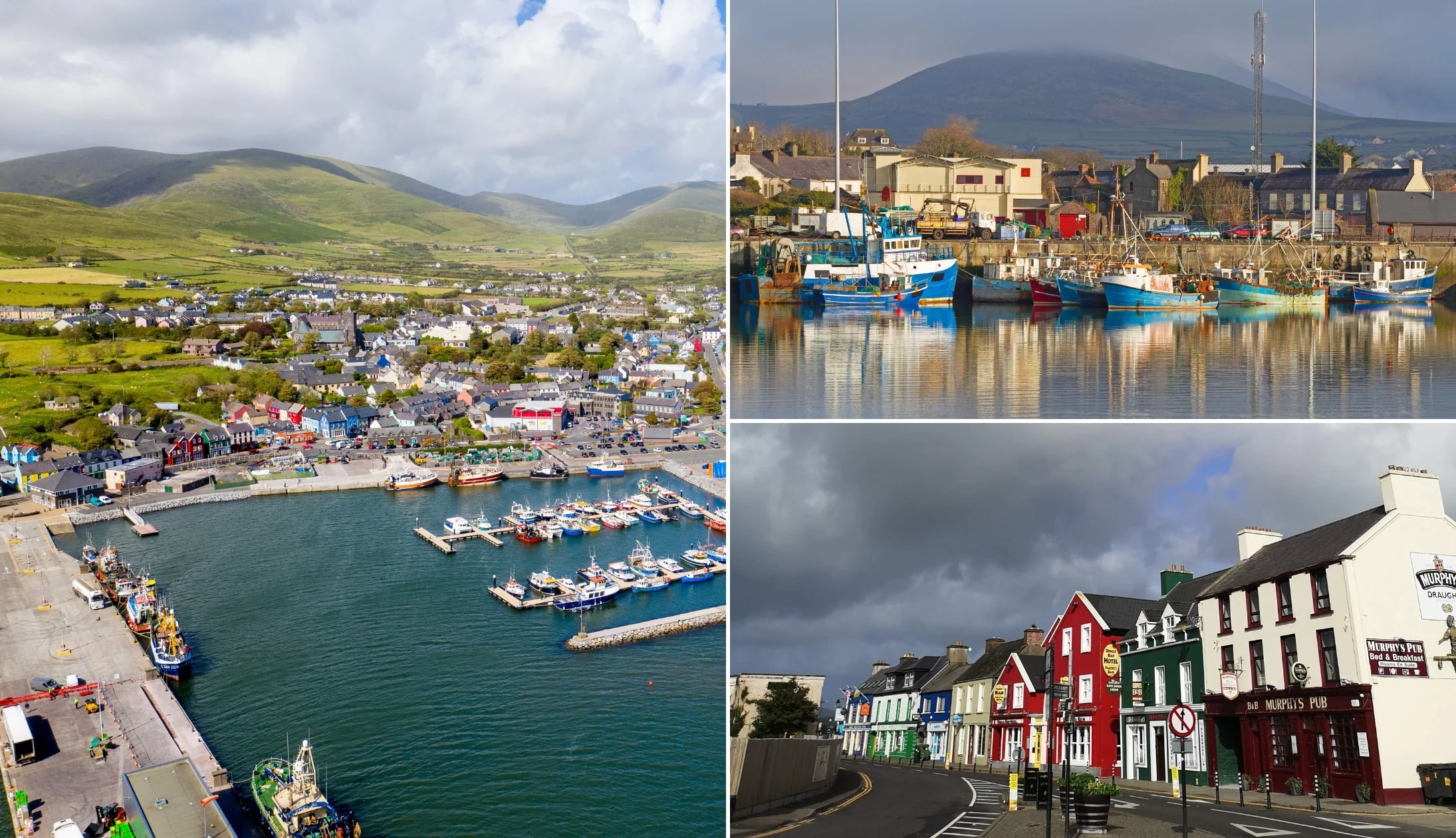
Photos via Shutterstock
Dingle Town is arguably one of the most popular towns in Ireland. It’s a colourful place on the shores of the Atlantic with a small harbour, lots of rural Irish charm, and great pubs!
Following the Norman invasion of Ireland, Dingle Town became a port, and by the 13th century, it was hugely busy, exporting more goods than Limerick. Today, its main economic activities are tourism, fishing, and agriculture.
Historically, Dingle Town has had strong ties with Spain, thanks to the Treaty of Dingle (1529), signed by the 11th Earl of Desmond and the ambassador of Emperor Charles V.
The treaty gave Irish citizens rights in Habsburg-controlled territories (Spain, the Netherlands, and Austria).
Stop 2: Slea Head
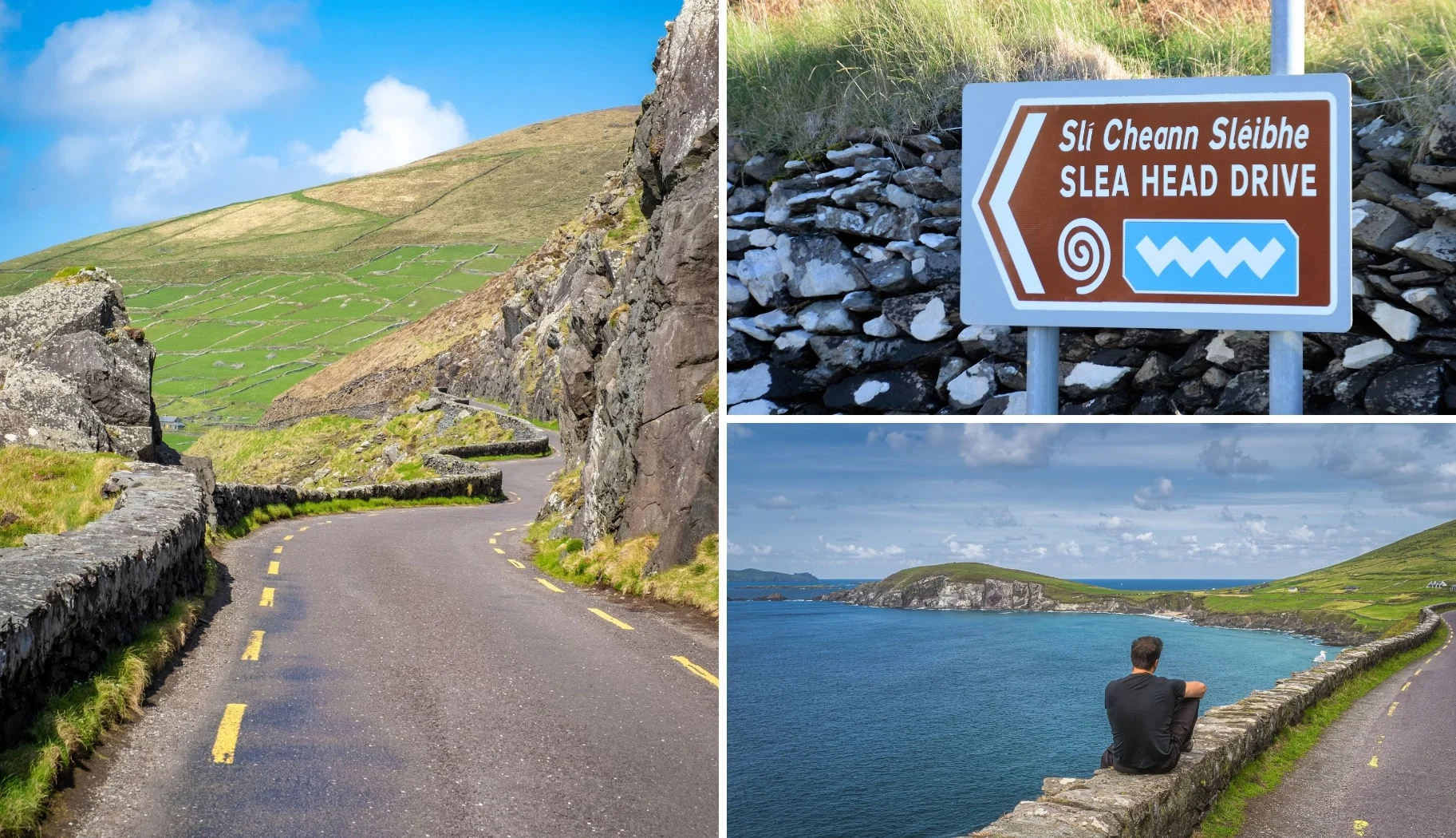
Photos via Shutterstock
Slea Head is a picturesque peninsula and one of the most westerly points in Europe. The views here are stunning and you’ll be able to look out to Blasket Island across the Atlantic.
Take some time to admire the views and look out for the iconic White Cross on the side of the road.
Stop 3: Blasket Islands views

Photos via Shutterstock
Although you won’t actually be visiting the Blasket Islands, you will have some great views from Slea Head so it’s worth knowing a little about them!
The Blasket Islands were the last islands in the country that had a significant Irish population. Sadly, due to dwindling numbers, they were abandoned in 1954.
During the 19th and 20th centuries, many writers visited the islands to document the islander’s traditional way of life, and there are several books about them.
All in all, there are six islands, the largest being Great Blasket Island and the smallest, Beginish.
Stop 4: Gallarus Oratory
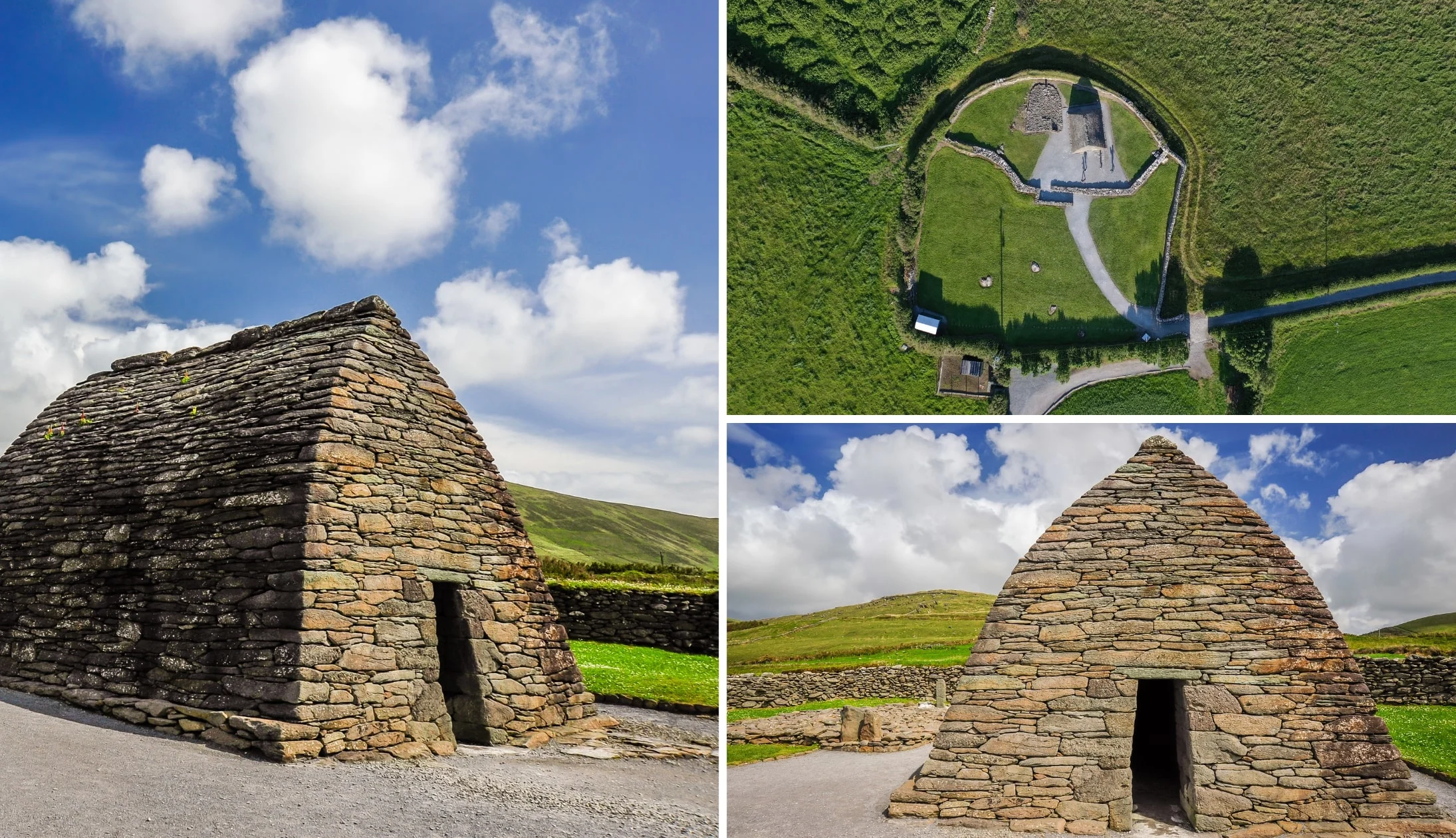
Photos via Shutterstock
Gallarus dates back to the 7th and 8th centuries. The stone church is an interesting shape, with the stones laid out at an angle to allow water to run off easily.
According to legend, if you climb out of the building through the window, your soul will get cleansed. The only drawback is that the window is absolutely tiny – 18cm long and 12cm wide!
Stop 5: Back to Killarney for the night

Photos via Shutterstock
From Gallarus, it’s around a 1-hour-and-20-minute-drive back to Killarney.
Our dinner recommendations
There are some exceptional restaurants in Killarney. Our favourites are the Mad Monk (they serve amazing seafood like sizzling crab claws and deep water prawn tagliatelle), Kitty O’Se (splash out on the Seafood Tower to share), and Murphy Browns (hearty Irish dishes like roasted duck and fish and chips).
Our pub recommendations
There’s some mighty old-school pubs in Killarney, too. For post-dinner drinks, head to JM Reidy’s, the Laurels Pub, or O’Connors.
They all have a traditional pub feel and are a great choice for a pint. JM Reidy’s has a lovely courtyard which is great in the summer, and O’Connors is perfect if you feel like cocktails.
If you want to hear some live music, JM Reidy’s and O’Connors often have live music sessions.
Day 7: The trip to Limerick City
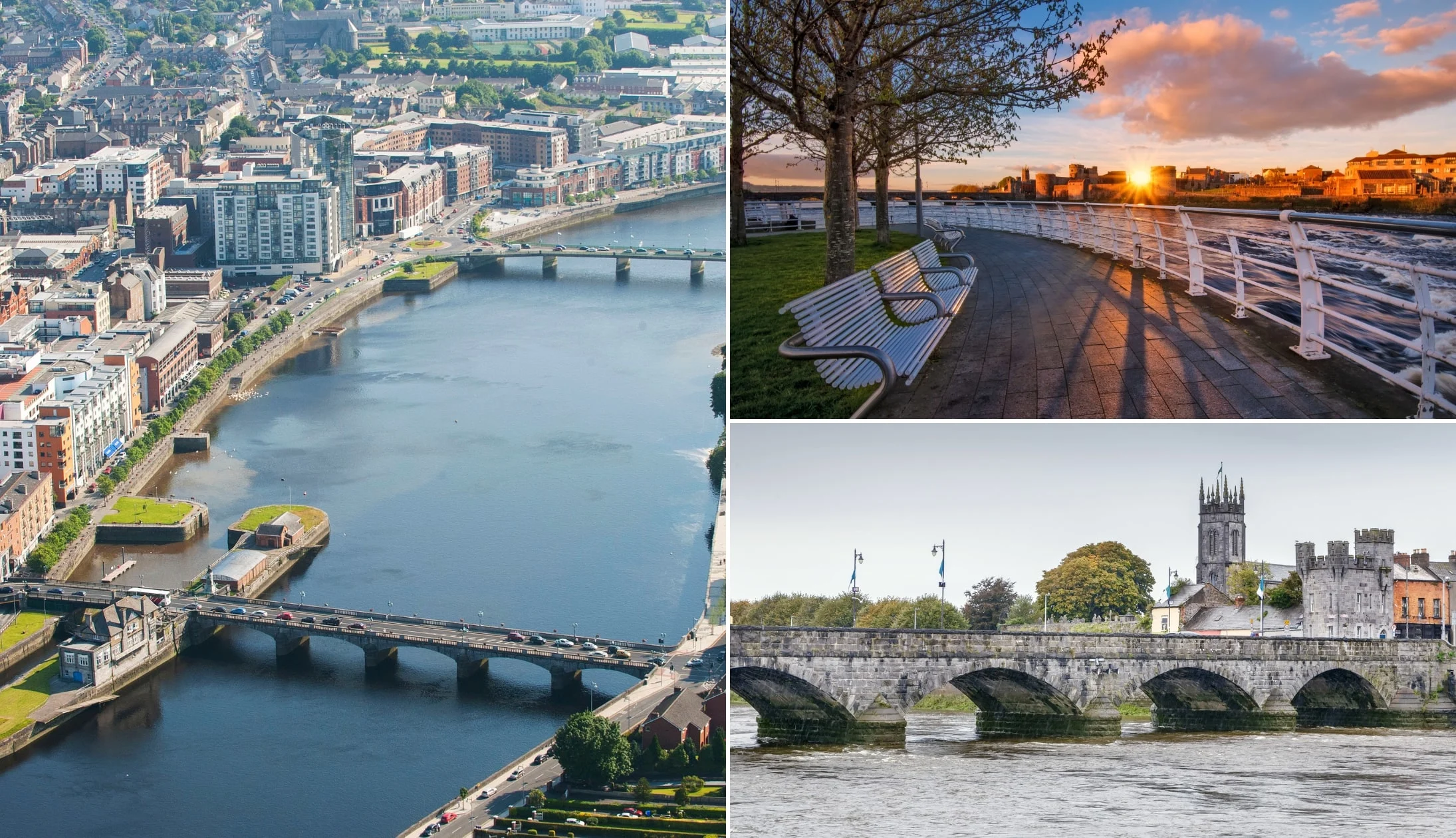
Photos via Shutterstock
Today we are heading to Limerick City, where we will spend one night before heading up to Galway. Check out our accommodation recommendations below:
Grab some breakfast at your accommodation or nearby and then head out.
Recommended accommodation in Limerick
- Budget: Woodfield House Hotel (15-minute walk from the city with excellent reviews) and Shelbourne House (cosy spot 20 minutes walk from the castle)
- Mid-range: Limerick City Hotel (very central hotel near the river) and The Bedford (very central boutique townhouse with exceptional reviews)
- Luxury: The Savoy Hotel (central, boutique 5-star) and The George (central spot on O’Connell Street in Limerick city centre)
Getting to Limerick from Killarney
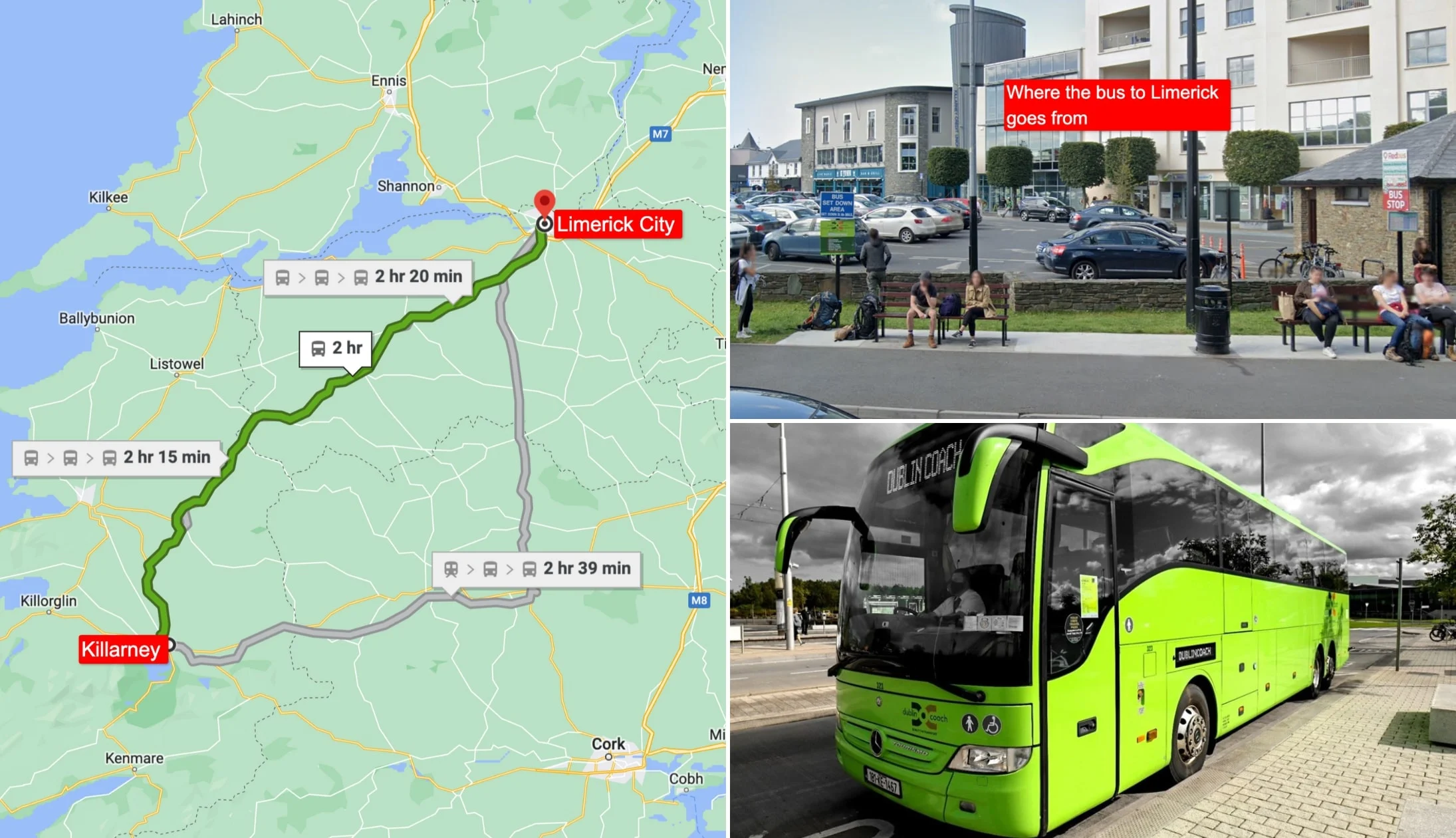
Photo left and top right: Google Maps. Bottom right: Dublin Coach
You can take either the bus or train to Limerick. We have outlined both options below.
Option 1: Bus
We recommend that you take the Dublin Coach to Limerick. I know what you’re thinking, Dublin Coach? But I’m in Killarney going to Limerick! That’s the name of the bus company. They are big green buses that are comfortable, affordable and quick. The trip from Killarney to Limerick takes one hour and 40 minutes. The bus stops a couple of times, so make sure you get off at the right stop, but the drivers are friendly and will help you out.
Option 2: Train
You can also take the train from Killarney to Limerick, but we recommend that you take the bus instead. The train between the two takes at least three hours and has two changes (usually Limerick Junction and Mallow). The bus is a lot quicker and more straightforward.
Stop 1: The Hunt Museum
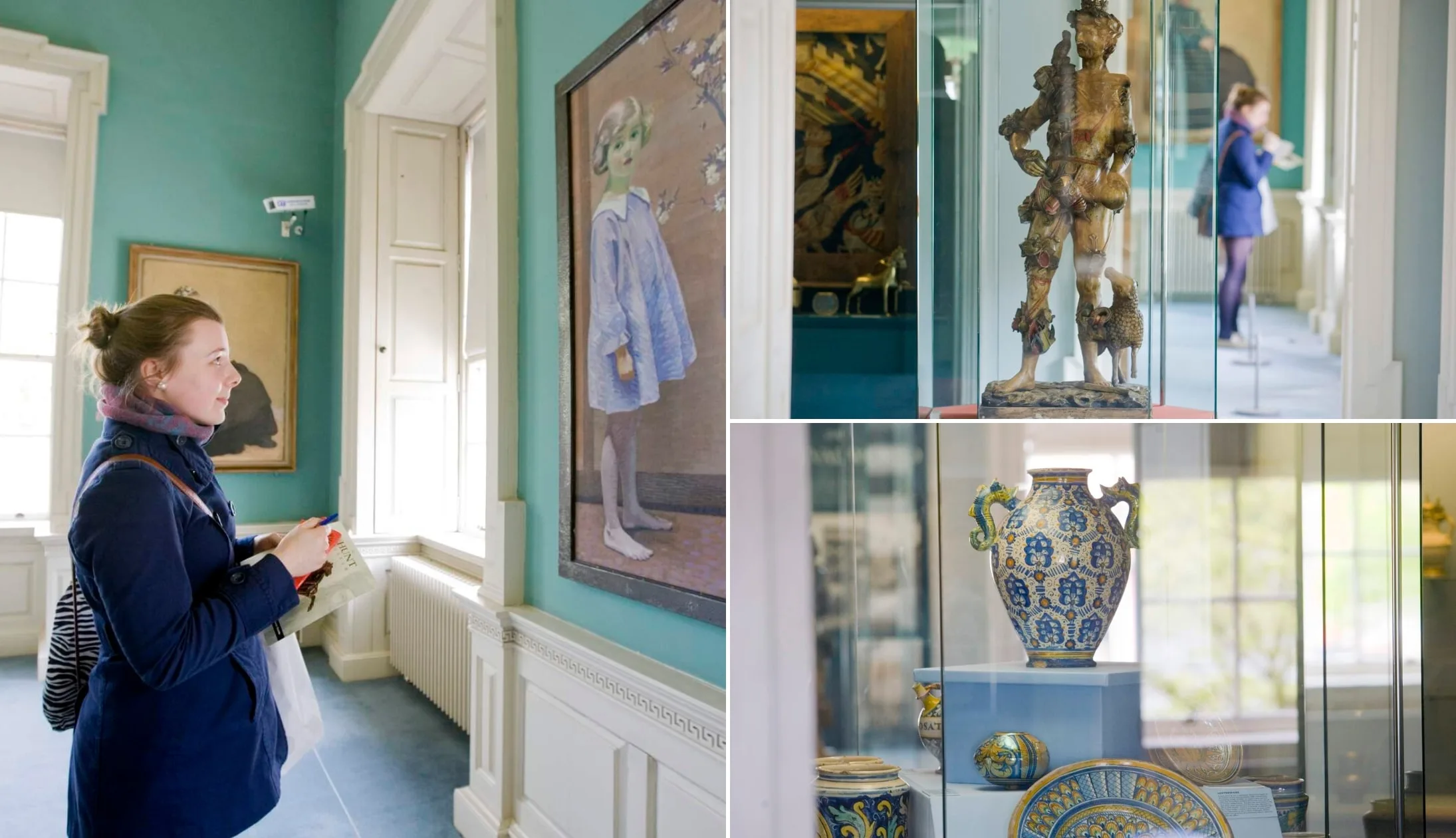
Photos via Tourism Ireland’s Content Pool
Your first stop in Limerick city is the Hunt Museum, right on the outskirts of the city centre.
The Hunt Museum was established after John and Gertrude Hunt decided to donate items from their personal collection to the people of Ireland.
The museum has a large collection with over 2,500 artefacts, including pieces from Ancient Egypt and Stone-Age Ireland. Highlights of the collection include works by Picasso and dresses by famous Irish fashion designer Sybil Connolly.
Recently, the museum launched the “Museum in a Garden”, a beautiful garden dotted with 3D printed replicas of historical artefacts (you can grab a ticket online here).
Stop 2: Lunch
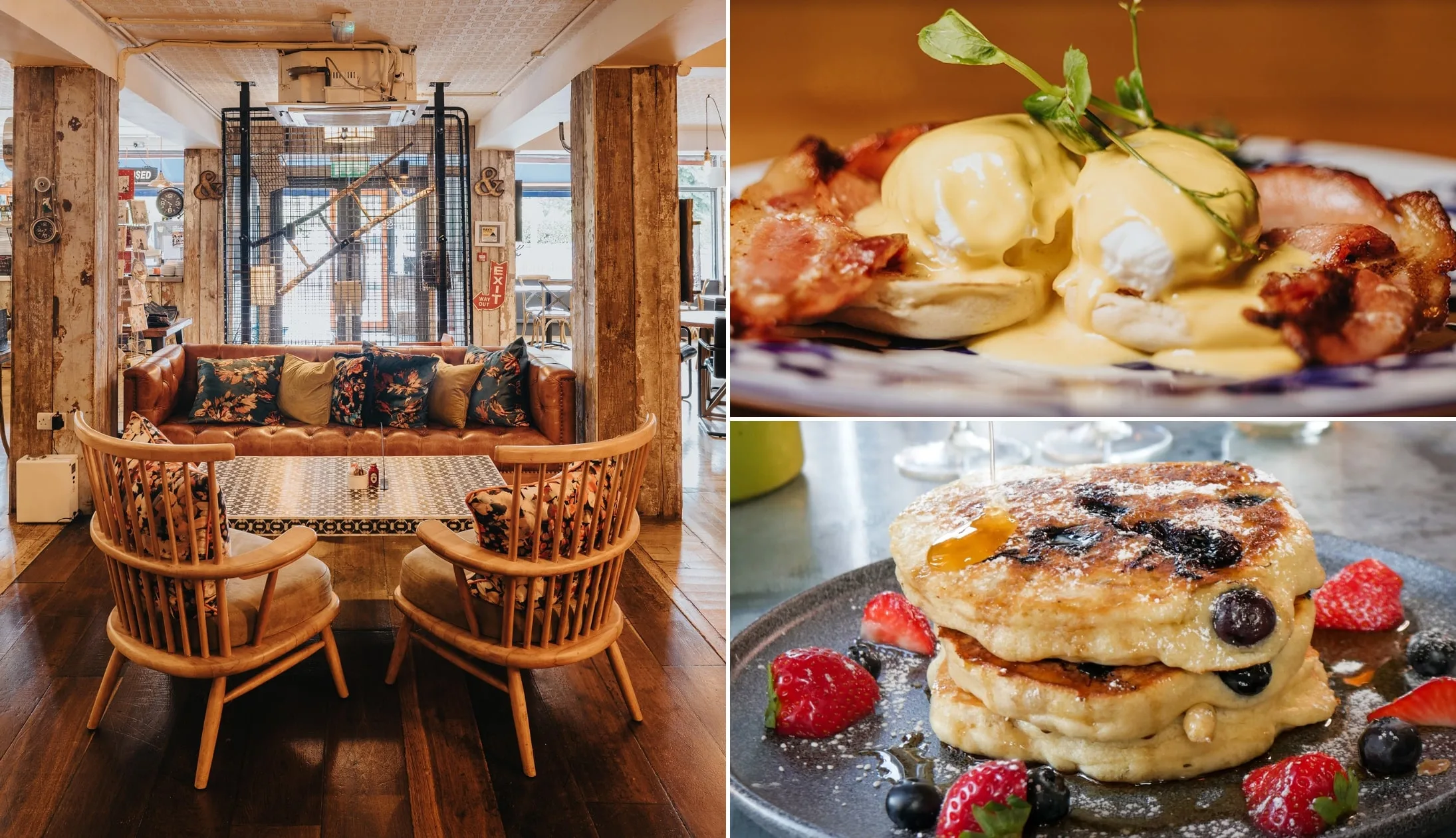
Photos via Hook and Ladder on FB
It’s probably close to lunchtime by now, and we’ve got a couple of suggestions for you. We usually head to The Little Red Hen, The Buttery, or the Hook and Ladder when we’re in the city. The Little Red Hen is a contemporary bar with some delicious pizzas and dirty fries on the menu. The Buttery is our go-to for brunch, and the Hook and Ladder (the one on Sarsfield Street) has delicious sandwiches and a mouth-watering vegan burger.
Stop 3: King John’s Castle
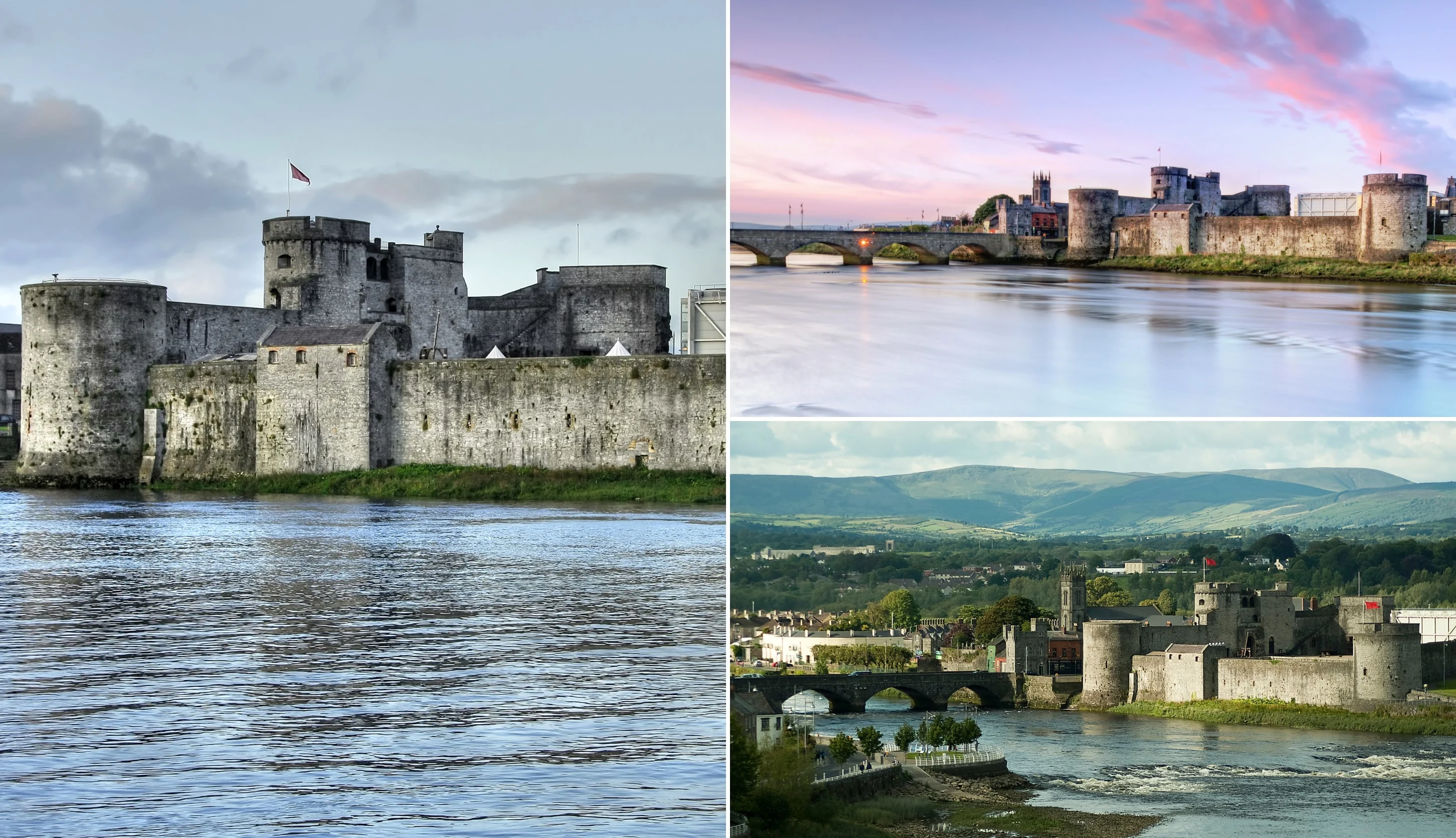
Photos via Shutterstock
Head off to King John’s Castle, a 10-minute walk from the centre of the city. The 13th-century castle sits on King’s Island, on the banks of the River Shannon. The castle is in fantastic condition and is one of Europe’s best-preserved Norman castles.
King John’s Castle was built under the orders of King John, the “Lord of Ireland” and Richard the Lionheart’s brother. It was built between 1200 and 1212, with numerous repairs and extensions over its 800-year history.
The castle was a military stronghold with solid curtain walls, turrets, and strong fortifications. However, despite this, it sustained heavy damage during the 1642 siege of Limerick (the first of five Limerick sieges during the 17th century). There’s a fantastic exhibition on the siege inside the castle if you’d like to learn more.
Most people spend around one and a half hours visiting the castle and visitor centre. You can have a look at the interactive exhibits, try on historical costumes, and in the summer, play Medieval games in the courtyard!
Stop 4: Treaty City Brewery
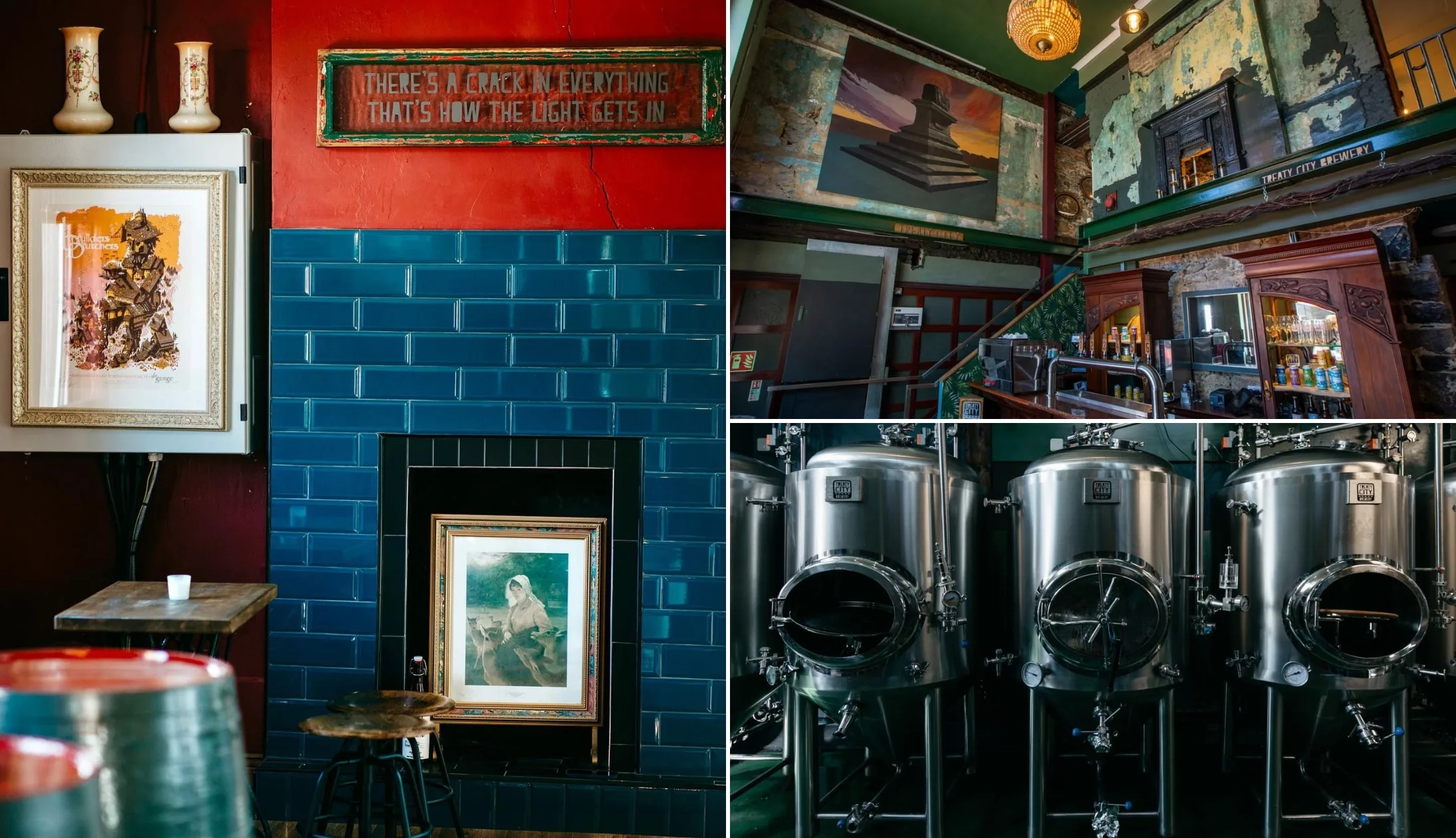
Photos via Treaty City Brewery on FB
The Treaty City Brewery is right across from King John Castle. It is inside what used to be a derelict building that was transformed into a beautifully modern brewery.
They offer an Ultimate Tour, where guests will be shown around the artisan brewery, learn about the brewing process from Master Brewers, followed by a complimentary beer tasting!
Stop 5: St Mary’s Cathedral
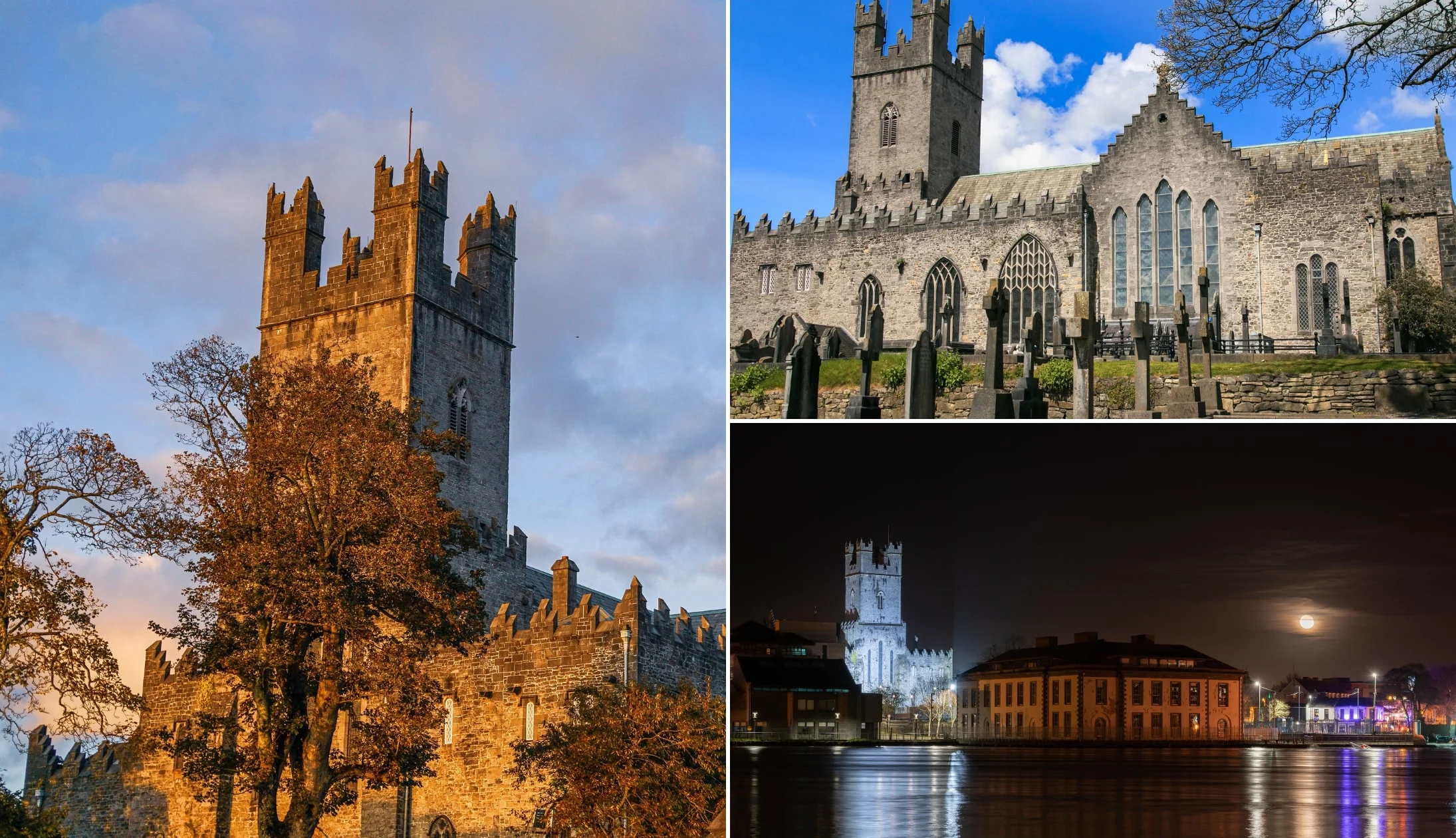
Photos via Shutterstock
The next stop is St. Mary’s Cathedral. It’s a three-minute walk from King John’s Castle and the brewery (you probably passed it on your way to the castle). The cathedral was founded in 1168, making it even older than King John’s Castle and the oldest building in Limerick that’s still in use today!
The cathedral contains six chapels, but if you’re pressed for time, the Lady Chapel is a must-visit. The Lady Chapel contains its original pre-reformation altar, which is four metres long and weighs three tons. During the mid-1600s, the altar was removed and dumped by Oliver Cromwell’s troops when they captured the city. But, by some miracle, it was recovered in the 1960s and reinstated to its rightful place.
Another highlight of St. Mary’s Cathedral is its misericords (small wooden carvings). They are the only complete set in Ireland and the only remaining pre-Elizabethan carvings.
Stop 6: Dinner, drinks and live music
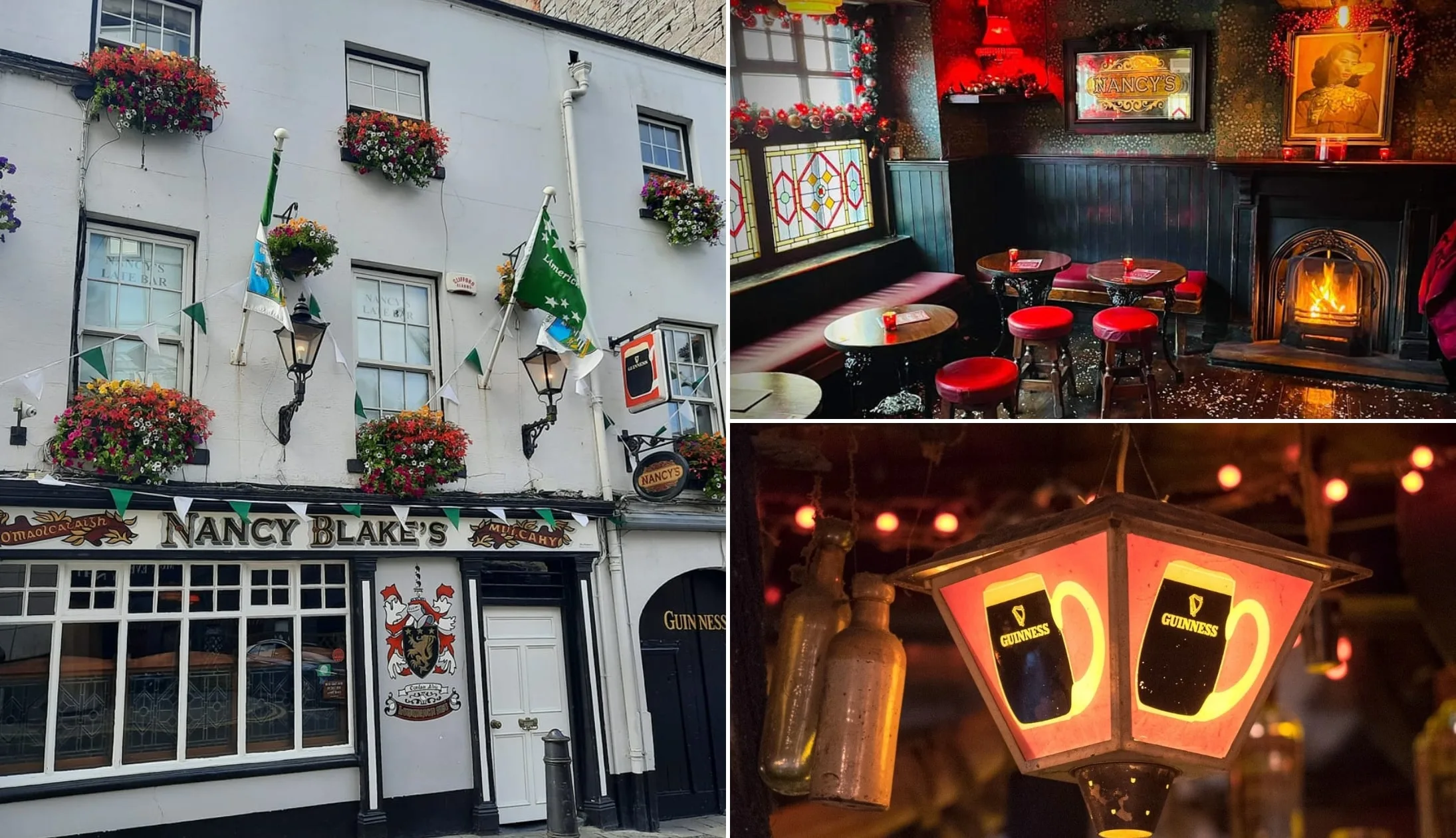
Photos via Nancy Blakes on FB
There’s some excellent restaurants in Limerick and there’s some mighty old-school pubs in Limerick, too.
Our Limerick food recommendations
Our absolute favourite spot for dinner is the Curragower. It’s right on the banks of the River Shannon with beautiful views of King John’s Castle across the water.
Grab some delicious pub grub like the roasted lamb rump or the lightly breaded scampi, then stick around for some pints after dinner.
Otherwise, we also like SpitJack (the rotisserie pork belly is a customer favourite) and The Locke (they have a delicious steak and ale pie and great vegetarian options).
Our Limerick pub recommendations
For drinks, again, we love the Curragower but Tom Collins is another lovely pub.
Another great trad pub is Nancy Blakes and depending on the night, they might have some music on.
However, if you don’t mind heading a little out of the city centre, then Charlie Malones is a must-visit. In our opinion, it’s one of Limerick’s best-kept secrets, with a real old-school pub vibe.
Limerick is a great city for trad music. The Locke often has music and even dancing on some nights if you’re lucky! Dolans is also great, but it’s a short walk from the city centre.
Day 8: The trip to Galway
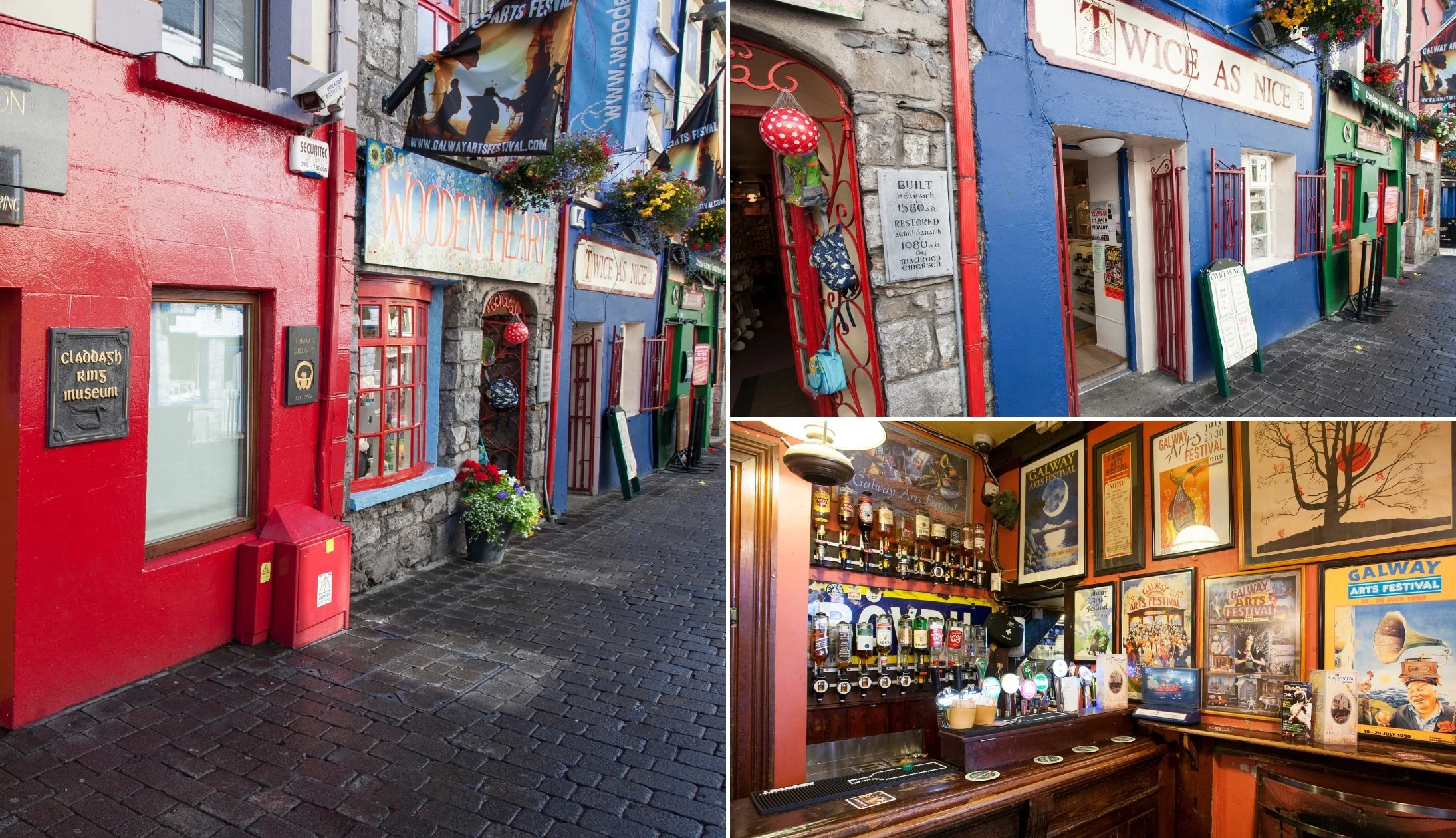
Photos by Stephen Power via Ireland’s Content Pool
Today we are heading to Galway, where we will spend two nights before you head back home.
Before you head off on your trip, grab a hearty breakfast from where you’re staying, or venture out into the city for some grub. The Hook and Ladder is a personal breakfast favourite of ours (the breakfast burrito is amazing).
Recommended accommodation in Galway
- Budget: Feeney’s Audubon Lodge (in Salthill outside of the city by the sea) and Corrib View Guesthouse (a 45-minute walk from Eyre Square)
- Mid-range: Balcony House B&B (10-minute walk from Eyre Square) and Ash Grove House (gorgeous guesthouse near Galway Cathedral)
- Luxury: The G Hotel (luxury hotel in the city) and Glenlo Abbey (one of Ireland’s top hotels – 15-minute drive from the city)
Getting from Limerick to Galway

Photos via Google Maps
You have two options, again, to get to Galway – bus or train. The bus is pretty straightforward, just long. If you are going to take the train, you need to make sure that you have booked a direct train.
There are direct trains a couple times a day. Unfortunately, you can also inadvertently book trains that take you all the way to Dublin first before taking you to Galway so make sure to check first.
Option 1: Bus
Citylink and Expressway both do buses between Limerick and Galway. The bus is around one and a half hours and is very straightforward.
Option 2: Train
If you book a direct train from Limerick to Galway, you’re laughing! If you don’t, you’ll end up in Dublin… before having to get on a train back across the country to Galway. Be careful when booking.
Stop 1: Check-in, get lunch and decide between walking or the bus
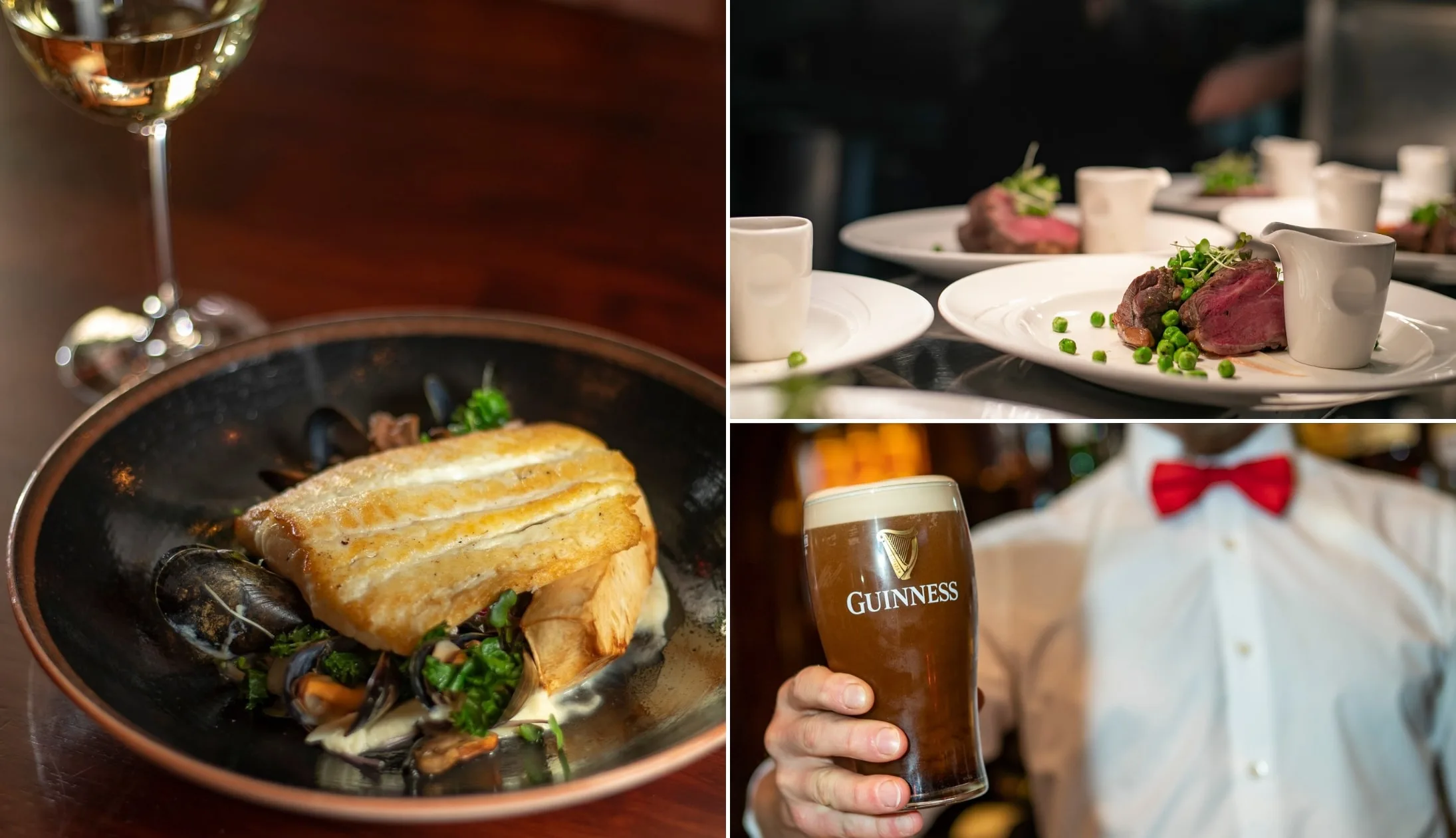
Photos via Blakes Bar Galway on FB
When you land in Galway, head to your accommodation, get checked in and head for lunch.
By now, you must be hungry. There are heaps of brilliant places for lunch in Galway, but if you don’t want the hassle of finding somewhere to eat, we’ve got a few suggestions!
We recommend Blakes Bar (traditional pub grub), Zappis (authentic Italian cuisine), or Tigh Neachtain (Irish and international cuisine).
Now, Galway is a very walkable city, but if it’s raining or if you fancy getting dropped to the ‘main’ attractions the hop-on/hop-off bus tour is well worth buying.
Regardless of which option you choose, here are some of our favourite sites in Galway City (we’ve listed them in a logical way for you to walk between them).
Stop 2: Galway Cathedral
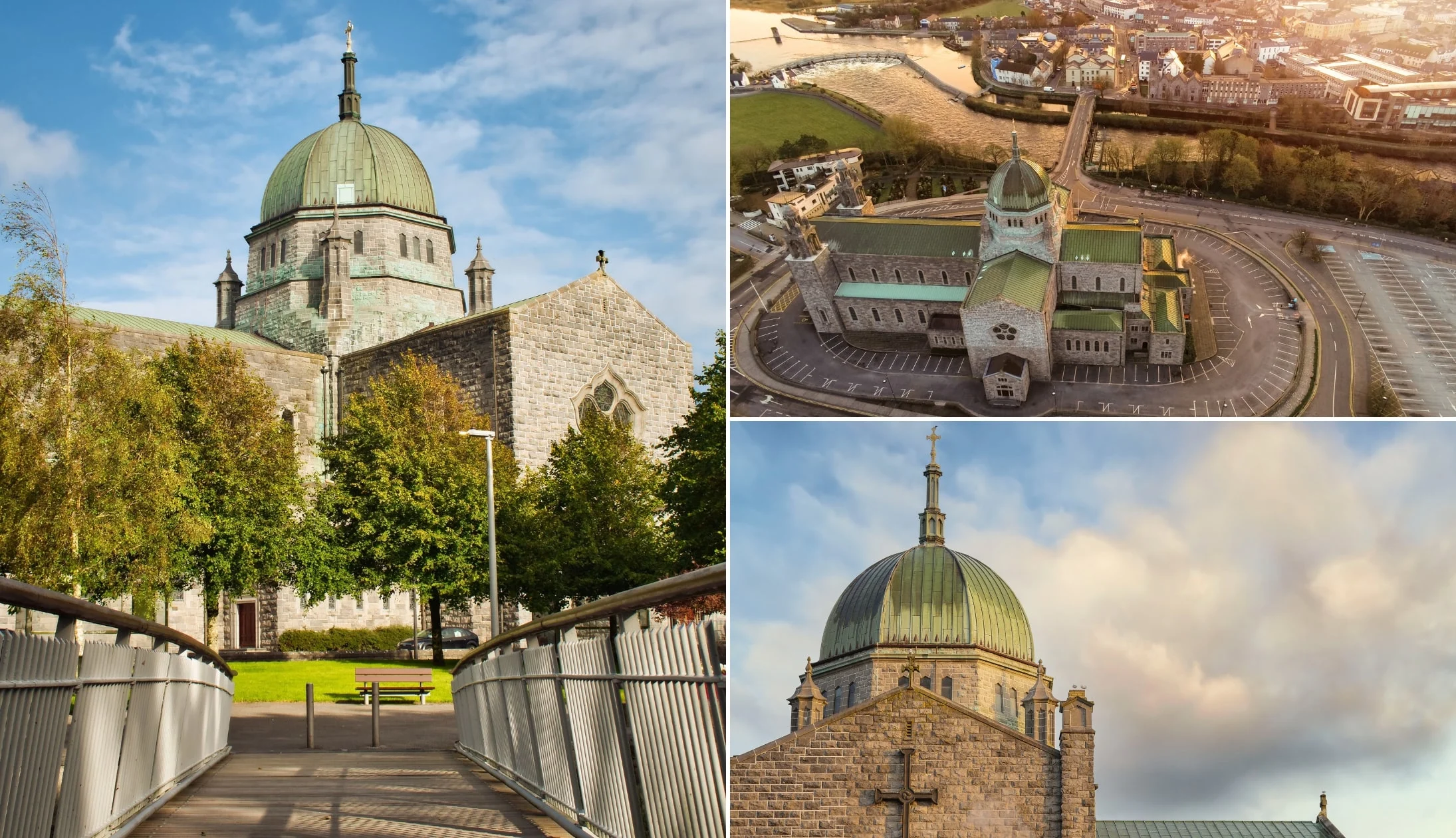
Photos via Shutterstock
Galway Cathedral is wonderfully impressive both inside and out. It’s arguably the jewel in the Galway City skyline and you’ll cop it from many places as you stroll around the city.
Interestingly enough, it’s not as old as it looks, and construction on the building was only completed in 1965, earning it the title of ‘the last great stone cathedral to be constructed in Europe’.
The cathedral is free to enter, but visitors are asked for a donation of €2 to help with the building’s upkeep.
Stop 3: Quay Street and the Latin Quarter

Photos by Stephen Power via Ireland’s Content Pool
Galway’s colourful streets are an absolute joy the ramble along regardless of the time of year.
If you’re walking from the cathedral, you’re a short stroll away from the Latin Quarter and Quay Street where you can have a nosey around.
These streets are alive with the buzz from tourists and locals alike.
Stop 4: The Hall of the Red Earl
One of our favourite places to visit in Galway (especially if it’s raining!) is the Hall of the Red Earl.
The Hall of the Red Earl is one of Galway’s most interesting sites. The ruins date back to the 13th century, with ties to the founding of Galway and the Anglo-Norman De Burgo family.
It was the first municipal building in the city, used for collecting taxes, hosting banquets, and sentencing criminals.
The Hall of the Red Earl was lost as the city grew until 1997, when the ruins were unearthed by archaeologists on behalf of the Office of the Public Works.
Today, you can walk amongst the ruins, view the artefacts, and learn about the hall’s history from the informative displays.
Stop 5: Galway City Museum
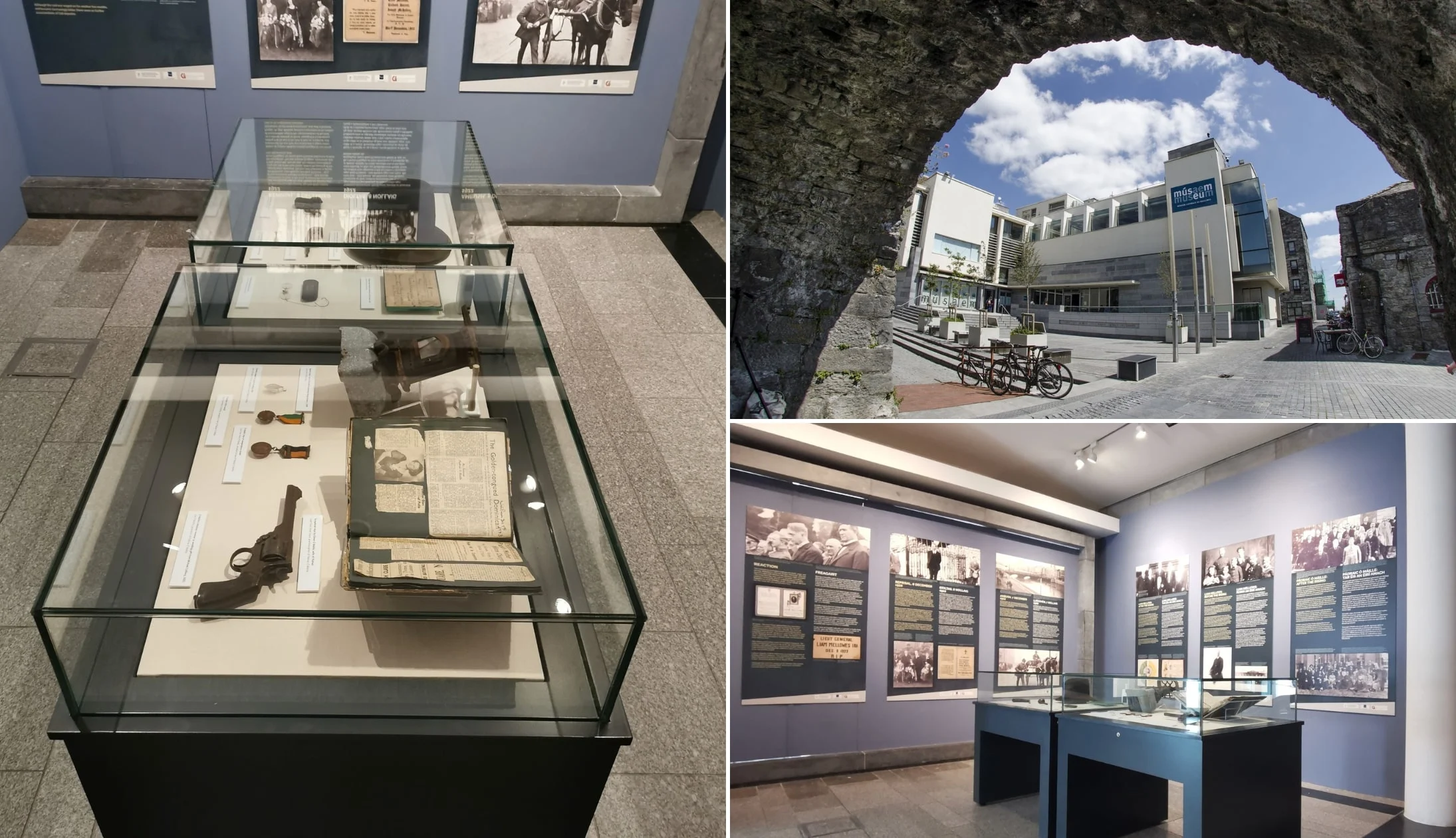
Photos via Galway City Museum on FB
The Galway City Museum is just a stone’s throw from the Spanish Arch. It’s one of the best places to learn about Galway’s history, culture, and archaeology, with collections telling the story of prehistoric Galway all the way through to 19th and 20th-century Galway!
The museum has three floors and seven long-term exhibitions, including The Wild Atlantic – Sea Science, and an exhibition on Pádraic Ó Conaire.
It’s free to visit, although donations are always appreciated.
Stop 6: Spanish Arch and the Long Walk
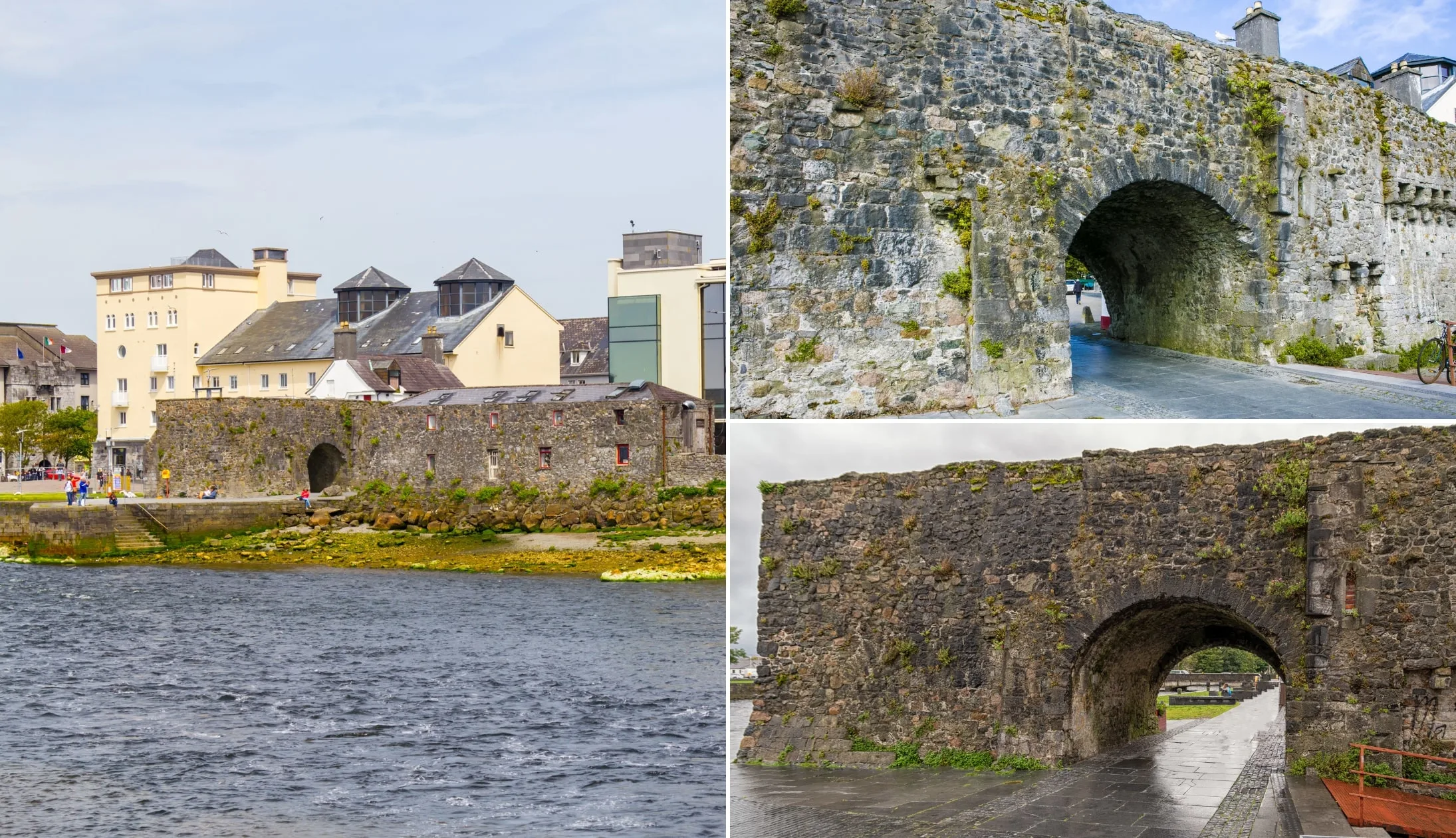
Photos via Shutterstock
The Spanish Arch is a must-see Galway attraction, dating back to Medieval times. The large stone arch is located on the outskirts of the city centre, overlooking the Claddagh (shore).
It originally housed soldiers who were keeping watch on the city’s Medieval walls. Its nickname is thought to come from the city’s merchant trade with the Spanish, whose ships would often be docked in the area!
From the Spanish Arch, you can take a short stroll alongside the water to what’s known as The Long Walk. You’ll likely have seen pictures of it (it’s a line of colourful buildings right on the water).
Stop 7: Galway City for the night
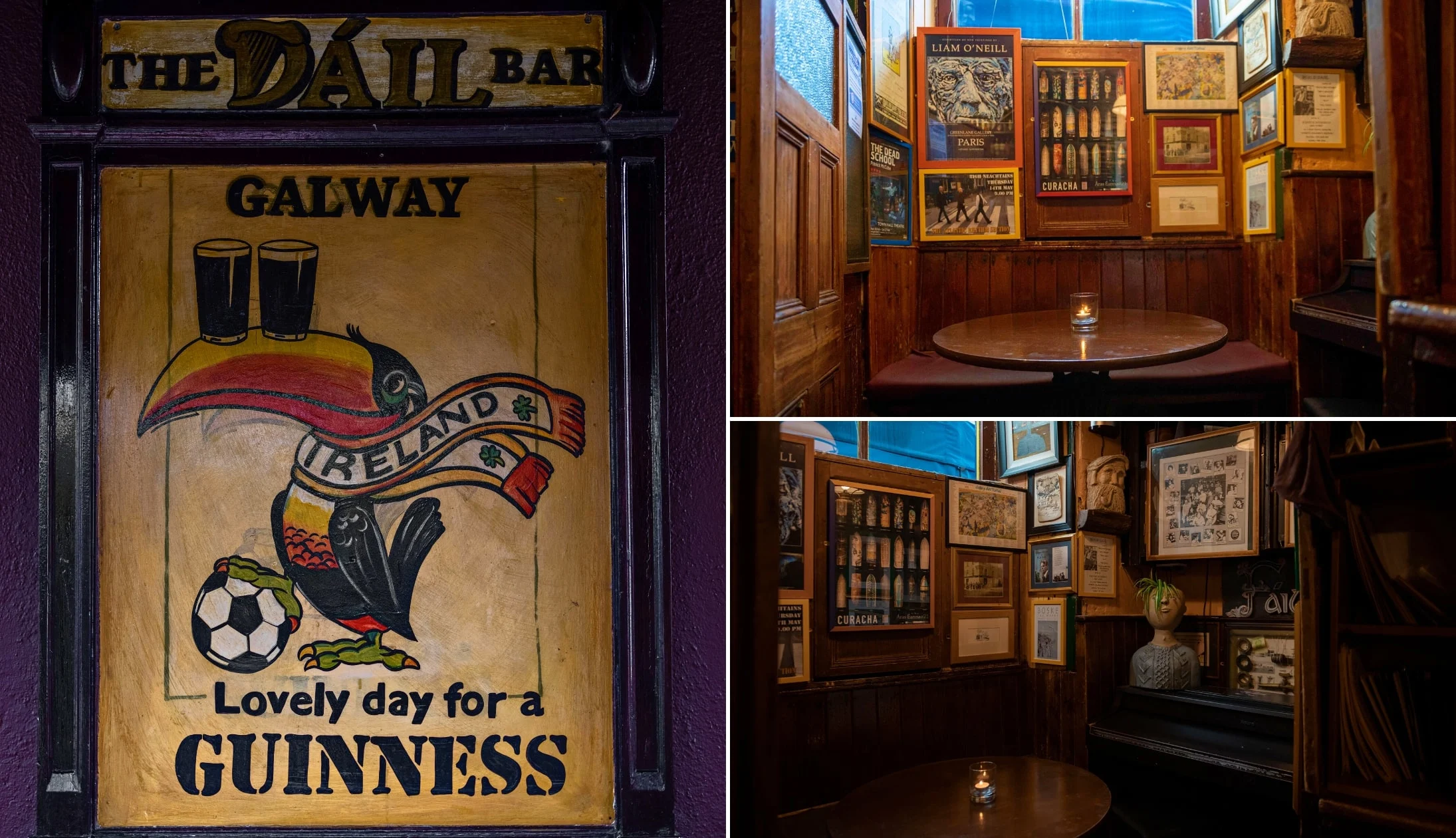
Photos courtesy Failte Ireland
Galway is a lively city regardless of the time of year. Here’s some spots worth checking out:
Our dinner recommendations
There’s some excellent restaurants in Galway – our favourites are Ard Bia, The Quay Street Kitchen, and Dela. Ard Bia is absolutely fantastic, but you need to book in advance for dinner.
The restaurant has a quirky interior and serves beautifully presented modern dishes.
The Quay Street Kitchen has a great selection of vegan and vegetarian-friendly dishes, and Dela has modern Irish cuisine on the menu.
Live music and trad bars
There’s some mighty pubs in Galway. After dinner, head out for drinks at either Tigh Neachtain or The Crane. Both are traditional pubs with a great atmosphere.
Trad music is an integral part of the city, with heaps of options to choose from. Our favourite spots are Crane Bar (mentioned above) and Tigh Chóilí.
Day 9: The Clare coast
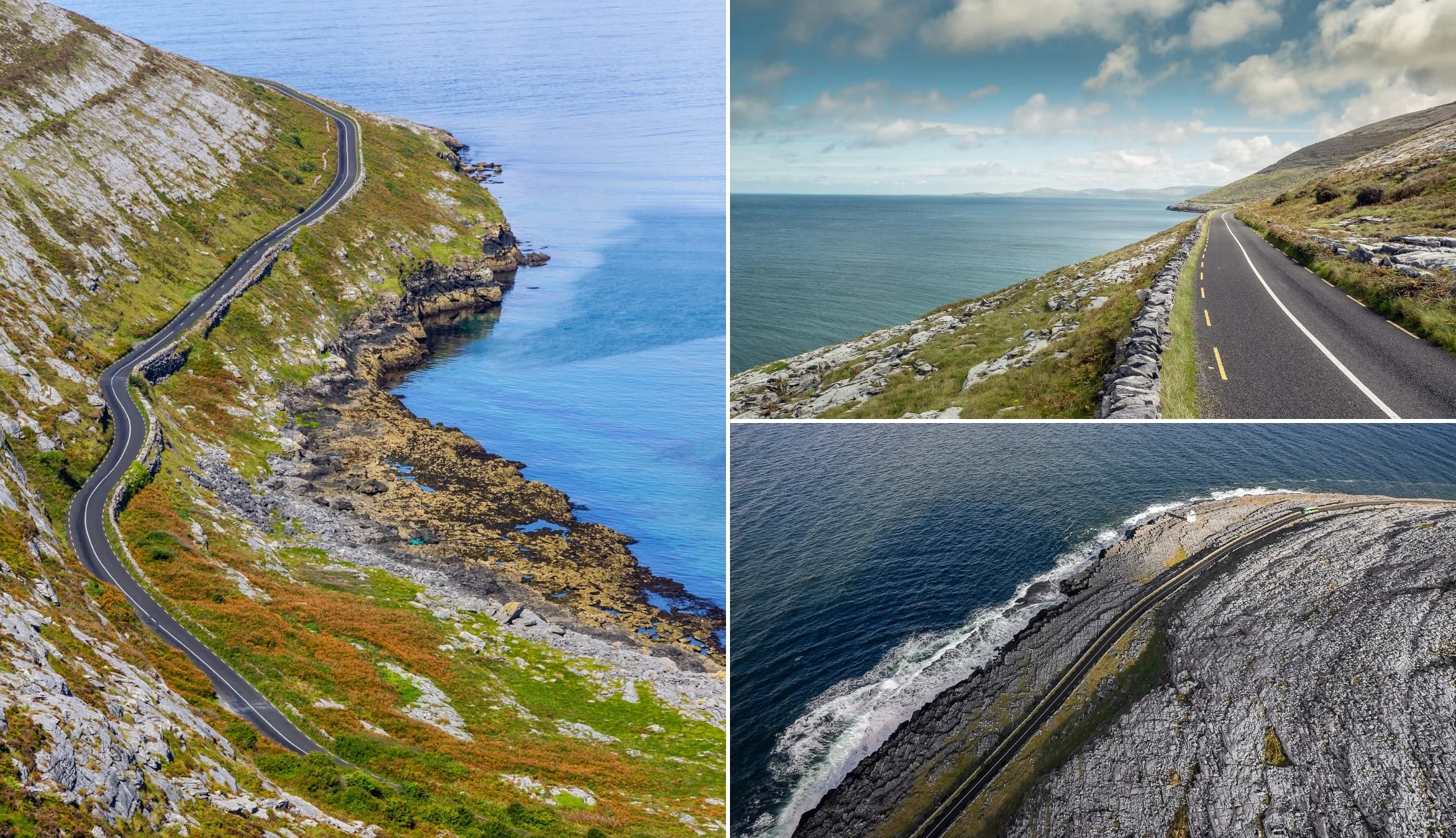
Photos via Shutterstock
It’s the penultimate of your 10 days in Ireland, and today, you’ll be taking a tour of North Clare. It’s a wonderful corner of the country, with beautiful landscapes and historical sites. It’s home to the Burren National Park and the Cliffs of Moher, one of the most popular natural tourist attractions in the country!
We’re recommending this 8-hour day trip from Galway City as it takes in a good chunk of Clare’s main attractions (and it has excellent reviews).
If you fancy a hearty breakfast, we’d recommend Pascal Coffee House (the pancakes are amazing) or Gaslight Brasserie (great for a full Irish or a breakfast burrito).
Keep reading below for an overview of the tour, but please note that 1, you may not always physically stop at all of these sights and 2, these tours are subject to change, so always check with the provider in advance.
Stop 1: Dunguaire Castle
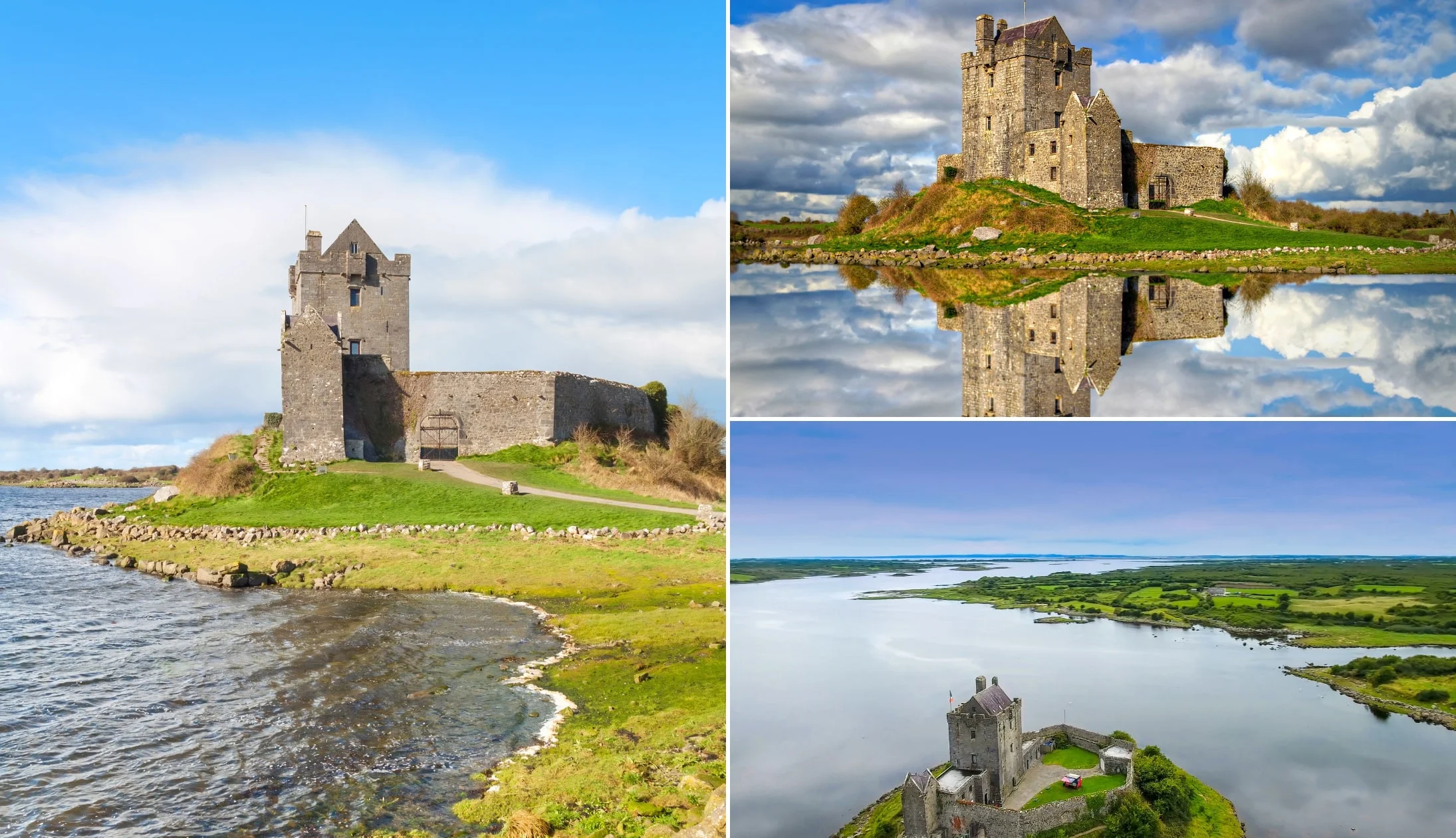
Photos via Shutterstock
The enchanting Dunguaire Castle sits on the shores of Galway Bay and has an impressive 75-foot tower.
According to legend, if you stand at the front gate and ask a question, you’ll have an answer by the end of the day!
The castle was built in 1520 and belonged to the O’Hynes clan. In 1912, the castle was bought by writer Oliver St. John Gogarty.
During his ownership, he restored the castle and hosted several famous writers, including W.B. Yeats and George Bernard Shaw.
Stop 2: Corcomroe Abbey
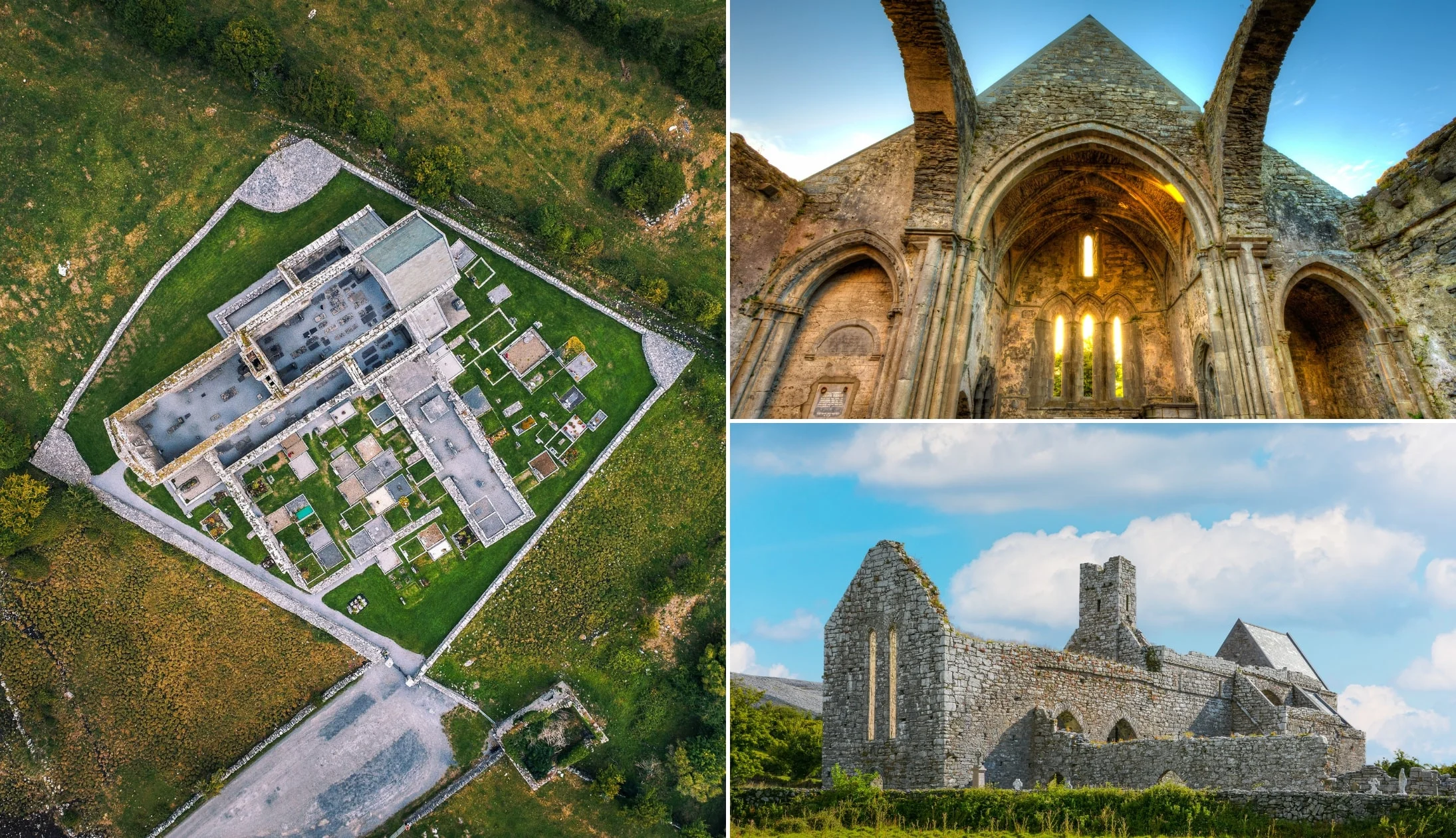
Photos via Shutterstock
Corcomroe Abbey is a late 12th/early 13th-century abbey ruin tucked away amongst the scenic Burren hills.
The ruins are in great condition and as you pass by, admire its Cistercian architecture set against the backdrop of lush green hills.
Stop 3: The Burren

Photos via Shutterstock
During the tour, you’ll be driving right through the Burren, a gorgeous landscape characterised by huge limestone plateaus.
The Burren is what is known as a karst landscape, a distinct landform that arises when carbonate rock (such as dolomite, marble, or limestone) is slowly dissolved by water, giving the land its unique shape.
In fact, the Burren is still being shaped by the rain to this day! Karst landscapes have sinkholes, caves, and underground streams, the Burren being no exception, with huge subterranean caverns below its surface.
The Burren is one of the best examples of karst landscapes worldwide, and it has a diverse range of flora and fauna thanks to its varied landscape.
Stop 4: Doolin Pier
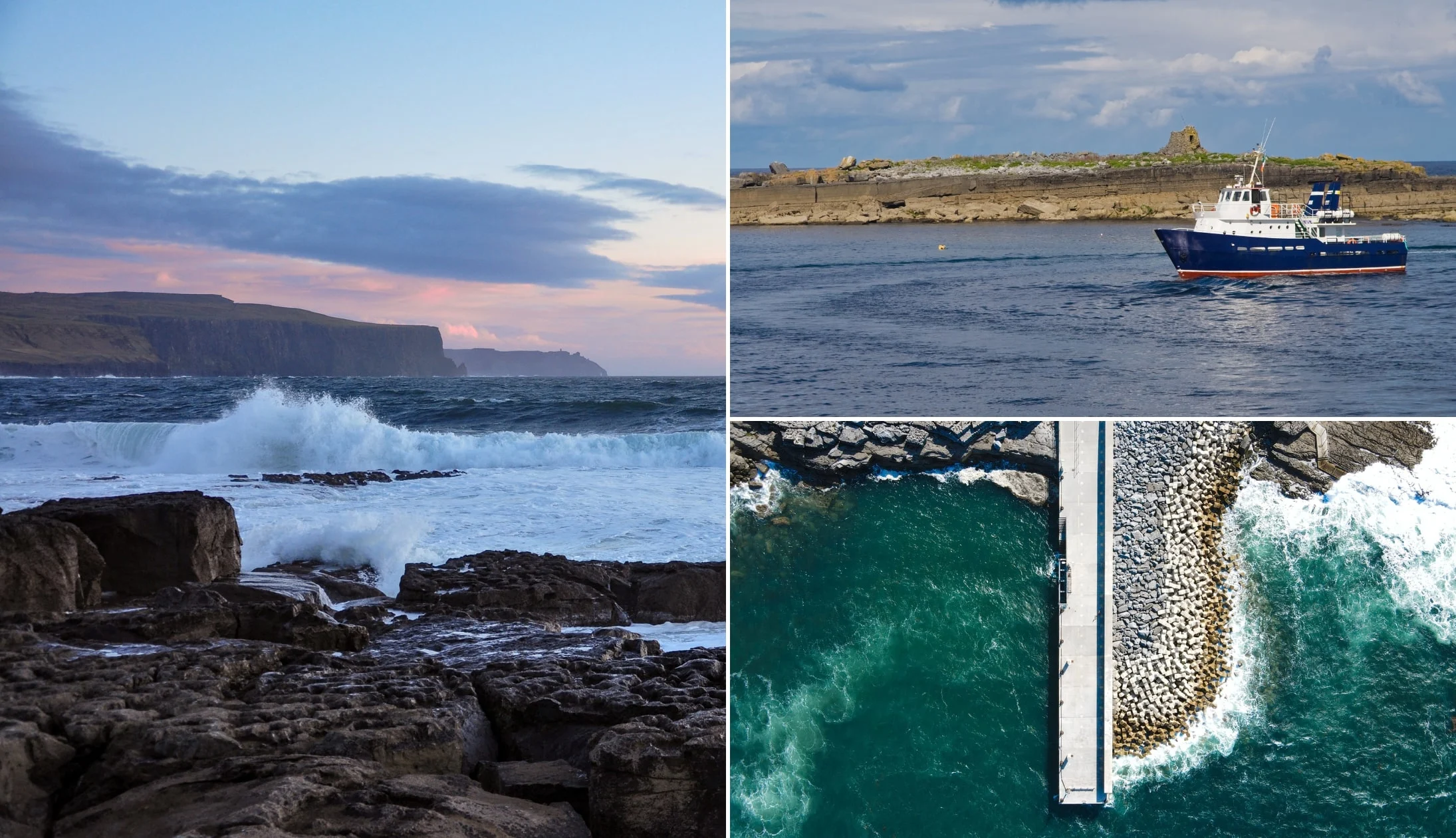
Photos via Shutterstock
You’ll then make a quick stop at Doolin Pier, the main access point to the nearby Aran Islands.
This place tends to be a hive of activity as the two ferry providers shuttle people to and from Inis Mor, Inis Oirr and Inis Meain (you’ll be visiting Inis Mor tomorrow).
Stop 5: Lunch at Hotel Doolin
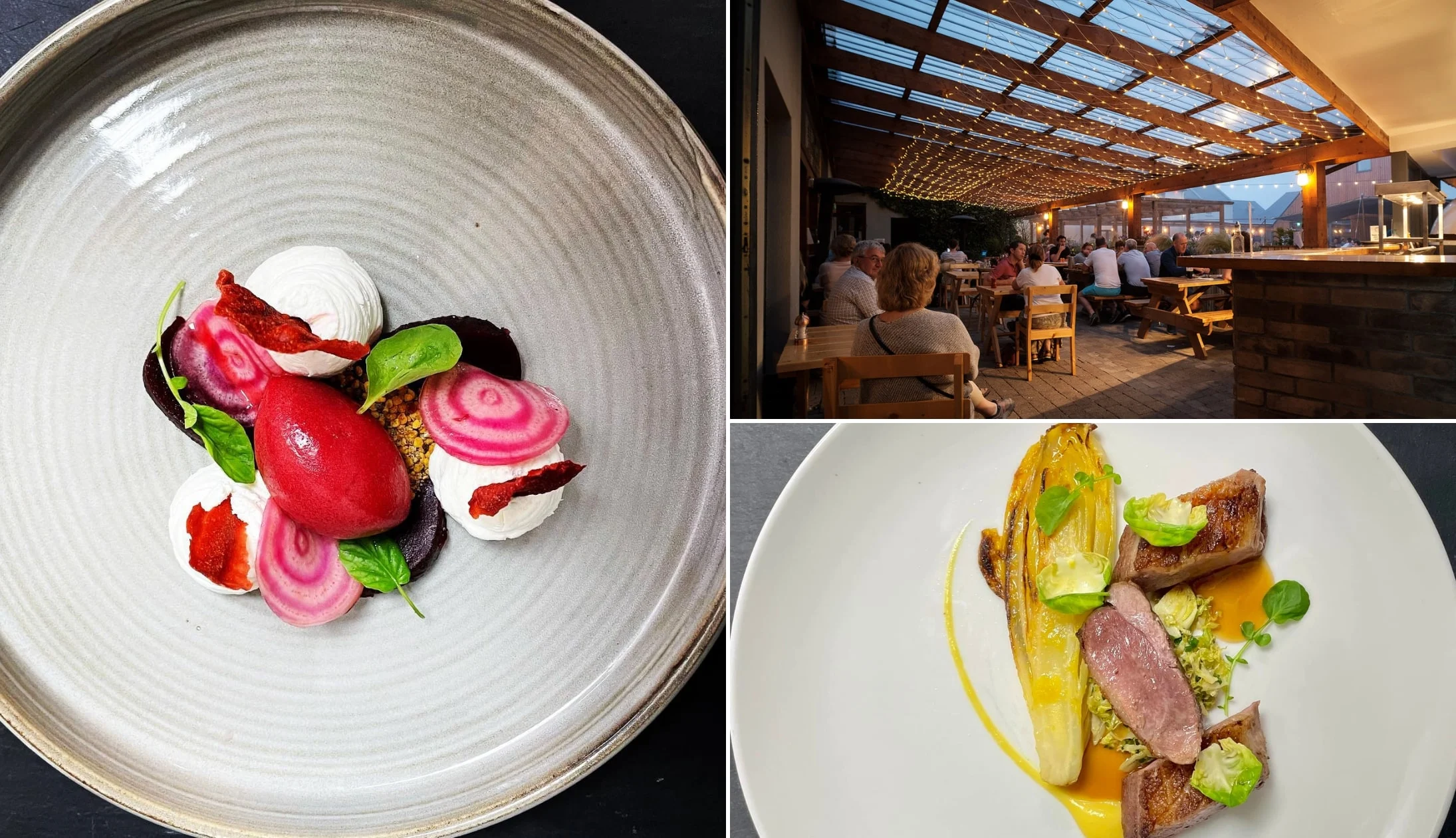
Photos via Hotel Doolin on FB
For lunch, you’ll be heading to Fitz’s Pub and Eatery, which is a part of Hotel Doolin. It’s a cosy traditional pub serving up delicious Irish food.
The Navarin-style Irish lamb stew is a huge hit, as is the sustainable all-white fish chowder. If you’re a beer drinker, make sure to try their in-house Dooliner Beer, a creamy and smooth Irish red ale.
Stop 6: The Cliffs of Moher
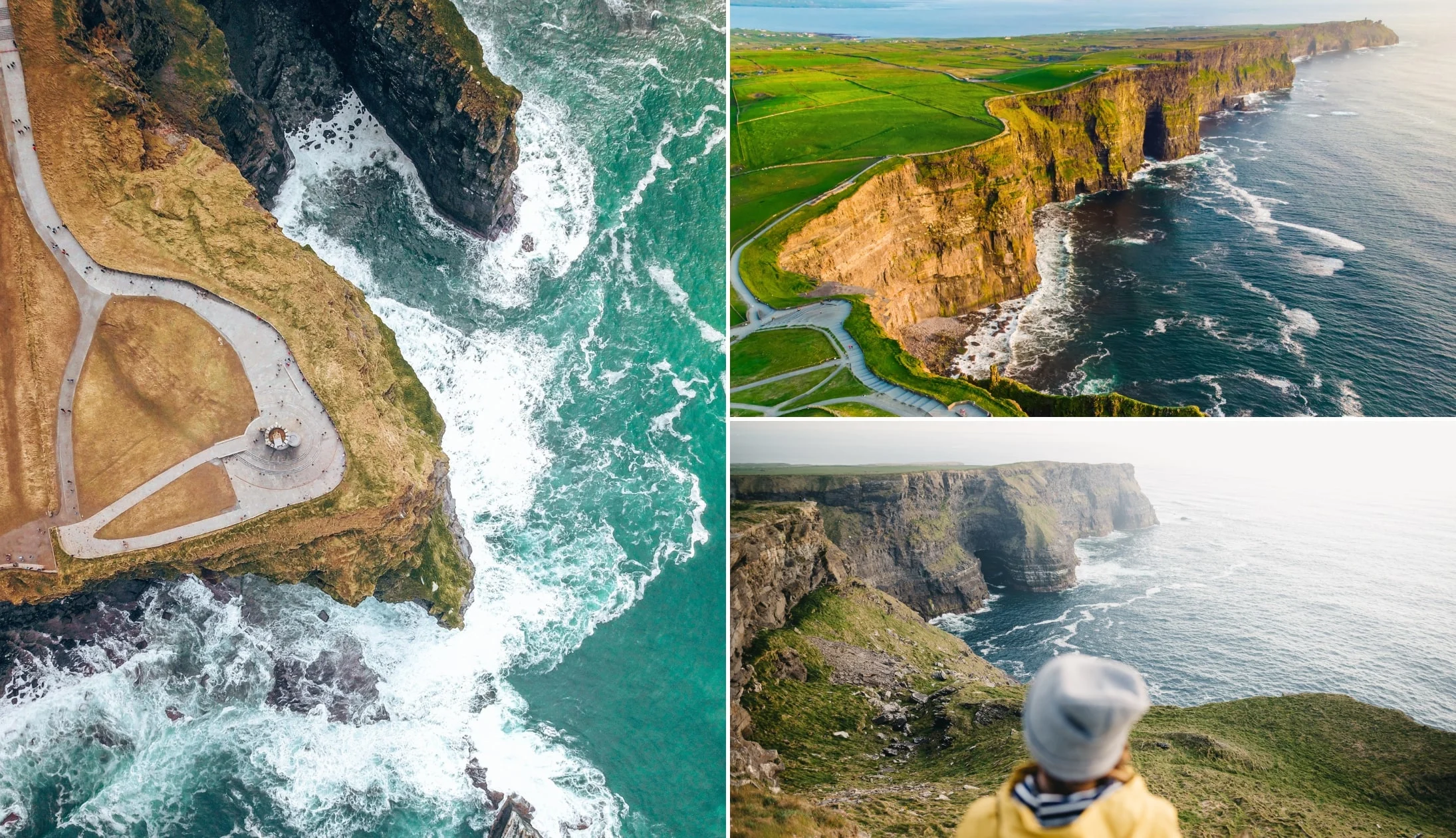
Photos via Shutterstock
Your next stop, the magnificent Cliffs of Moher, are one of the most popular tourist attractions in Ireland.
The cliffs are 15 minutes away from Doolin, with breathtaking views of the wild Atlantic, Galway Bay, and the Aran Islands.
There’s a visitor centre on-site, as well as 800 metres of paved walkways with viewing areas, and the historic O’Brien’s Tower.
Stop 7: Lisdoonvarna
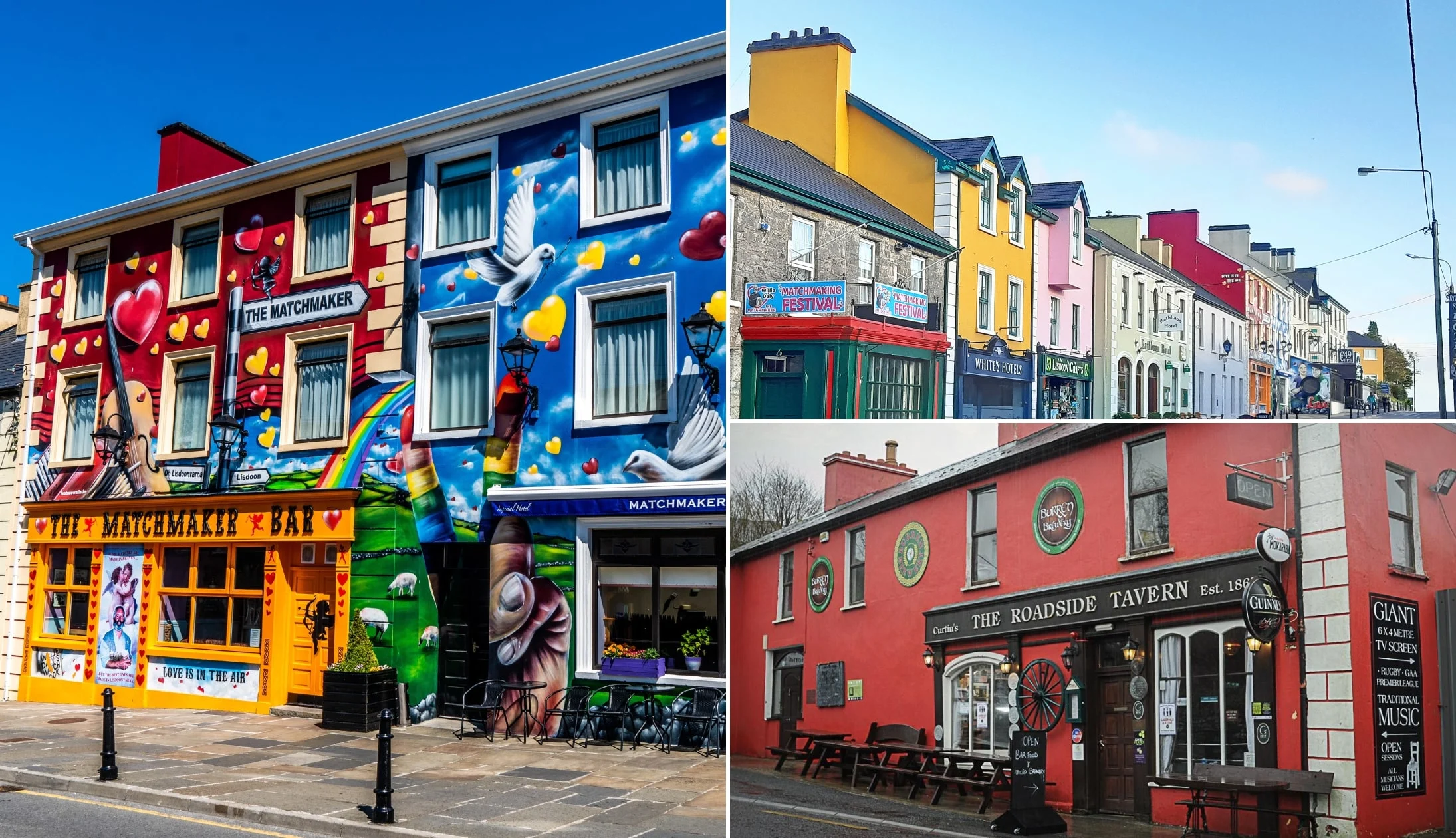
Photo left: UpSwing Mediaa. Top right: Maria Ryan Donnelly. Bottom right: Failte Ireland
Keep your eyes peeled as you pass through Lisdoonvarna, a spa town renowned for its annual matchmaking festival! The festival began in 1857 and today it attracts over 20,000 visitors from all over the globe.
Lisdoonvarna is relatively new for Irish standards (dating back to the early 19th century), but it’s still full of charm, with colourful shop fronts and traditional houses.
Stop 8: Back to Galway for the night

Photos via Blakes Bar Galway on FB
From Lisdoonvarna, it’s around one hour and 20 minutes back to Galway, so sit back and relax as you may your way back through the lovely countryside.
Our dinner recommendations
There’s some excellent restaurants in Galway – our favourites are Ard Bia, The Quay Street Kitchen, and Dela. Ard Bia is absolutely fantastic, but you need to book in advance for dinner.
The restaurant has a quirky interior and serves beautifully presented modern dishes.
The Quay Street Kitchen has a great selection of vegan and vegetarian-friendly dishes, and Dela has modern Irish cuisine on the menu.
Live music and trad bars
There’s some mighty pubs in Galway. After dinner, head out for drinks at either Tigh Neachtain or The Crane. Both are traditional pubs with a great atmosphere.
Trad music is an integral part of the city, with heaps of options to choose from. Our favourite spots are Crane Bar (mentioned above) and Tigh Chóilí.
Day 10: The Bus to Knock Airport
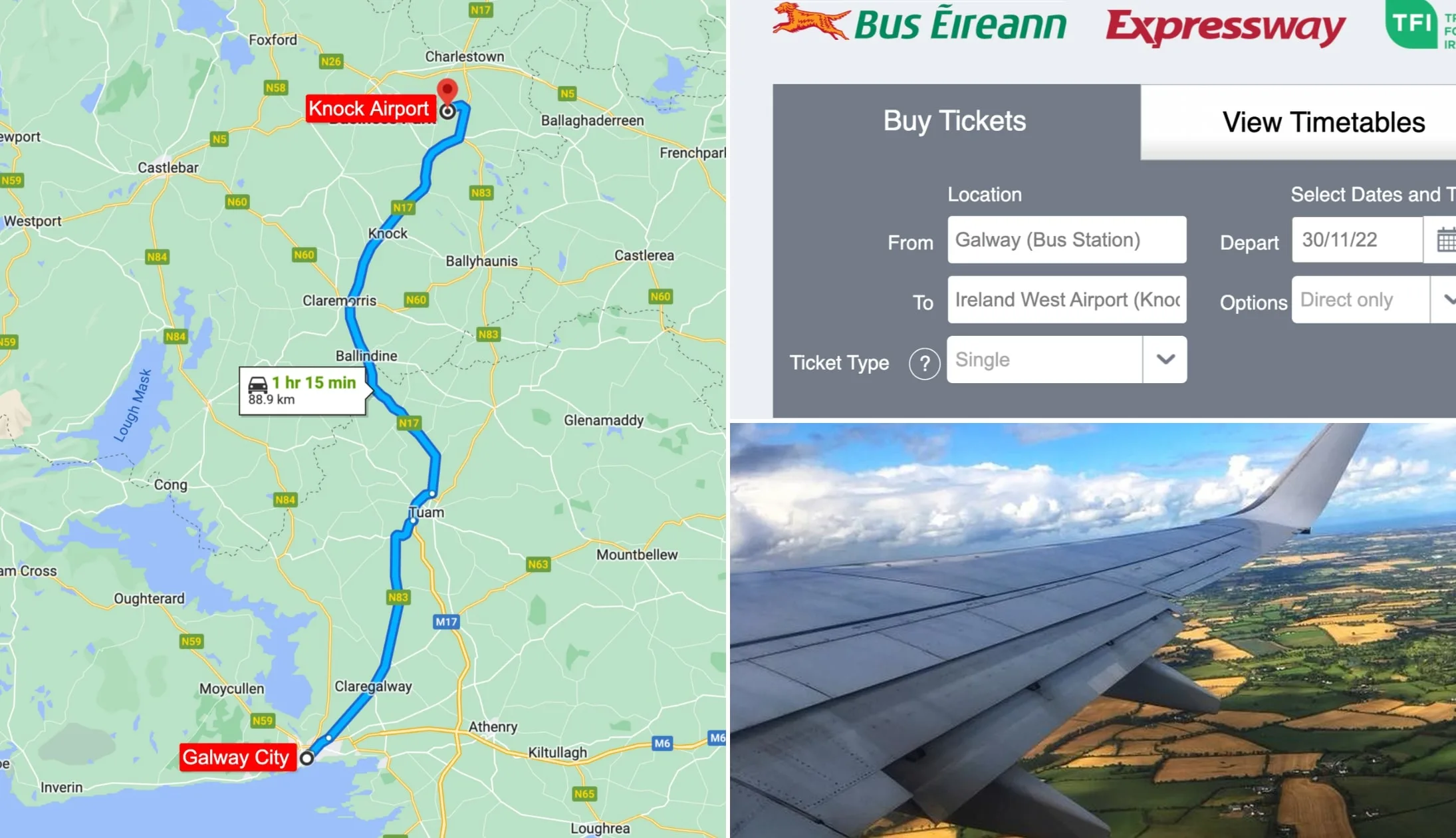
Photo left: Google Maps. Top right: Bus Eireann. Other: Shutterstock
Unfortunately, all good things come to an end, and today, you’ll be heading to Knock to catch a plane back home.
Grab some breakfast at your accommodation or nearby, and then head on out to the bus station.
You only have one option to get to knock and that’s to take a bus. There are two options
- Option 1: Bus Eireann (takes about 1.5 hours)
- Option 2: Bus Feda (takes about an hour but it only operates twice a day)
And that’s a wrap on this road trip

Photos via Shutterstock
We hope you found the above road trip guide useful. If you have any questions, ask in the comments below and we’ll do our best to help.
Or, if you’d like to browse our other Irish Road Trip itineraries, visit our Road Trip Hub – cheers!
Keith O’Hara has lived in Ireland for 35 years and has spent most of the last 10 creating what is now The Irish Road Trip guide. Over the years, the website has published thousands of meticulously researched Ireland travel guides, welcoming 30 million+ visitors along the way. In 2022, the Irish Road Trip team published the world’s largest collection of Irish Road Trip itineraries. Keith lives in Dublin with his dog Toby and finds writing in the 3rd person minus craic altogether.


